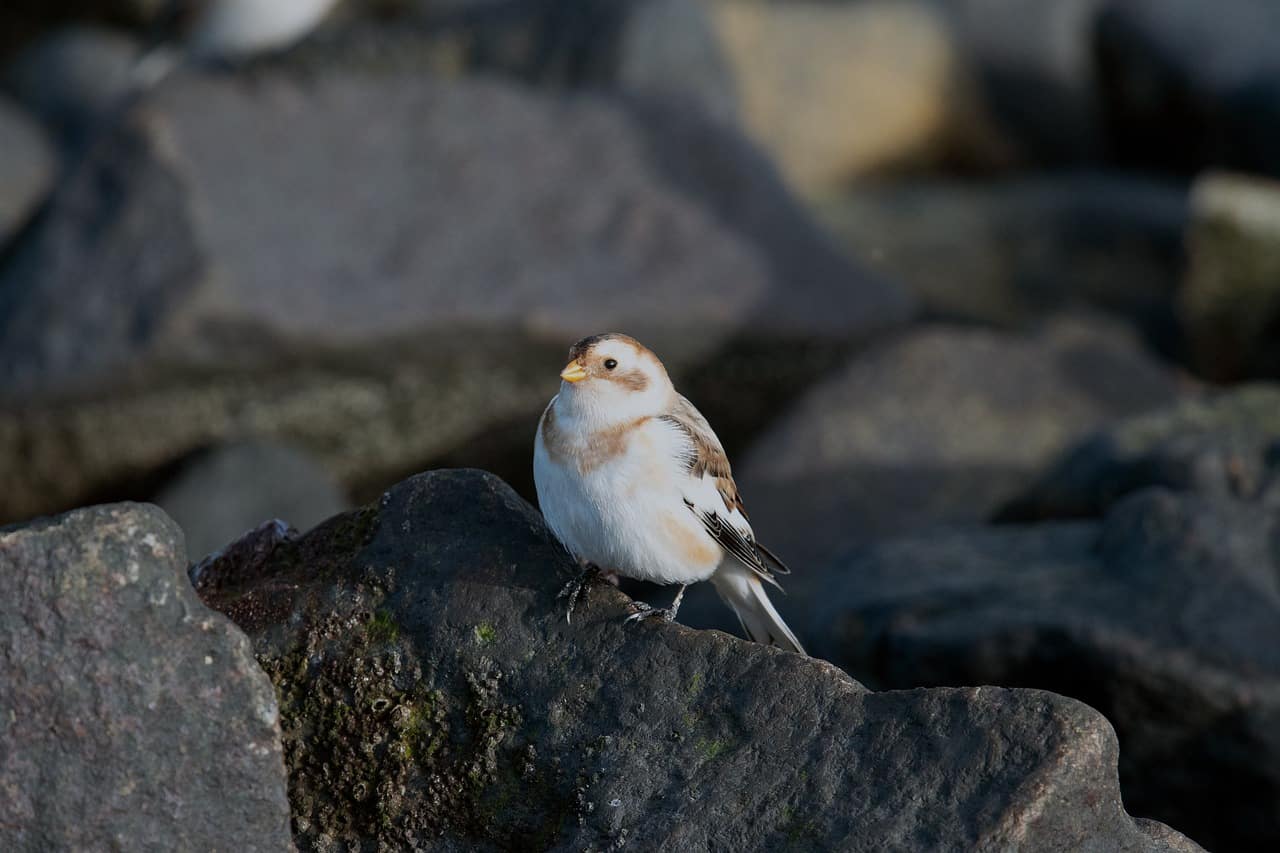Many bird species remain in Alberta, Canada for winter while others come just for the snowy season. Wouldn’t it be nice to have a guide that tells you all the birds you can expect to see in Alberta during winter? And who wouldn’t want color photos to identify the birds as well as their favorite feeder foods to entice them closer?
Look no further, everything you need to know is in this article including color photos of each Alberta winter bird for easy identification, their winter diet & habitat info, range maps to determine if they’re likely to be found in your particular area, and the winter feeder foods they love so you can entice them with for a closer look.
I’ve been backyard birdwatching in Wisconsin for more than 25 years and have seen many of the same winter birds. While winter isn’t my favorite season (especially when the temps are below zero and the icy winds howl) I’m thankful I have the winter birds to look forward to. Somehow, winter birds make the season more bearable.
Alberta Winter Bird List
No matter where you live in Alberta, Canada you’re sure to enjoy plenty of wild birds during the chilliest season of the year. In fact, there are more than 40 species of birds you can expect to see. Below are all bird species found in Alberta during winter.
American Robin
American Three-Toed Woodpecker
American Tree Sparrow
Bald Eagle
Barred Owl
Black-Capped Chickadee
Blue Jay
Brown Creeper
Canada Goose
Canada Jay (Gray Jay)
Cedar Waxwing
Common Redpoll
Dark-Eyed Junco
Downy Woodpecker
Eurasian Collared-Dove
European Starling
Golden-Crowned Kinglet
Great Blue Heron
Great Gray Owl
Great Horned Owl
Gyrfalcon
Hairy Woodpecker
Hoary Redpoll
Horned Lark
House Sparrow
Mallard
Northern Flicker
Northern Goshawk
Northern Hawk Owl
Northern Mockingbird
Northern Shrike
Pileated Woodpecker
Pine Grosbeak
Pine Siskin
Red Crossbill
Red-Breasted Nuthatch
Rock Pigeon
Rough-Legged Hawk
Snow Bunting
Snowy Owl
Song Sparrow
White-Breasted Nuthatch
White-Winged Crossbill
Wild Turkey
Alberta Winter Bird Identification Guide
A list of winter birds is only useful if you can identify them out your back window. No worries! Below is the complete list of Alberta winter birds along with color photos & appearance descriptions of the male vs female of each species, range maps, diet & feeder food information as well as detailed habitat explanations. Enjoy!
American Robin in Winter
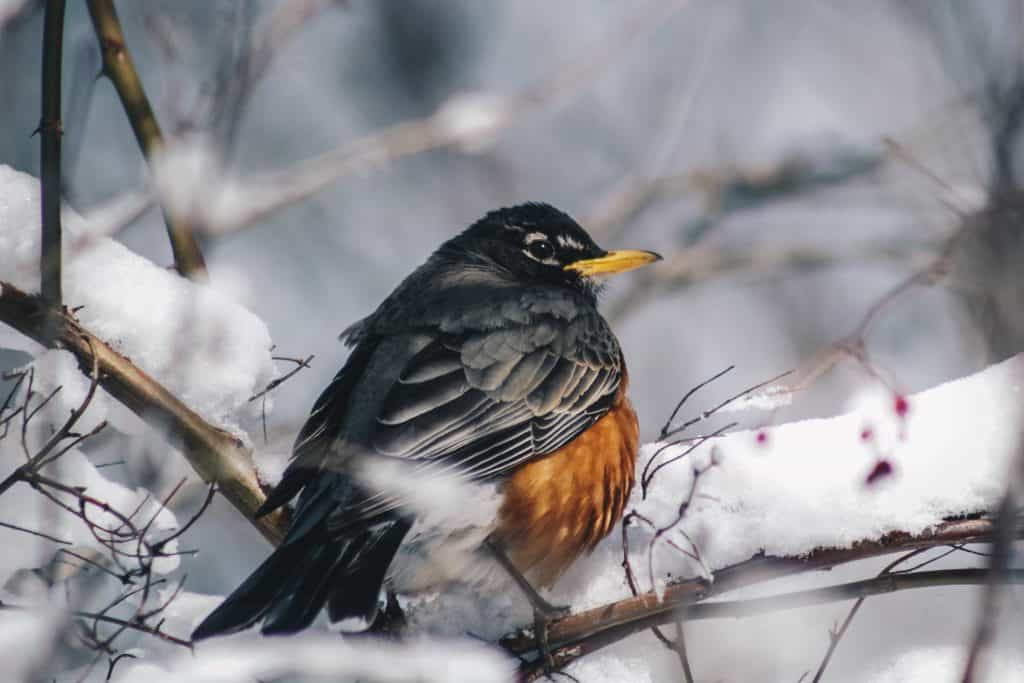
Appearance: Medium-size bird about 10″ long, gray/brown upper, brown/orange underparts, yellow beak, white chin, white surrounding eyes. orange beak. The Female has a lighter head and underparts.
Winter diet: In winter, robins eat berries and other fruits left on shrubs, trees, and vines.
Feeder food: Robins do not visit feeders.
Habitat: In wintertime, American robins are common and pervasive throughout the US, far southern Alaska and southwest Canada. Found in fields, parks, wooded and forested areas, mountains, and backyards.
Range Map
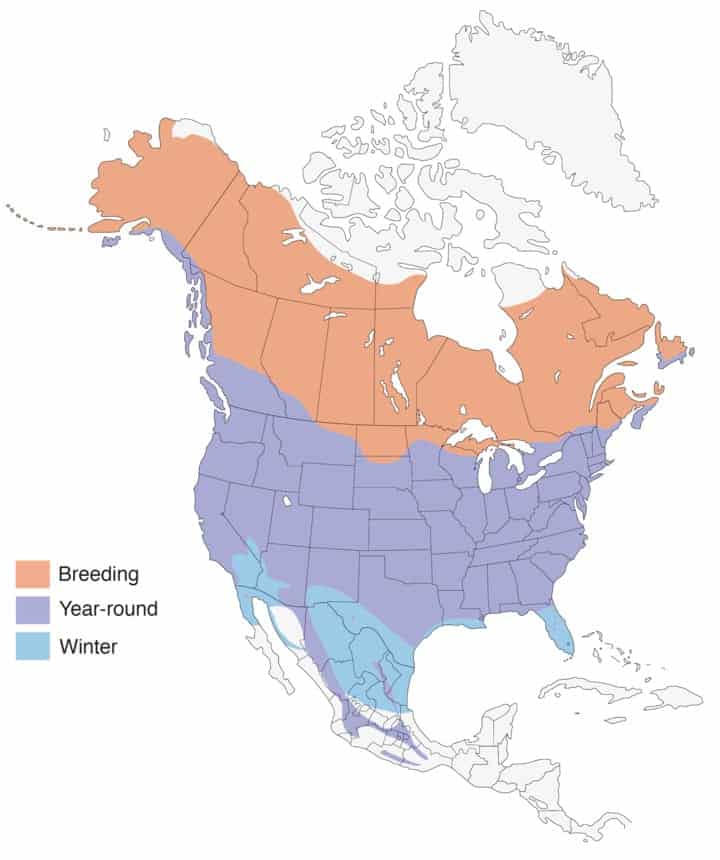
American Three-Toed Woodpecker Winter
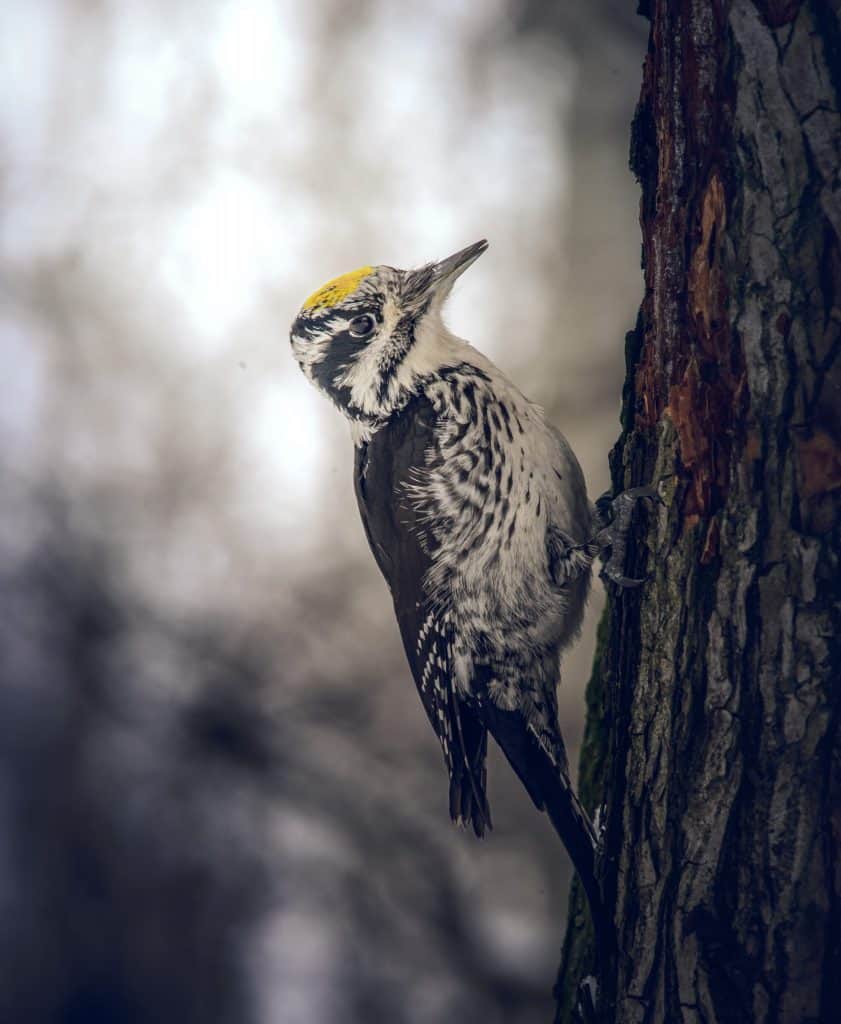
Appearance: The American three-toed woodpecker is a medium-sized bird about 8-9″ long. They’re mostly black with white spots on their wings and belly. The throat is white, white stripe behind each eye and across the bill from one side of the head to the other, and an unmistakable yellow patch on the crown. And of course, they’re equipped with three toes instead of the typical 4 toes. The bill is relatively long and pointed, although sometimes feather tuffs near the base of the bill give the appearance of a shorter bill.
Females are similar except instead of a yellow crown theirs is black and white specked. Also, her belly is more white than black and the females are about 10% smaller than males.
Juveniles look a lot like females but have shorter bills and a bit duller plumage overall.
Winter diet: Insects they’re able to dig up from beneath tree bark and cambium (layer of the tree beneath the bark).
Winter feeder food: Suet.
Winter habitat: Coniferous forests (spruces and pines), as well as mature hardwood forests, and swamps. Fond of burn areas (3+ years after the burn), and flooded forests which are abundant in insects.
Migration: American three-toed woodpeckers are not migrators. They make their year-round home in non-coastal areas throughout Canada, as well as Alaska, Washington, Oregon, Idaho, Montana, Wyoming, Utah, and Colorado. Although they’re scarcely found in the following states, you still have a chance of spotting one: Minnesota, Arizona, and New Mexico.
Range Map
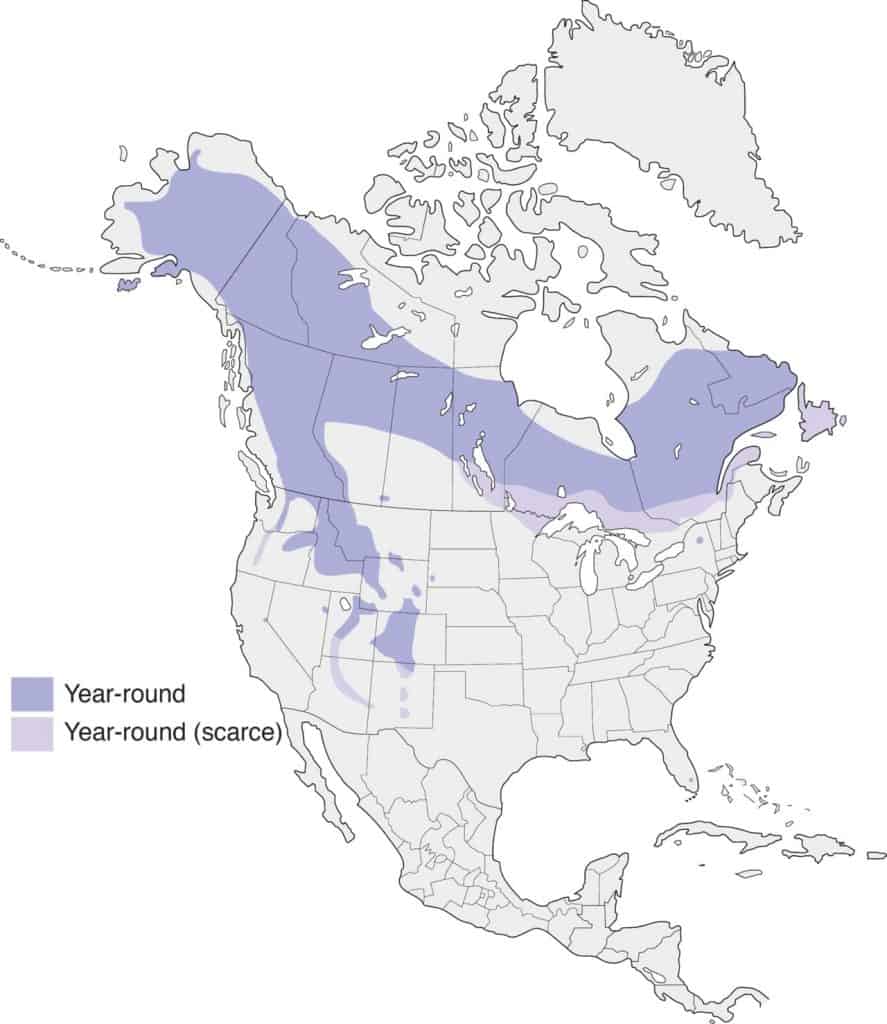
American Tree Sparrow in Winter
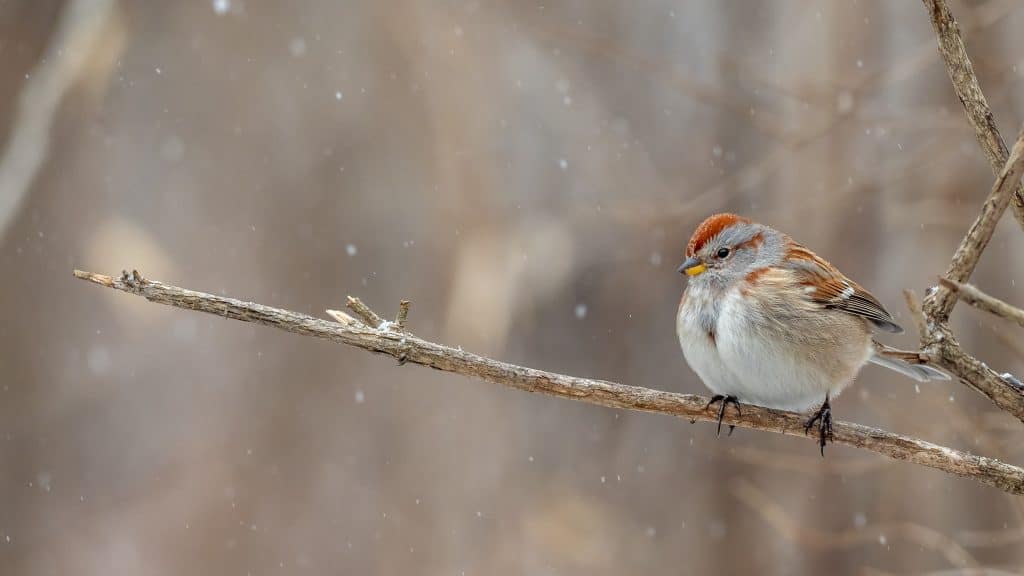
Appearance: The American tree sparrow is a small bird about 6″ long. It’s brown with a tan breast and a rust-colored crown. They have a single black spot in the center of the chest, a dark upper bill, and a yellow lower bill. Eyes are accented with gray eyebrows. The female looks the same.
Winter diet: Seeds.
Winter feeder food: Black-oil sunflower seeds, hulled sunflower seeds, nyjer, cracked corn, and peanut hearts.
Winter habitat: American tree sparrows migrate south for the winter. They prefer wooded areas, especially on the edges.
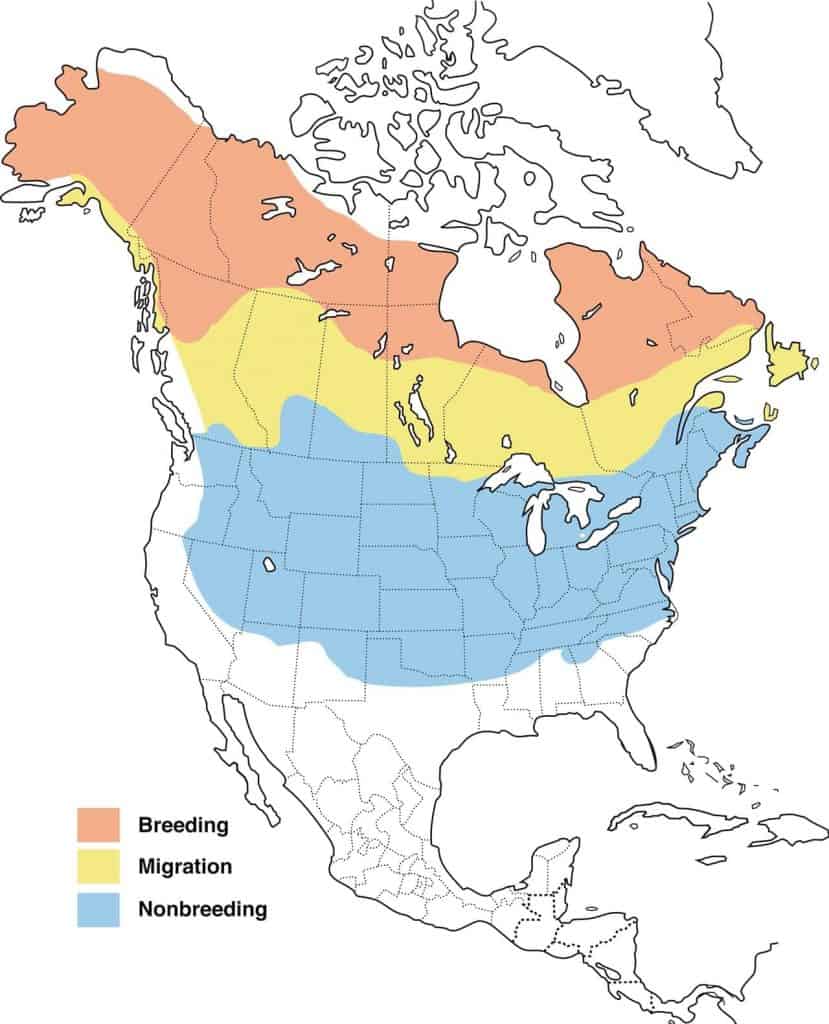
Bald Eagle in Winter
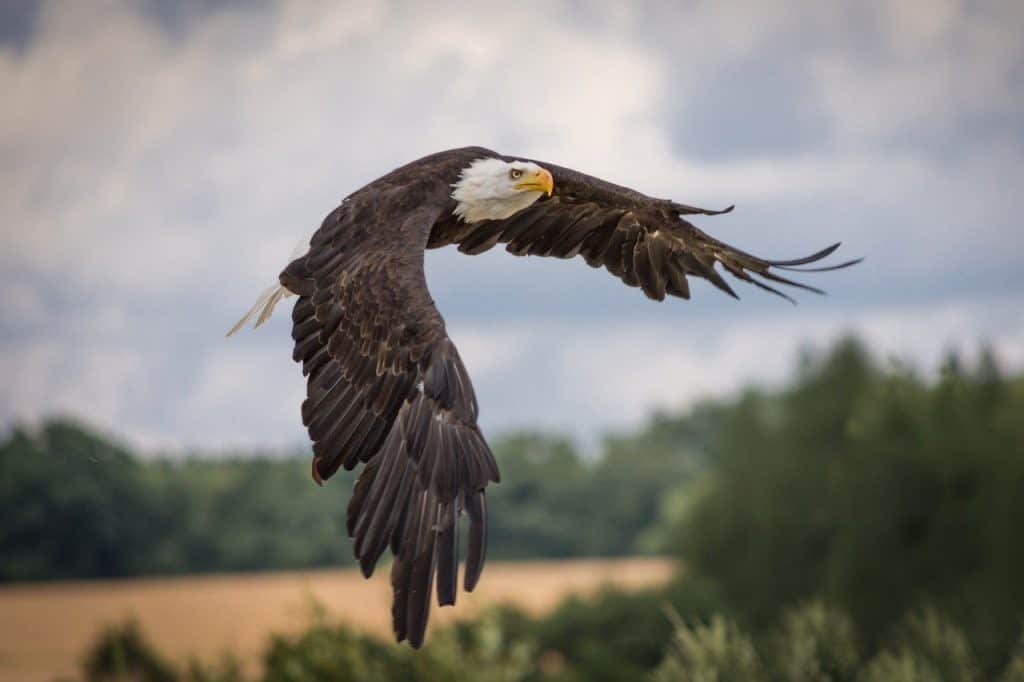
Appearance: The bald eagle is the United State’s national bird. It’s enormous at about 30-38″ in length with an equally impressive wingspan. They’re brown with a white head and tail, gold bill, and yellow eyes. Males and females look the same.
Winter Diet: Bald eagles are opportunistic eaters but prefer fish. They’ll also eat small mammals, other birds, carrion (dead animals), and anything they can retrieve from the garbage.
Winter feeder food: Bald eagles do not visit feeders (Thank goodness!)
Winter habitat: During winter, bald eagles expand their range to include the entire US, and western British Columbia. They prefer to be near open lakes, rivers, marshes, and coasts so they can fish.
Range Map
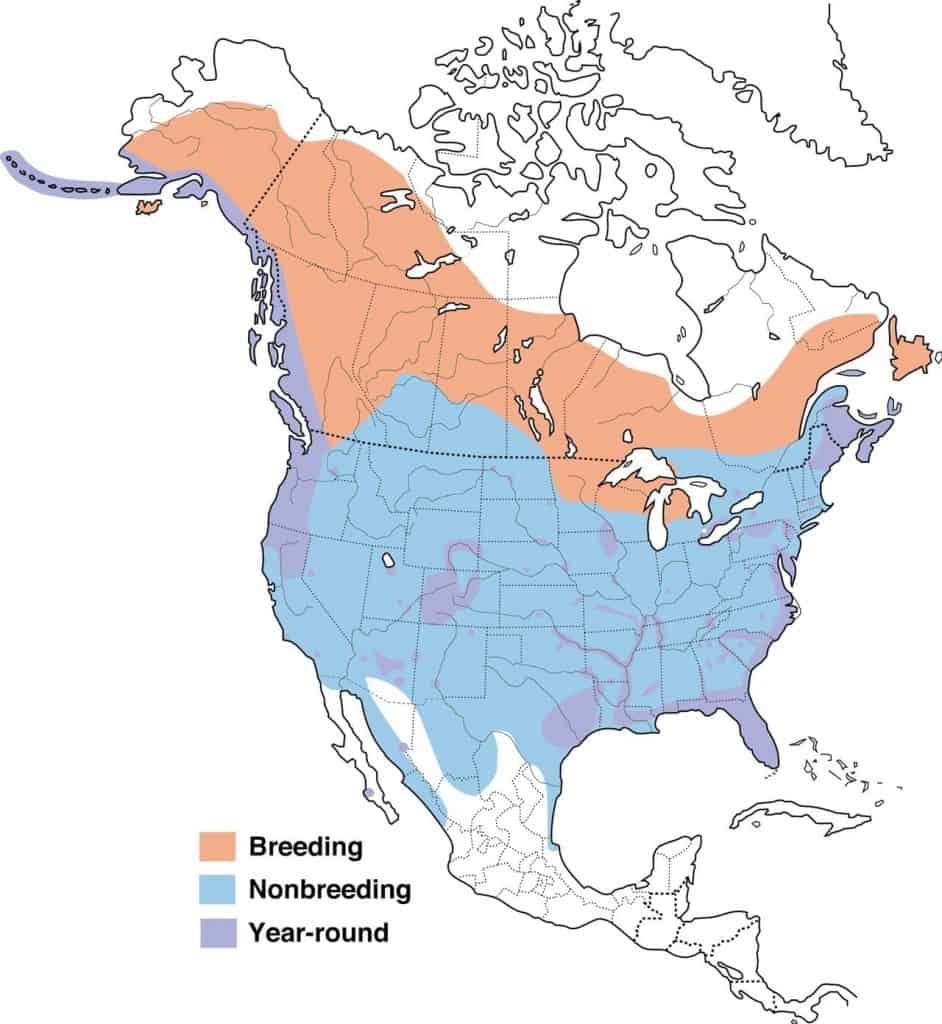
Barred Owl in Winter
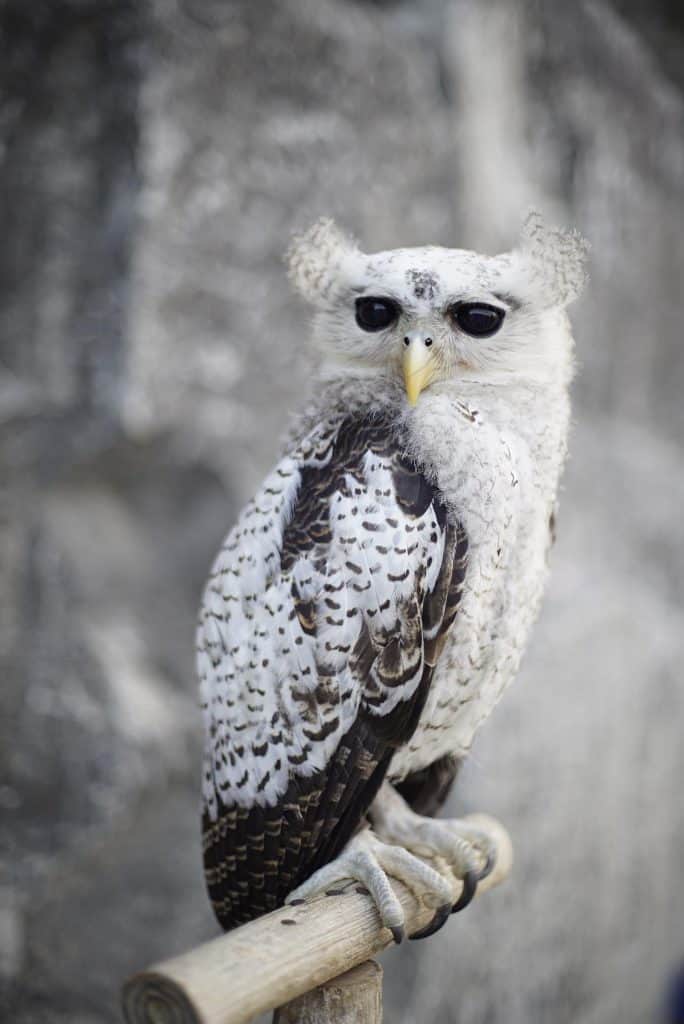
Appearance: Barred owls are large birds about 21″ long. They have large round faces with dark eyes and yellow bills. They’re primarily brown with white spots on the upperparts and tan underneath with dark brown streaks.
Winter diet: In winter, barred owls eat small mammals, other birds. If they can find them, they’ll also dine on reptiles, fish, and large insects.
Winter feeder food: Barred owls do not visit feeders.
Winter habitat: Barred owls do not migrate. They remain year round in the eastern half of the US, the Pacific Northwest coast, as well as southern portions of Canada. They prefer mature forests, especially along side water sources that don’t freeze like rivers – especially in the southern part of their range.
Range Map
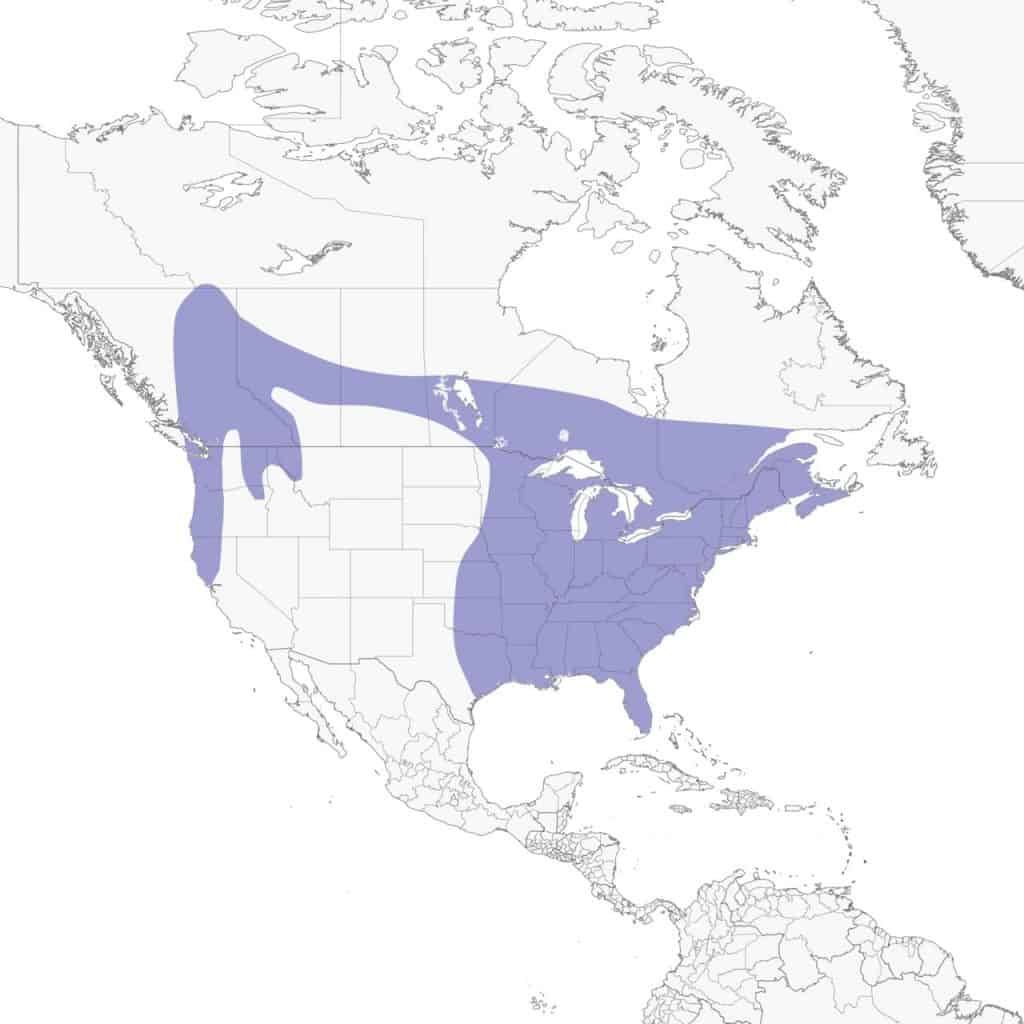
Black-Capped Chickadee in Winter
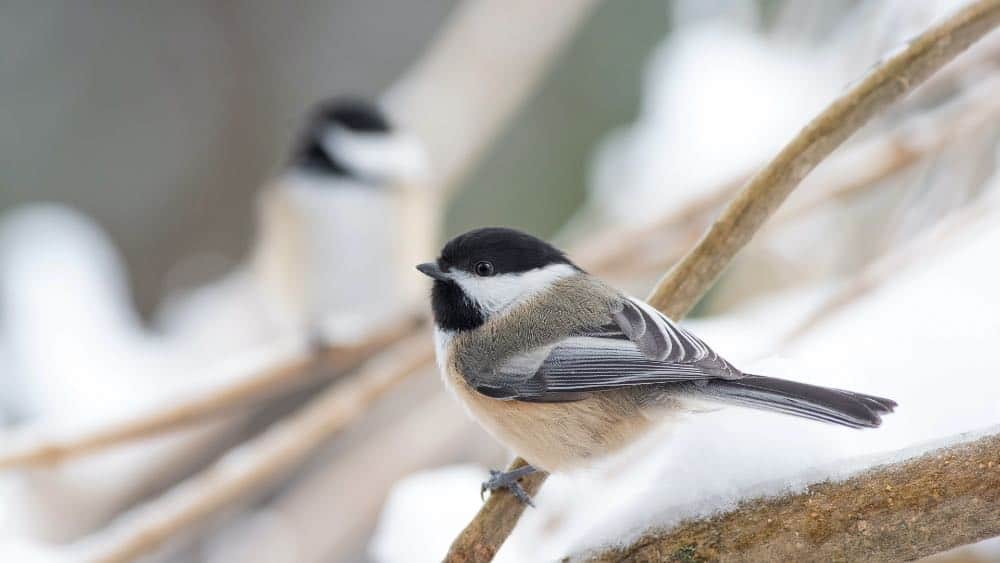
Appearance: Black-capped chickadees are small birds about 5 1/4″ long. They have a black cap – as well as a black throat and cheek. They have white breasts and bellies, and the body and wings are a gray-olive color with edges of white. During the winter their belly changes to a buffer tan.
Diet: Seeds, small fruits, and berries that remain on the trees, shrubs, and vines.
Feeder Food: Black-oil sunflower & safflower seeds (They peck a hole in the shell to get at the tiny seed bits inside), suet, peanut butter, and hulled peanuts.
Habitat: Black-capped chickadees are year-round birds found throughout the northern half of the US as well as most of Canada. They prefer the edges of forests and open wooded areas – including your backyard or even tree-lined parks in the city. They will also hang out in shrubs and willow thickets. Trees are still important for this bird because they are cavity nesters and offer a much-needed place to roost in winter.
Range Map
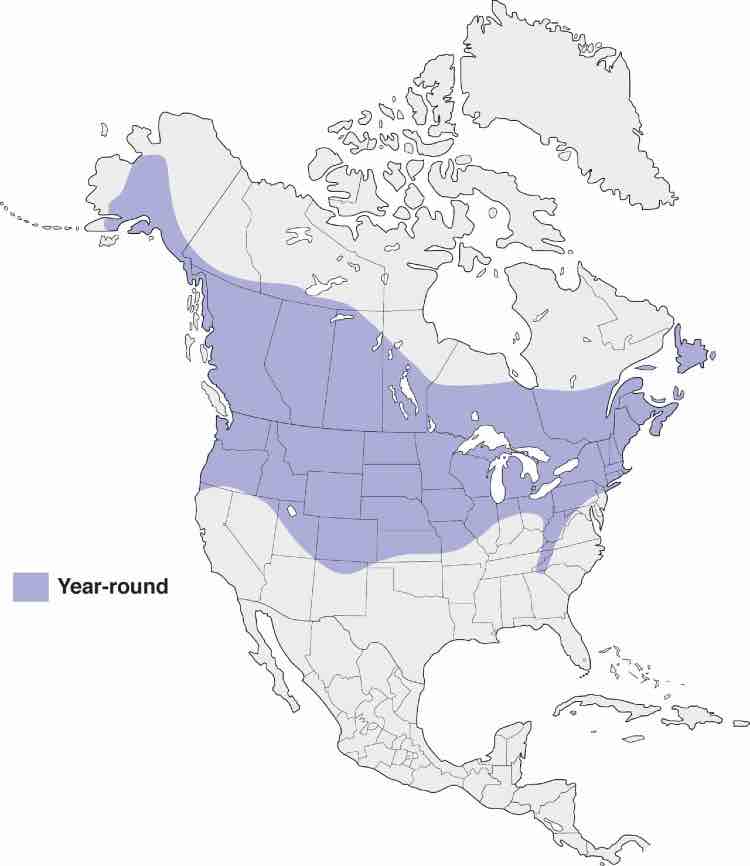
Blue Jay in Winter
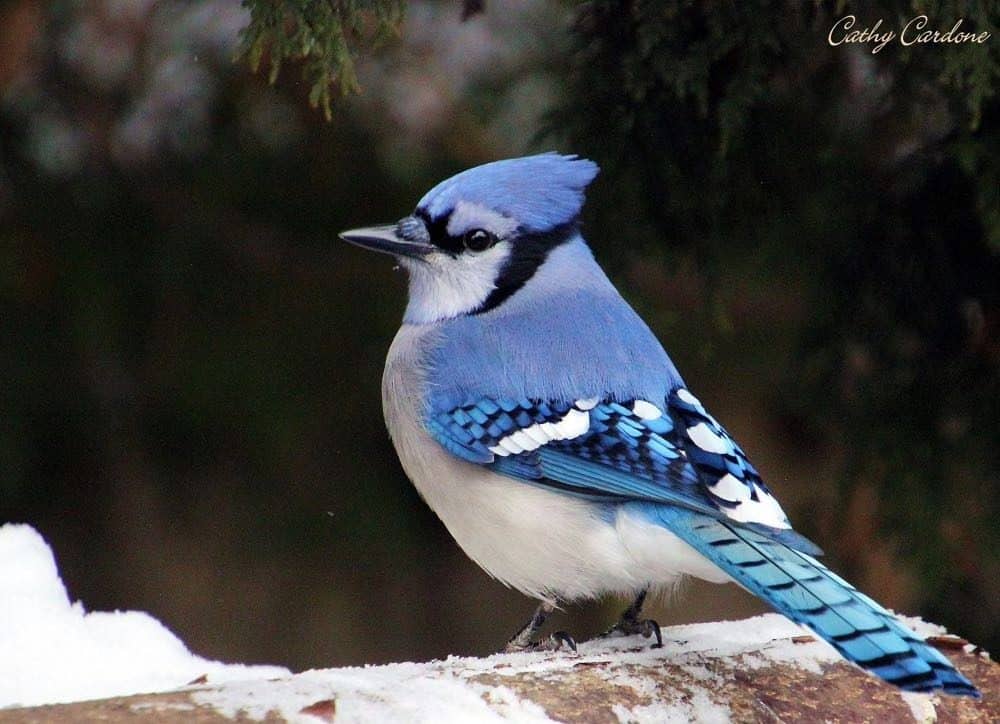
Appearance: Large bird 12″ long, medium blue & white body, blue crest (which he flattens at will), gray belly and white face. White & blue wings with black spots. Female look the same.
Diet: Fruit and seeds that remain on the trees, shrubs, and vines as well as nuts.
Feeder food: Whole peanuts, sunflower seeds, and cracked corn.
Habitat: Forested areas with mixed trees types. Also common in suburbs and urban areas.
Range Map
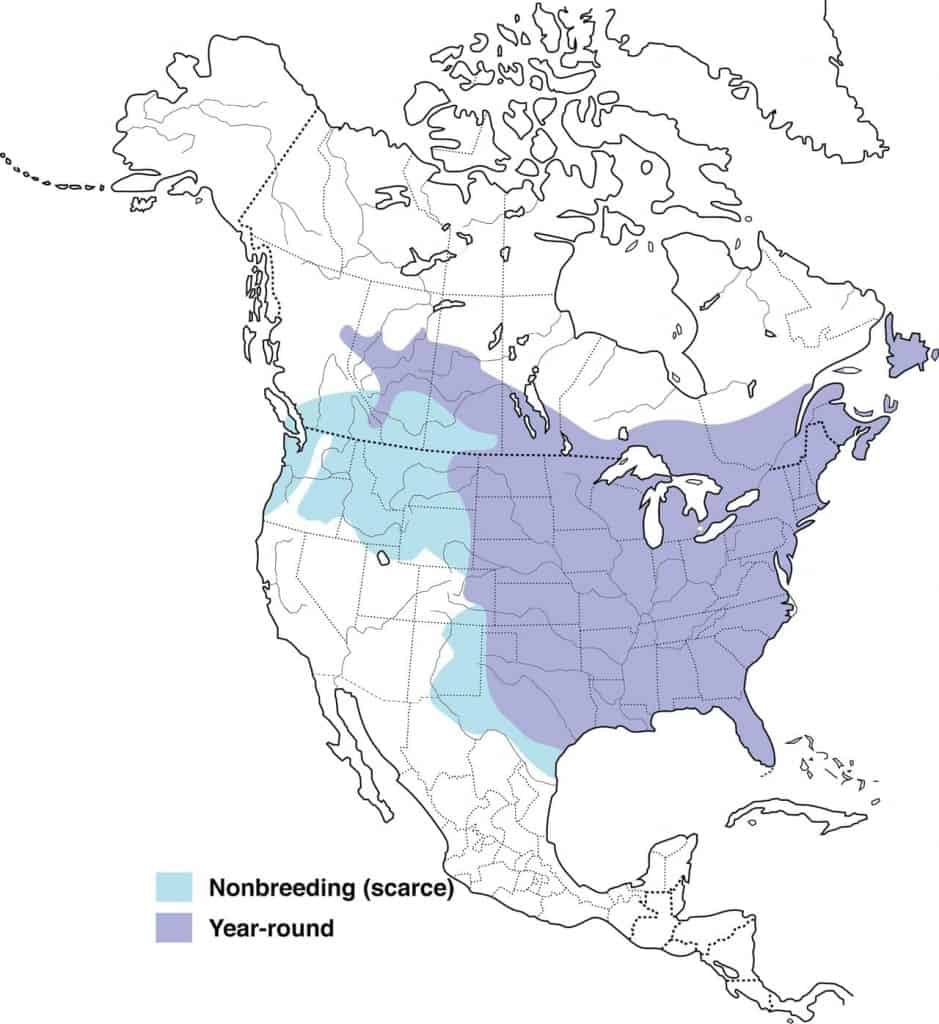
Brown Creeper in Winter
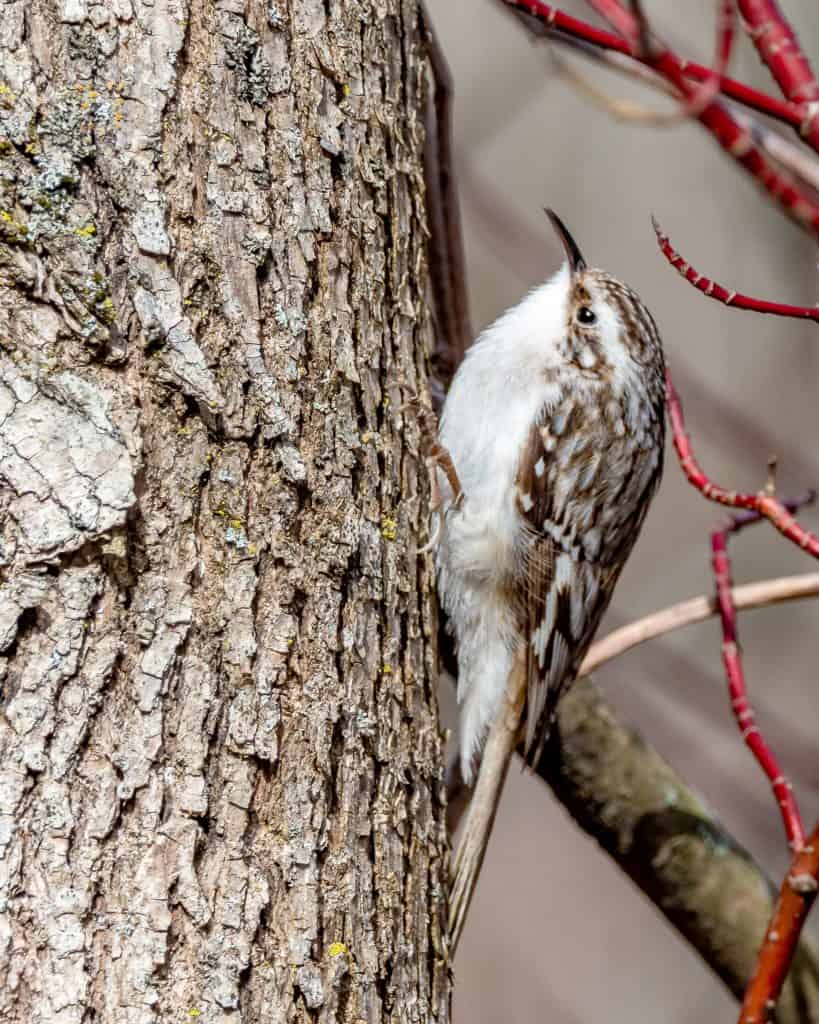
Appearance: The brown creeper is a small bird about 5″ long. They have a brown body with a white belly, long tail, and thin curved bill. They have a white streak above each eye. The female looks the same.
Winter diet: Insects hibernating beneath the bark, nuts, and seeds.
Winter feeder food: Hulled sunflower seeds, suet, and hulled peanuts.
Winter habitat: While many brown creepers remain in their year round range, some head south for the winter. As a result there are brown creepers found in every state of the US and Canada during winter. They prefer to be in forested areas.
Range Map
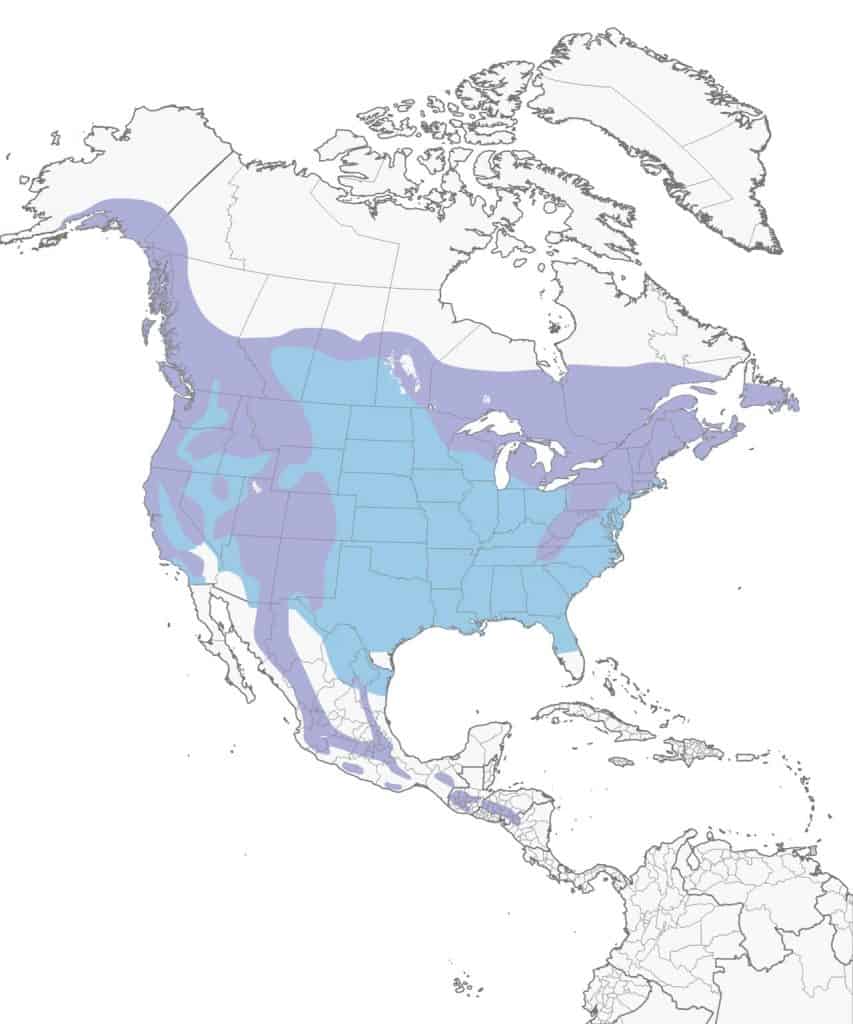
Canada Goose in Winter
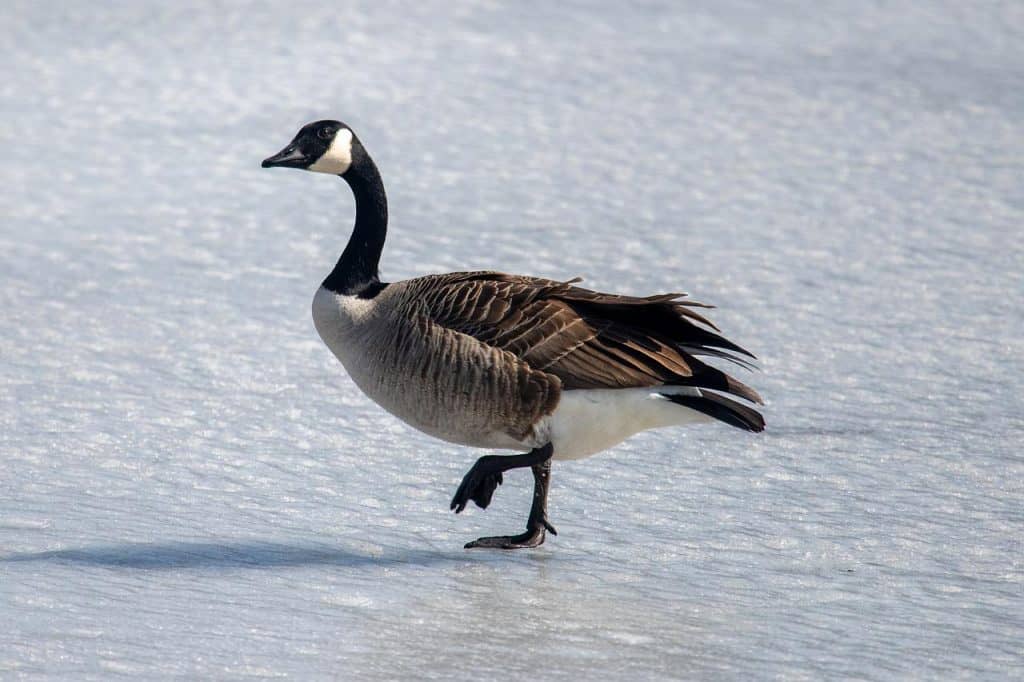
Appearance: The Canada goose is a large bird about 30-43″ long with a long black neck and a black head with a white “chin strap”. The body is brown and tan-white underneath.
Winter diet: Grasses and grains.
Winter feeder food: Canadian geese do not visit feeders.
Winter habitat: Many Canadian geese are year-round birds in the northern half of the US while a fair amount of them migrate south for the winter taking up seasonal residence throughout the southern half of the US and a bit into northern Mexico. They prefer suburban areas including parks, golf courses, and reservoirs.
Range Map
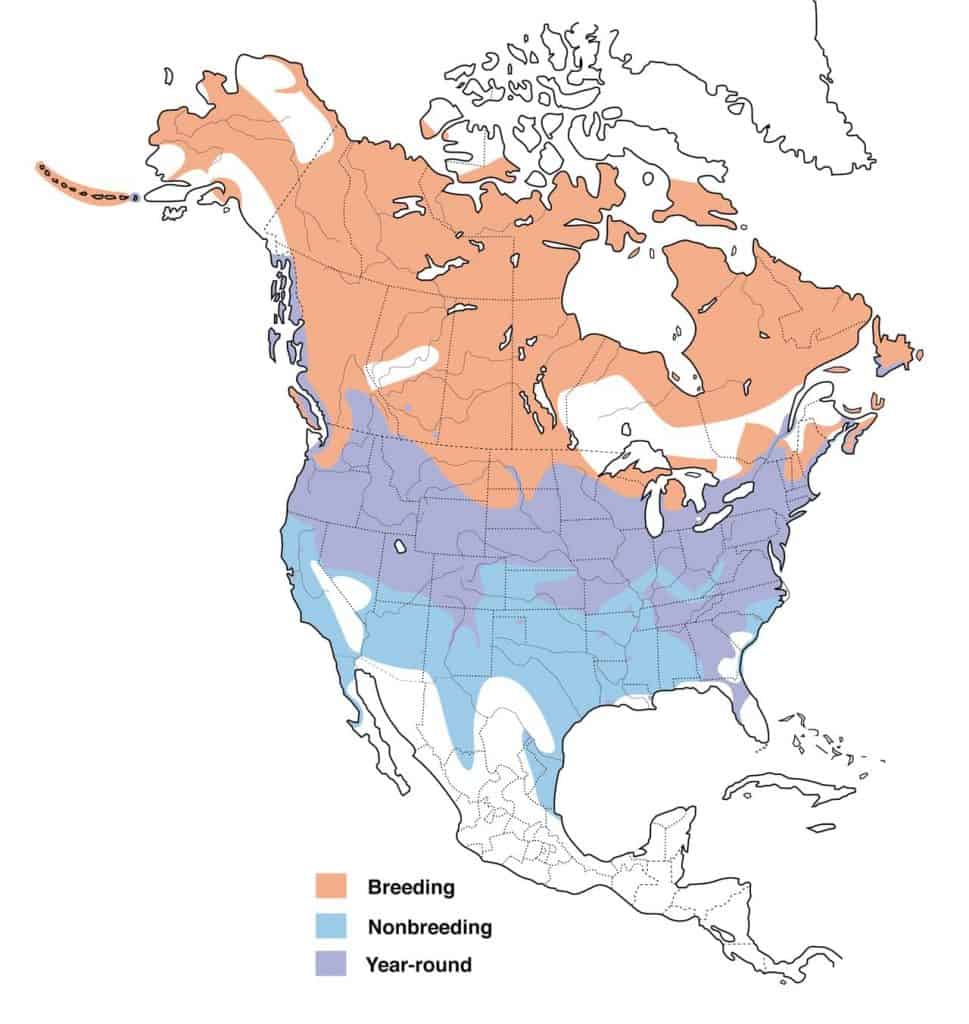
Canada Jay (Gray Jay) in Winter
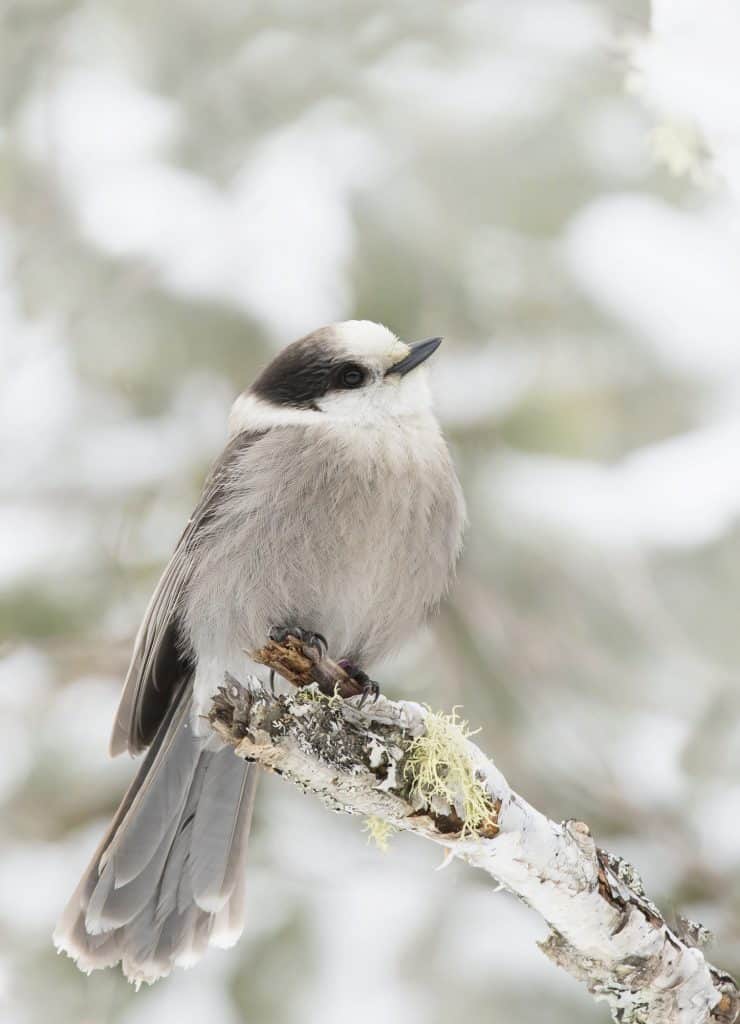
Appearance: The Canada jay often (formerly known as the Gray jay), is a large bird about 11 1/2″ long. It’s gray all over with black on the back of its neck, a white chest, a short bill, and a dark eye. Also sports a white patch on his forehead. The female is the same as the male.
Winter diet: Insects, seeds, fruit.
Winter feeder food: Any kind of bird seed, peanuts, and suet.
Winter habitat: Canada jays spend all four seasons in their year-round range in Canada, Alaska, and a few northern US states including Washington, Idaho, Montana, Minnesota, Wisconsin, Michigan, as well as Wyoming and Colorado. They’re commonly found in wooded areas.
Range Map
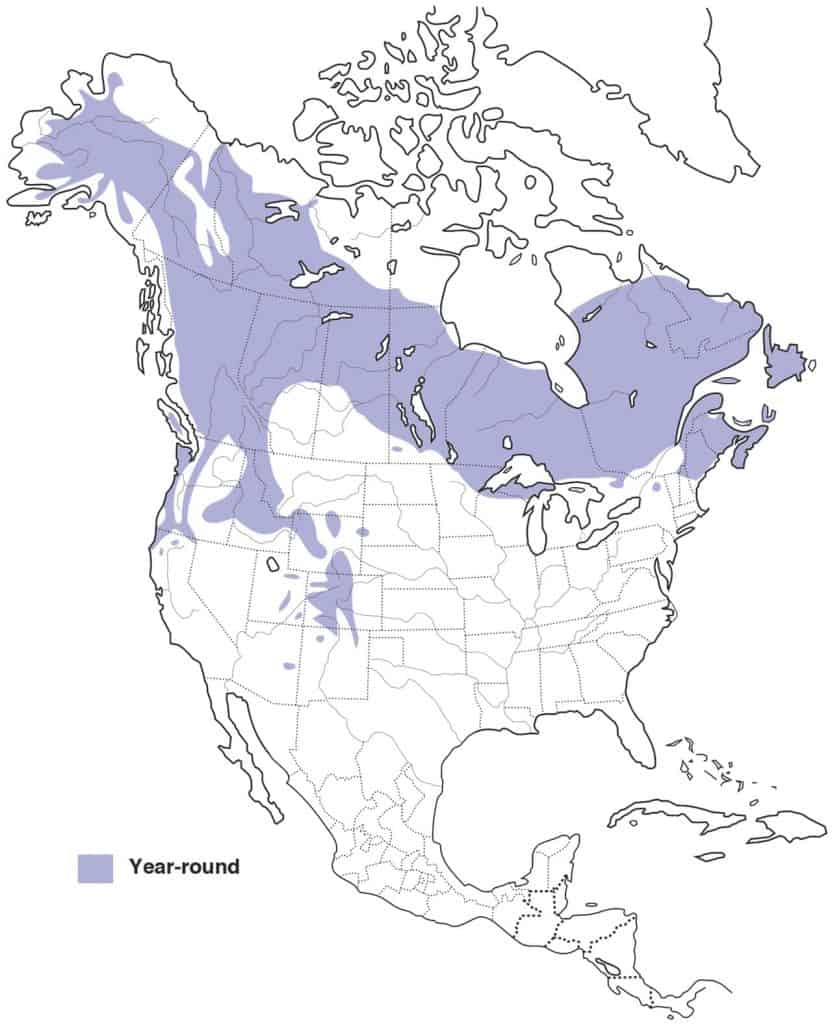
Cedar Waxwing in Winter
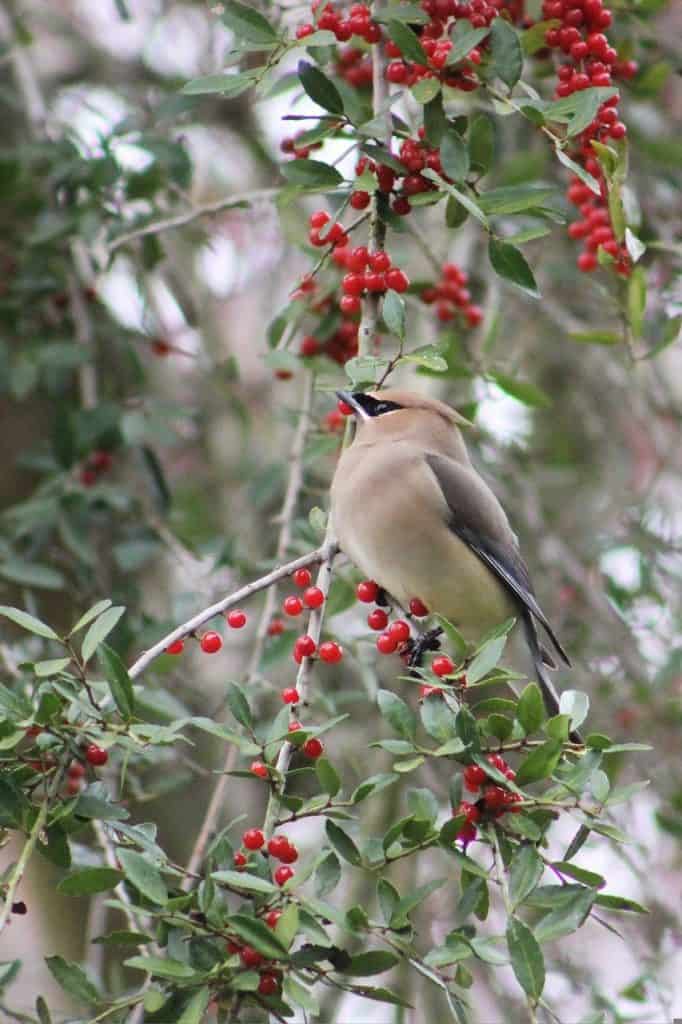
Appearance: The cedar waxwing is about 7 1/4″ long, primarily light brown with a silky crest of the same color, yellow belly, a bright yellow tip on the tail, varying shades of brown underneath, and a touch of red at the tip of the upper wings. The beak is black, short, and pointy. Male and female adults look pretty much the same with one very subtle difference – the black on the male’s chin encompasses a slightly larger area than the female
Winter diet: Fruit that still remains on the branches and vines – especially cedar berries.
Winter feeder food: Fruit (especially oranges)
Winter habitat: Some cedar waxwings live year-round in the northern part of the US/southern part of Canada all the way from the west to the east coast while others migrate to the southern US states and Mexico for winter. They prefer open forests, orchards, and wooded residential areas, especially near berry bushes.
Range Map
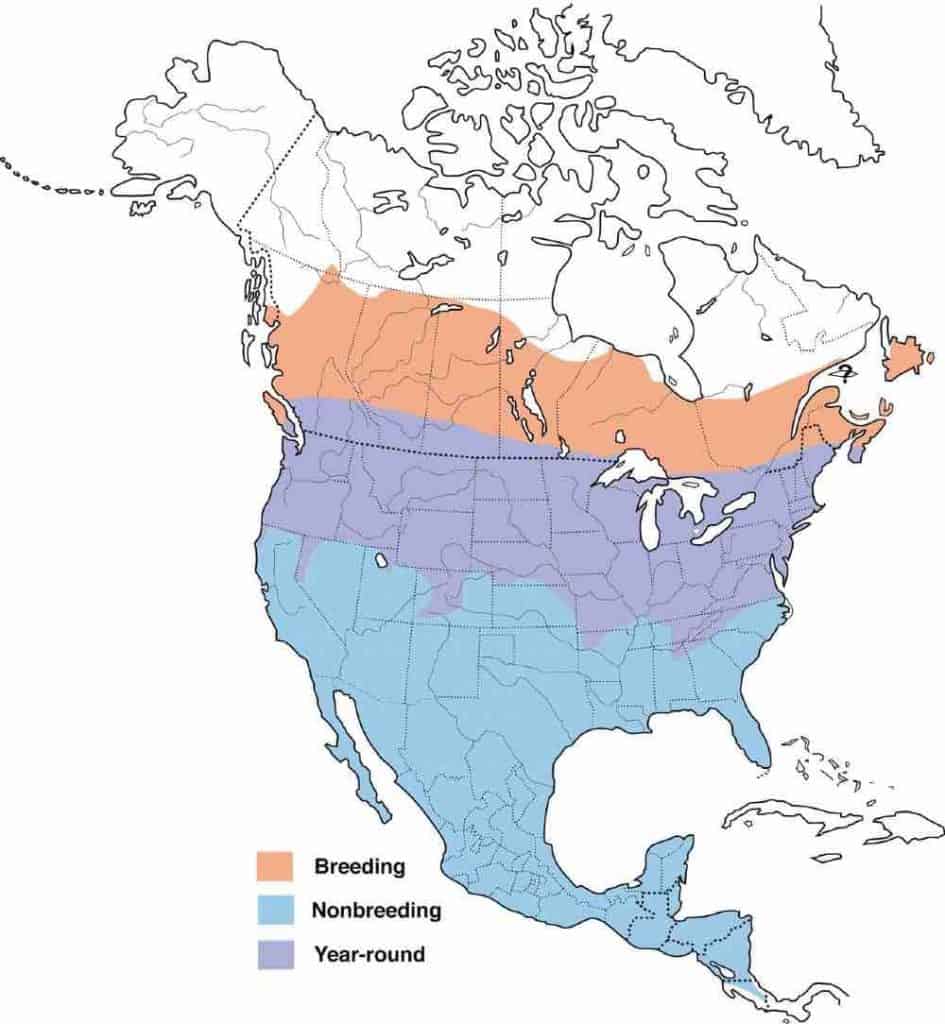
Common Redpoll in Winter
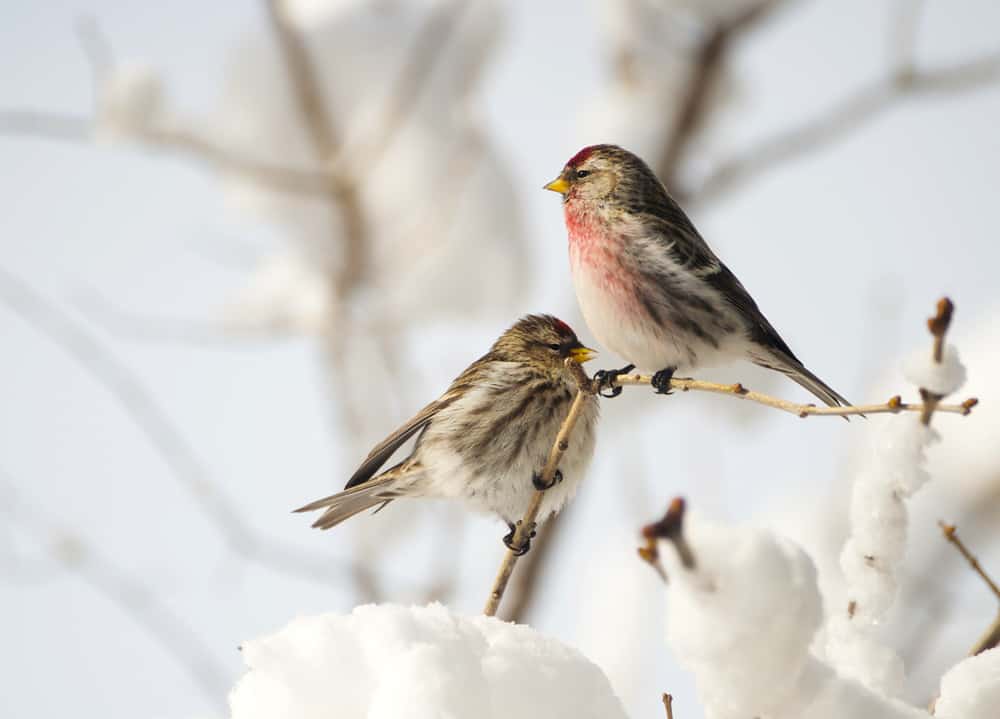
Appearance: Commonly known as the “winter finch”, the common redpoll is a small bird about 5″ long. It’s a heavily streaked bird with a bright red crown, a black spot beneath the chin, and raspberry splotch on its chest. In winter the breast becomes much redder/pink. The female is similar except without the raspberry chest and in winter adopts whiter underparts.
Winter diet: Seeds mostly. In winter flocks, they’ll feed on the ground or in seed-bearing trees
Winter feeder food: Black-oil sunflower seed, hulled sunflower seed, and nyjer.
Winter habitat: In winter, most common redpoll leave their breeding area of northern Canada and head south – as far south as the US states of Washington, Minnesota, Michigan, Wisconsin, Michigan, and New York. Yet many remain in their year-round location in northern Quebec, Newfoundland, the Yukon territory, and Alaska. A few may show up even further south but those instances are infrequent. They prefer open areas lined with trees.
Range Map
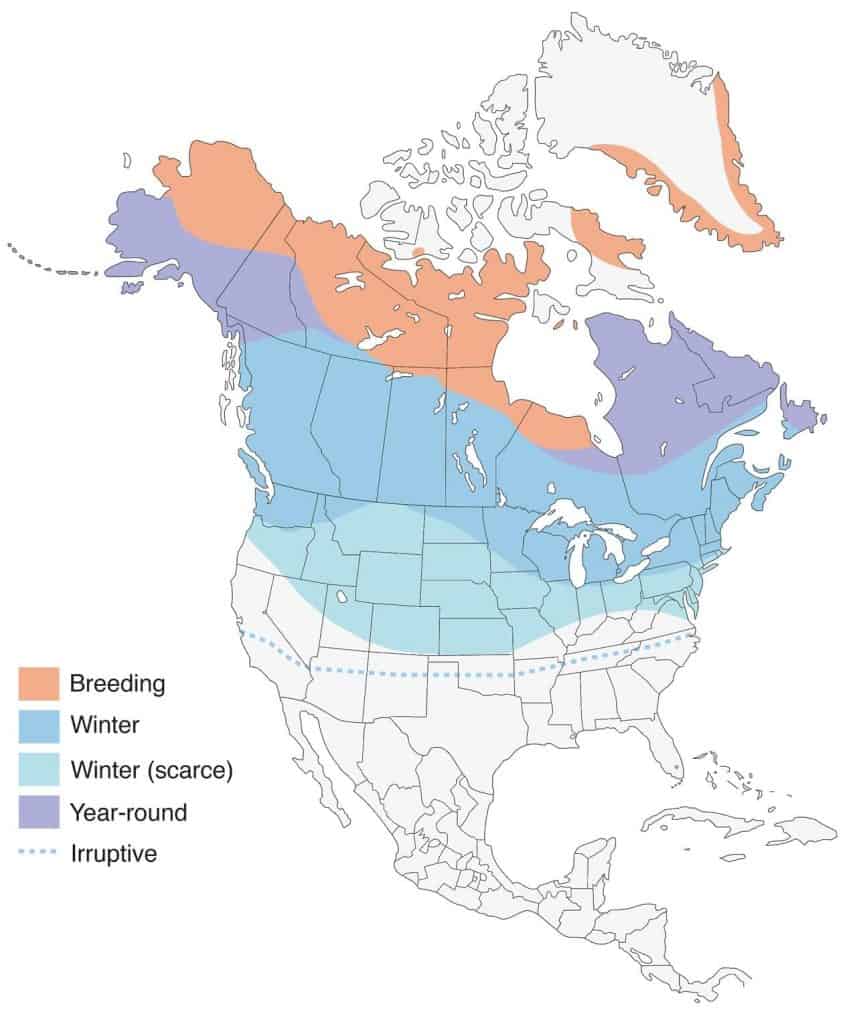
Dark-Eyed Junco in Winter
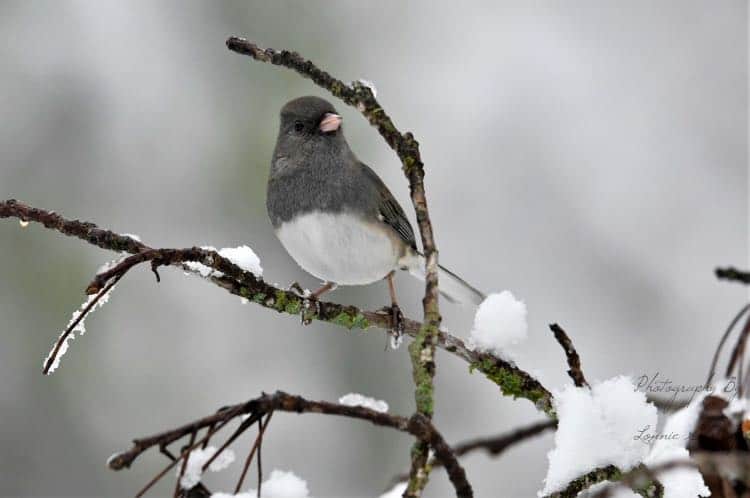
Appearance: Dark-eyed juncos are tiny birds about 5.5″ – 6.5″ long. Males are dark gray with a white underside and pink bill. Females are the same except brownish gray.
Diet: Seeds.
Feeder food: Nyjer, black-oil sunflower seeds, hulled sunflower seeds, safflower seeds, cracked corn, hulled peanuts, and suet.
Habitat: In winter, dark-eyed juncos are found across the US and southernmost parts of Canada so can be found in a variety of habitats including forested areas (both coniferous and deciduous), wide-open spaces, partially wooded edges, parks, and backyards.
Range Map
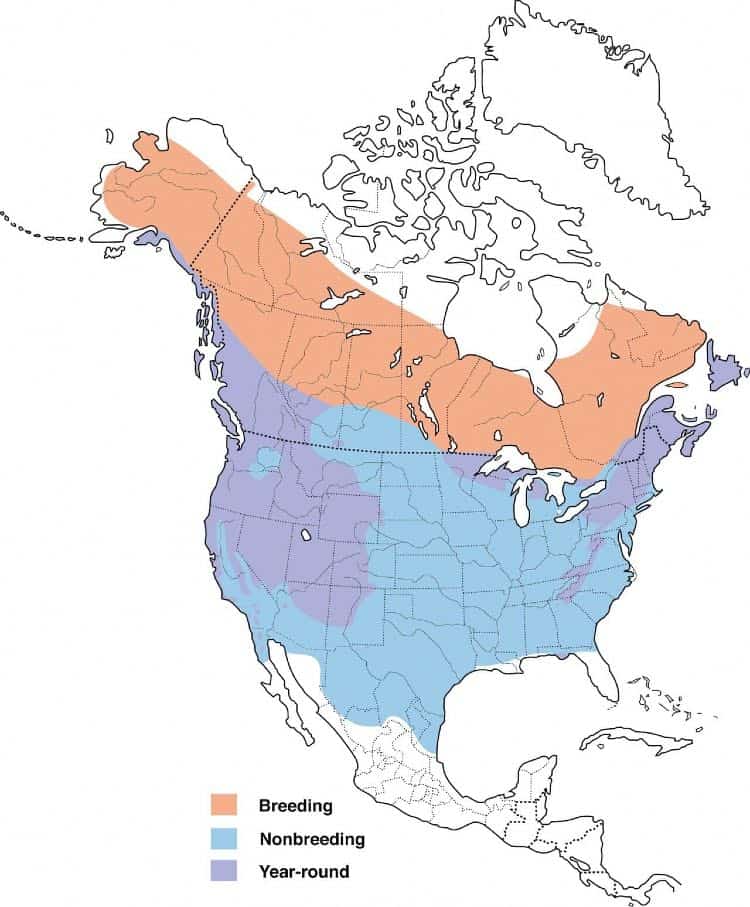
Downy Woodpecker in Winter
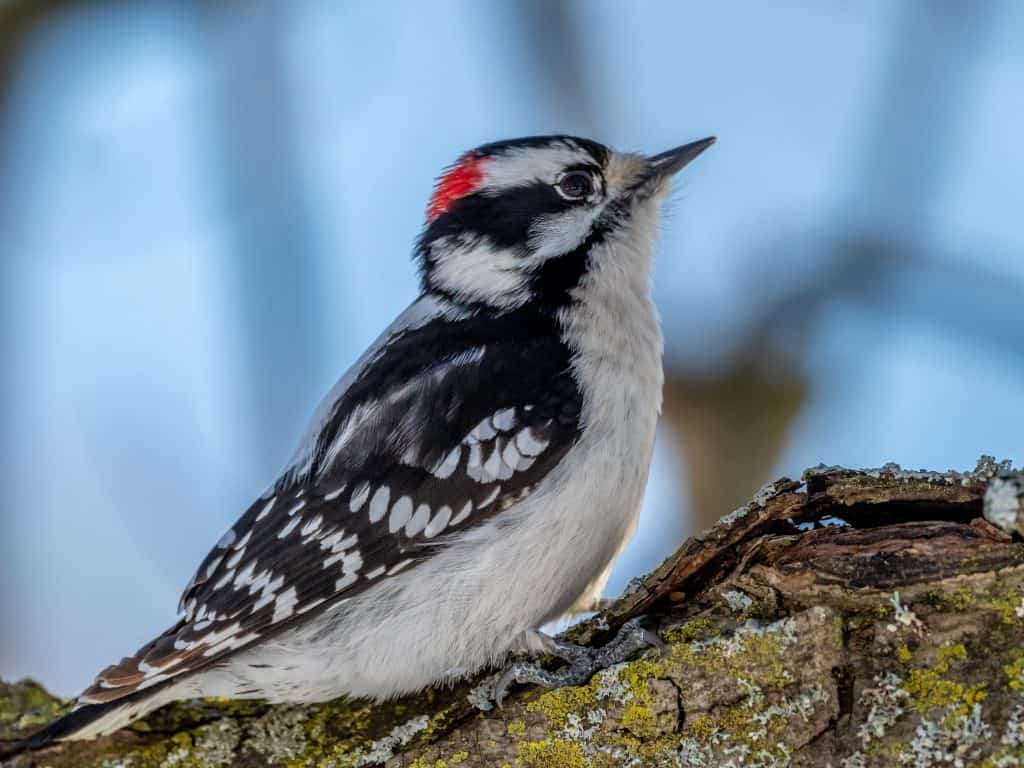
Appearance: Downy woodpeckers are small birds 6″ – 7″ long. Males are tuxedo-black with a white stripe on the back, white belly, white outer tail feathers, some spotted areas of white on the wings, a yellow/tan spot above the beak, and the infamous red patch on his head at the back of the crown. Females are nearly identical without red coloring.
Diet: Fruit and berries that remain on the trees, shrubs, and vines.
Feeder food: Suet, peanut butter spread, Sunflower seeds, Safflower seeds, hulled peanuts, corn, fruits, nectar (sugar water).
Habitat: Downy woodpeckers are common throughout the US and Canada. They’ll be found anywhere there are trees.
Range Map
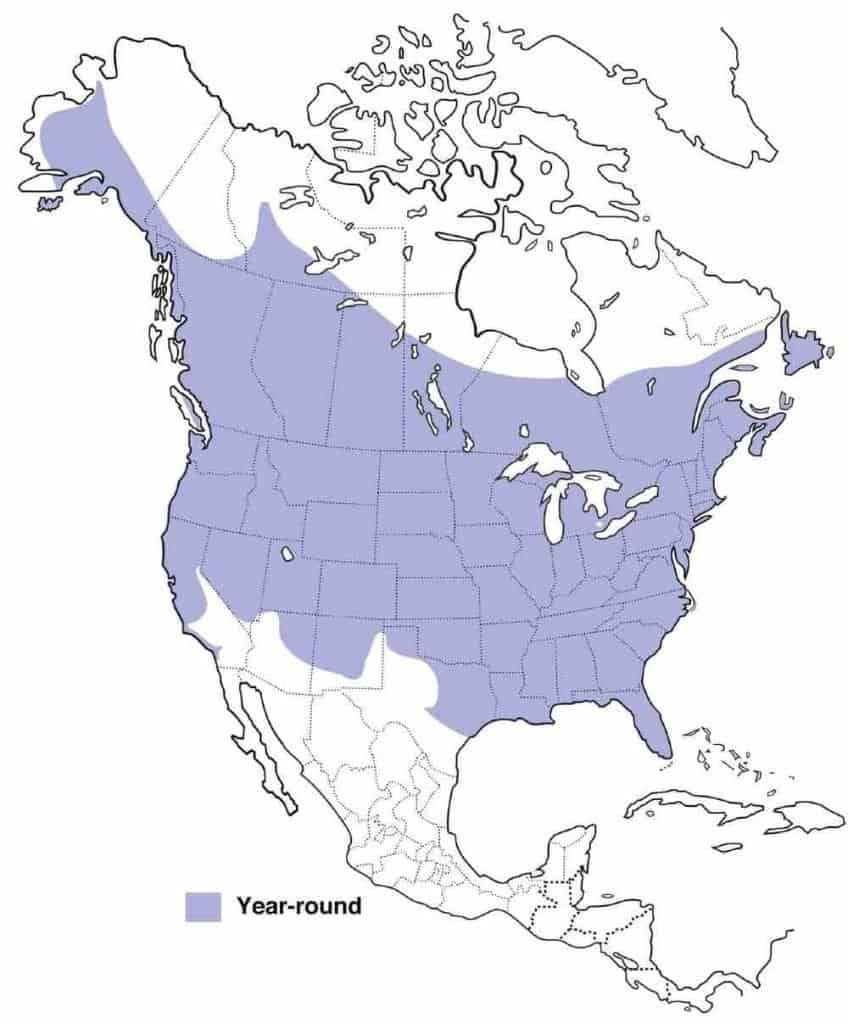
Eurasian Collared-Dove in Winter
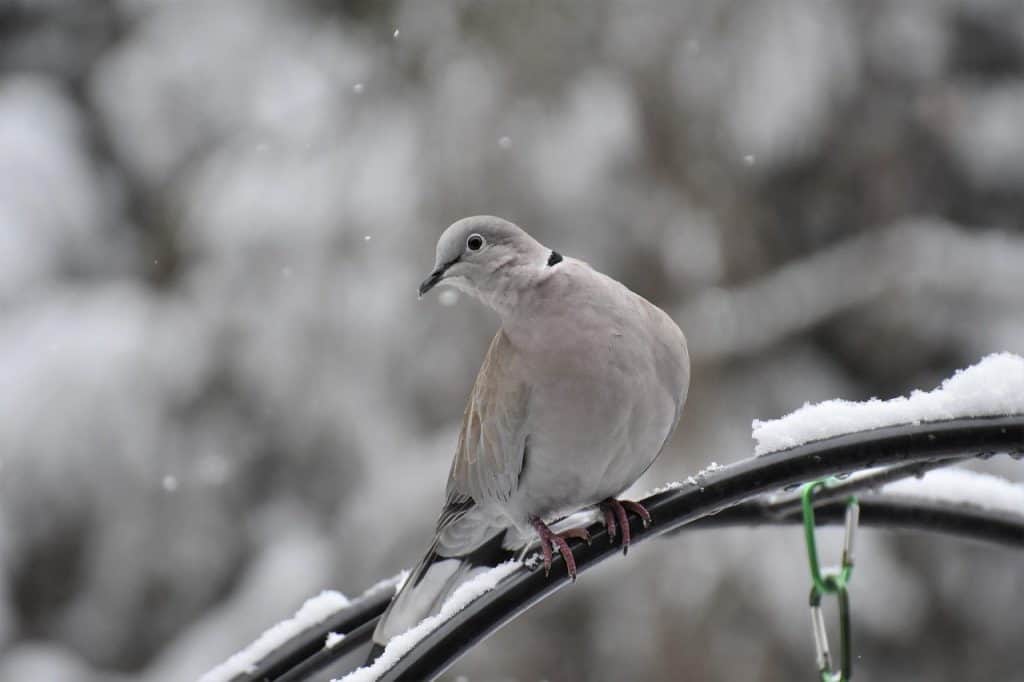
Appearance: The Eurasian collared-dove is a large bird about 12 1/2″ long, gray/tan with a black collar on the back of its neck. Eyes are large and black, bill long and slightly curved down. They have a long, squared-off tail with a white tip best seen from underneath.
Winter diet: Seeds, grain, and berries that happen to be left on the vine/branches.
Winter feeder food: Millet on the ground or platform feeder.
Winter habitat: In winter, the Eurasian collared dove remains in its year-round range including all US states except New England. They prefer to live near towns, suburbs, and farms.
Range Map
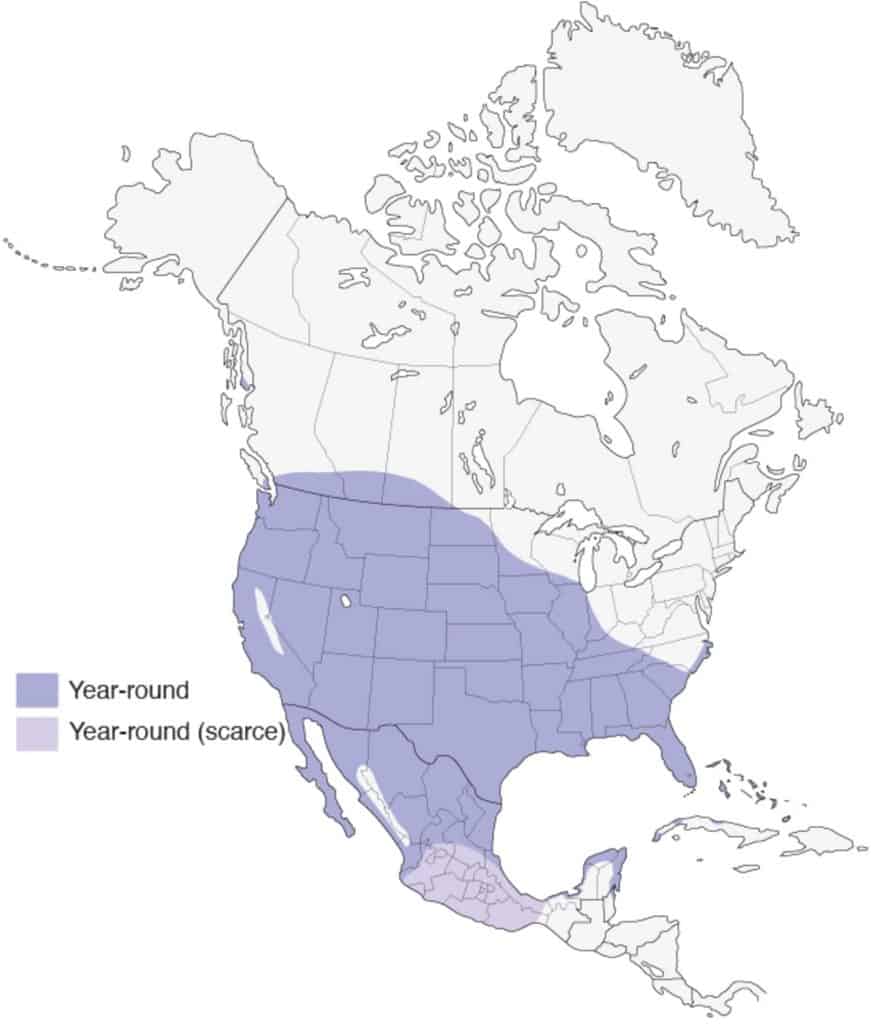
European Starling in Winter
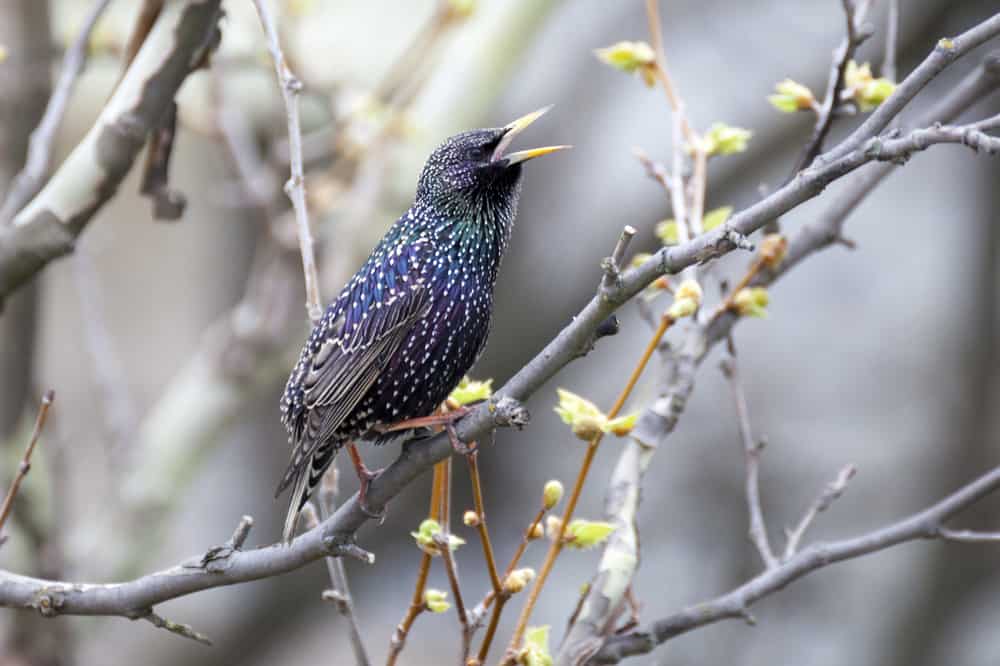
Appearance: The European starling is a medium-sized bird about 7 1/2″ long with iridescent shades of purple and black with white speckles throughout. They have a long pointed gray bill in fall and yellow in spring. The tail is short. The female of the species looks the same.
Winter diet: Seeds and fruit that happen to remain on the barren branches.
Winter feeder food: Everything and anything you could offer at the feeder.
Winter habitat: Starlings are year-round birds found throughout the US and Canada. A handful of them migrates south into Mexico. They don’t have a strong preference for habitat but are commonly found in urban and residential areas including backyard lawns, parks, and fields.
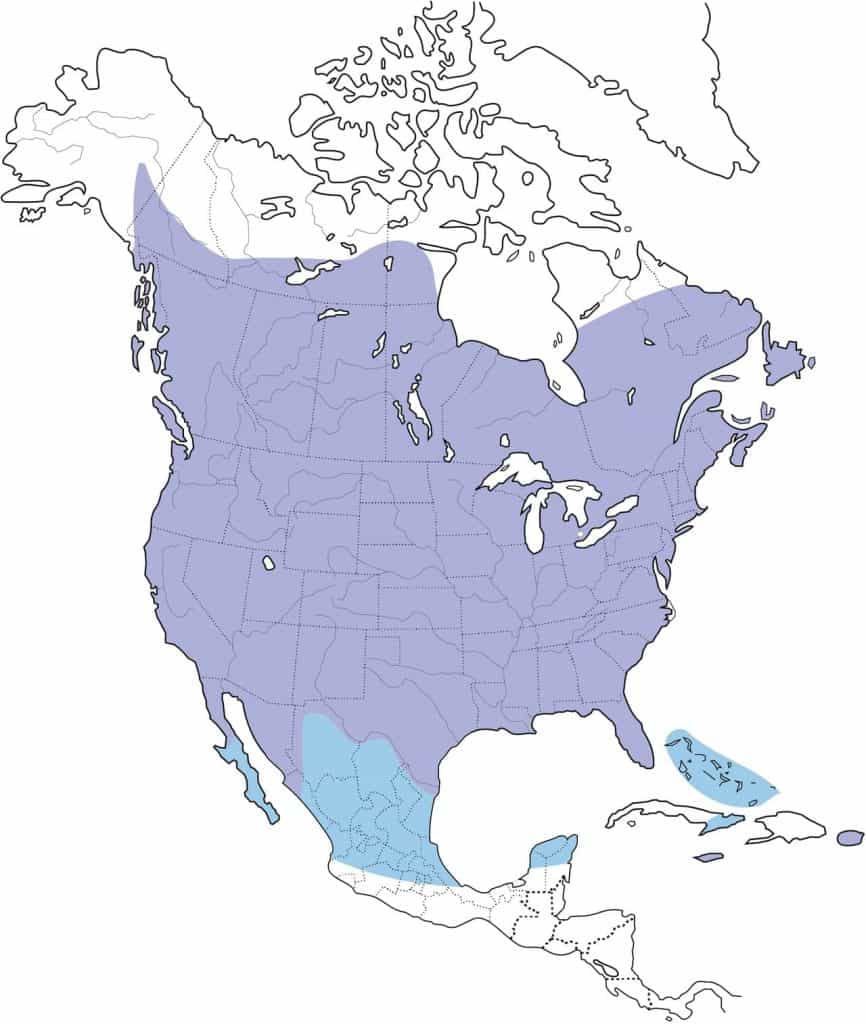
Golden-Crowned Kinglet in Winter
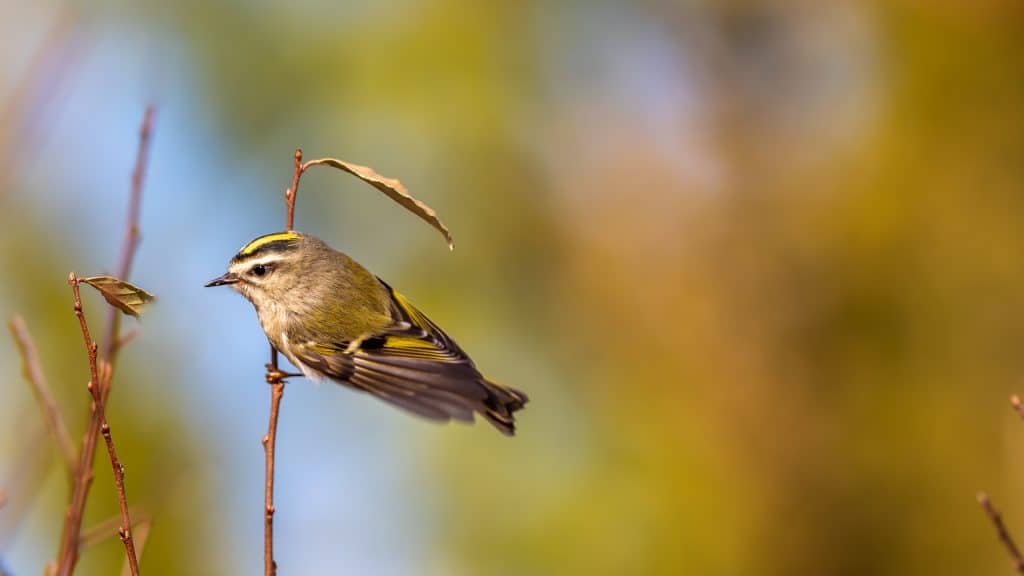
Appearance: Golden-crowned kinglets are small birds about 4″ long, olive-green in color with crowns striped with reddish/orange and white stripes above & below eyes. Females are the same except for their crowns are yellow instead.
Winter diet: Seeds and whatever insects they can uncover.
Winter feeder food: Suet
Winter habitat: While some golden-crowned kinglets remain in their year-round mountainous range for winter (including the Pacific coast & New England), even more birds migrate south and east to inhabit every US state. In winter they prefer conifers, deciduous forests, suburbs, swamps, bottomlands, and scrubby habitats.
Range Map
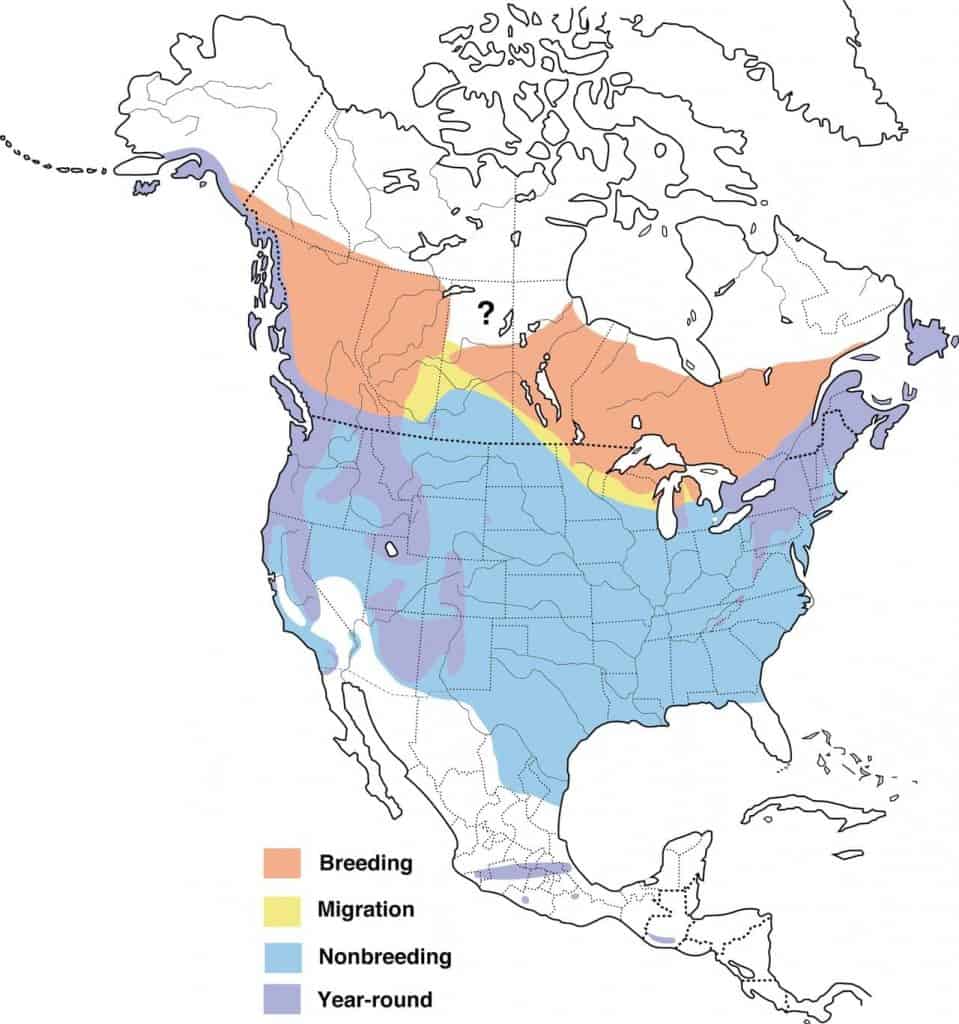
Great Blue Heron in Winter
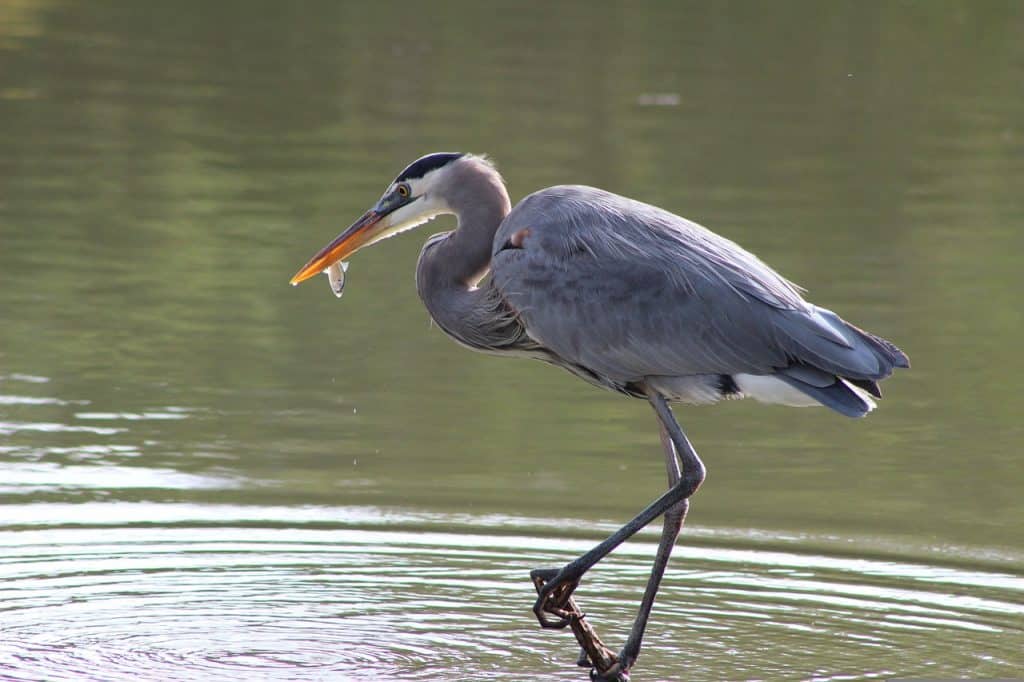
Appearance: Great blue herons are enormous waterbirds about 45-55″ long. They have a large body with blue/gray feathers, long legs, a white face with a black streak on the cheek and crown, a long pointy orange bill, and a curvy neck which they often curl into the shape of an “S”.
Winter diet: Fish, frogs, salamanders, turtles, snakes, insects, small mammals, and birds.
Winter feeder food: They don’t visit feeders.
Winter habitat: In winter, great blue herons remain in their year-round range which includes most of the US and some migrate south into Mexico. They prefer calm fresh water, rivers, and shallow coastal areas.
Range Map
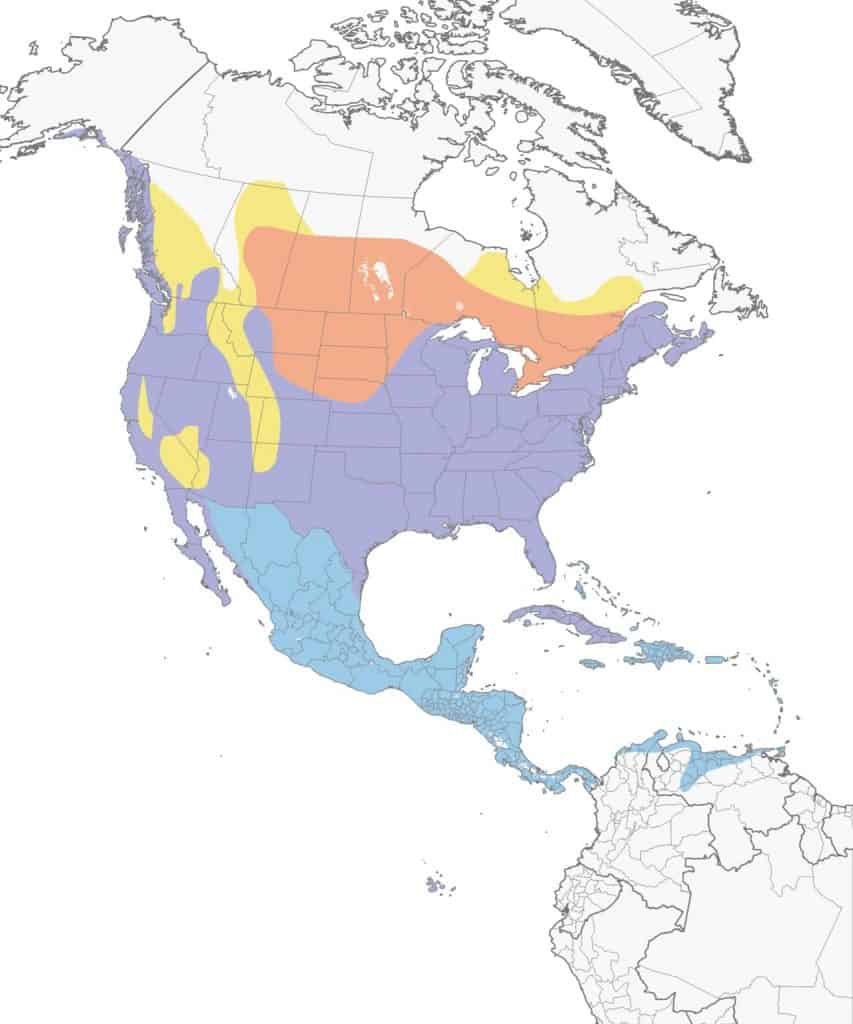
Great Gray Owl in Winter
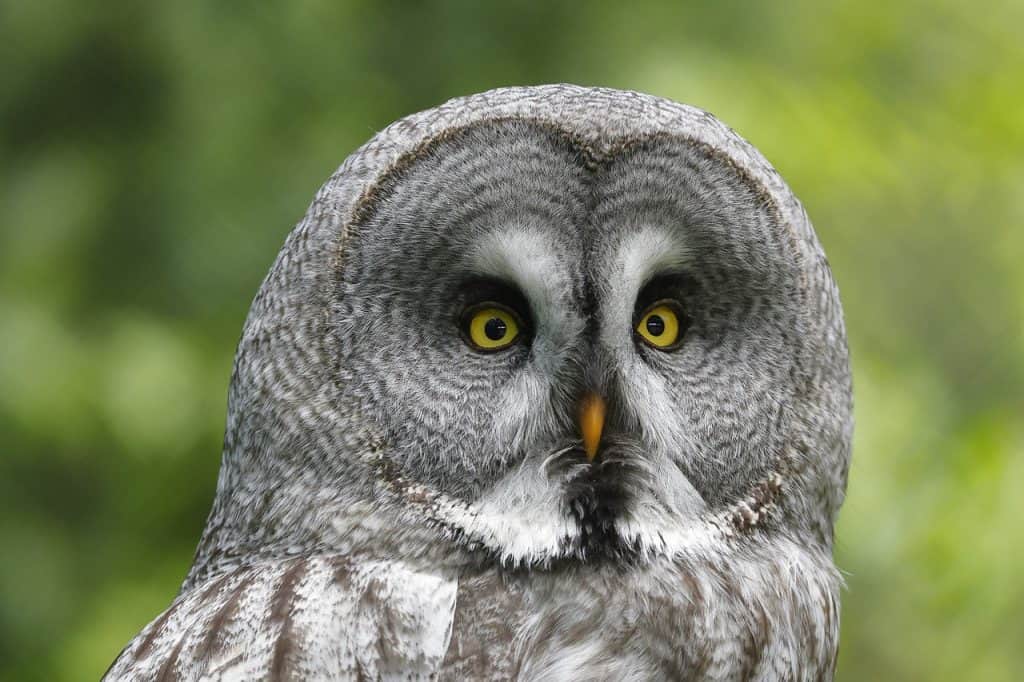
Appearance: Great gray owls are large birds about 24-33″ in length. They’re brown, silver, and white streaked, have very large heads, and have a large relatively flat face. Their eyes are close together and bright yellow and their beak is orange. Females are the same except bigger.
Winter diet: Small mammals.
Winter feeder food: Great gray owls are not feeder birds.
Winter habitat: The great gray owl prefers dense and moist evergreen forests in the far north.
Migration: Great gray owls are not migrators. In the winter they can be found in Alaska, northeast Washington, northern Idaho, western Montana, central Oregon, eastern California, western Wyoming, northern Minnesota, Wisconsin, Michigan, New York, New England, and all Canadian provinces (except Nunavut).
Range Map
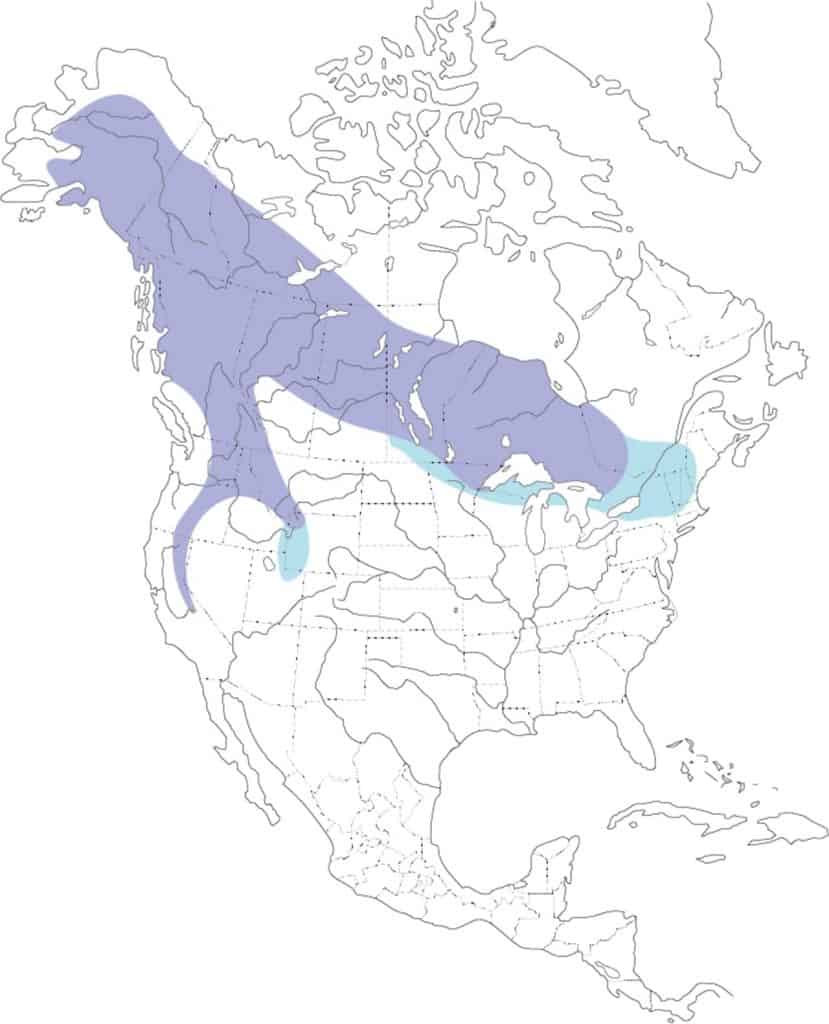
Great Horned Owl in Winter
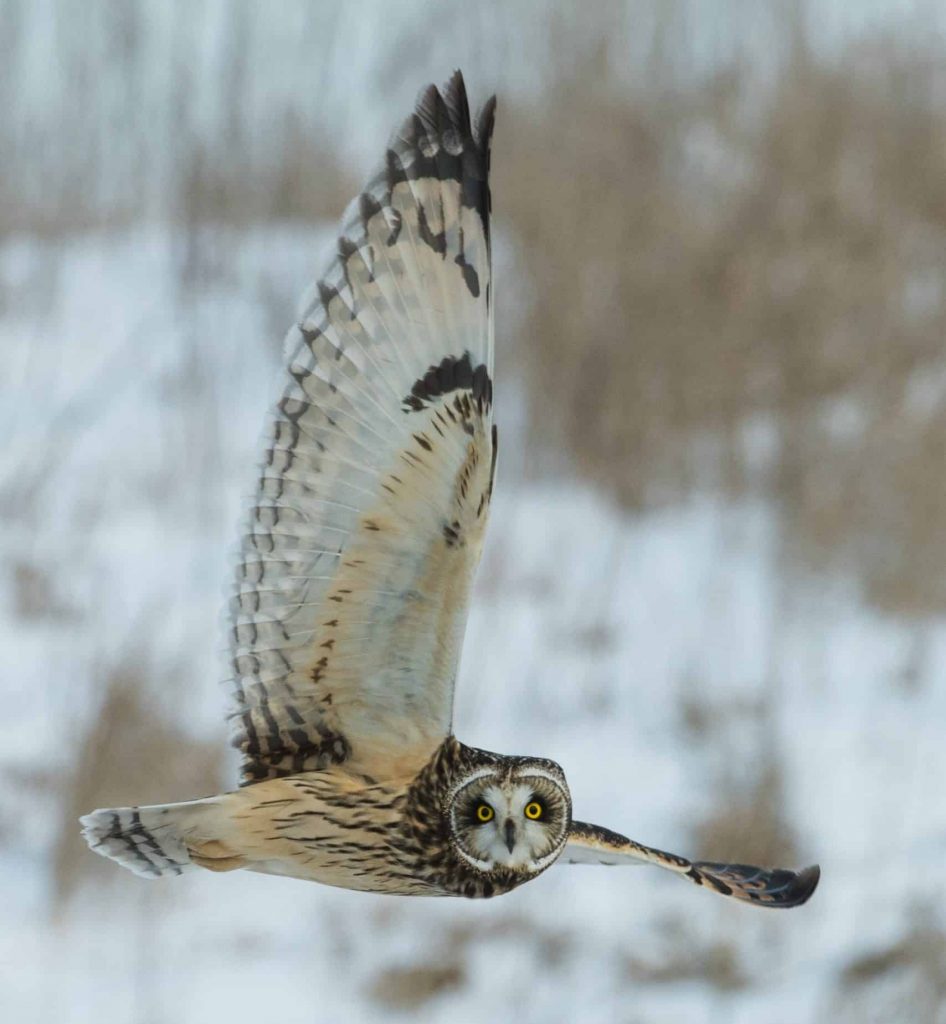
Appearance: The Great horned owl is a large bird about 22″ long. They have a large barrel-shaped body with tufts of feathers that stick up and appear as though they’re ears (but they’re not). They’re mostly brown with dark bars and specks throughout and a subtle white stripe across the throat. Large yellow eyes with a short bill.
Winter diet: Mammals and large birds.
Winter feeder food: They don’t visit feeders.
Winter habitat: Great horned owls spend all four seasons in their year-round range which includes all of Canada, the US, and Mexico. Some are even in South America. They prefer wooded areas.
Range Map
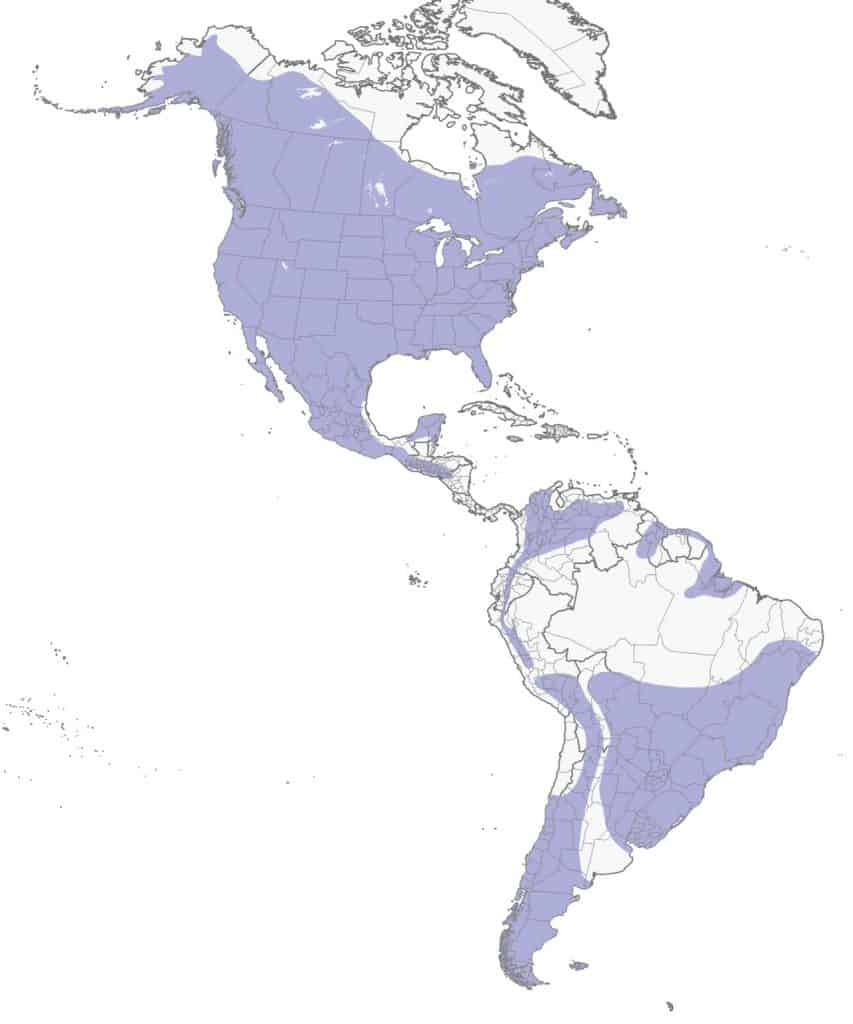
Gyrfalcon in Winter
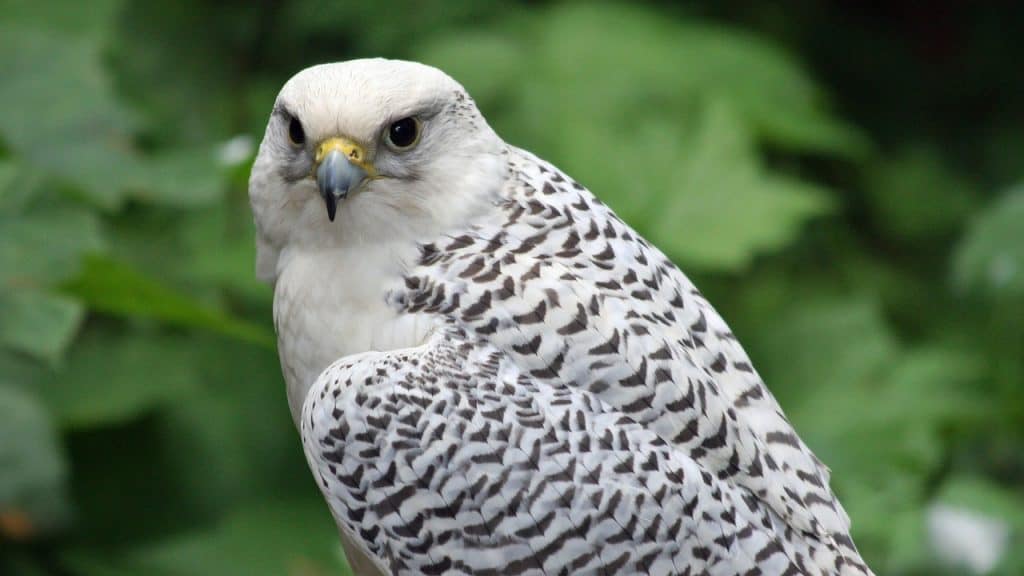
Appearance: Gyrfalcons are enormous birds about 19-26″ long. The more regal variety of this bird is white with black spots. However, they do come in other shades including white, gray, and dark brown. The wings, back, and tails are barred with either gray or dark brown. The wings and tail are long. The females are the same but much larger.
Winter diet: Birds and small mammals (e.g. rabbits, squirrels).
Winter feeder food: Not feeder birds.
Winter habitat: Gyrfalcons prefer the northern tundra both inland and along the coasts where seabirds and waterfowl are on the menu. Occasionally they can be found along the edges of forested areas. In lower elevations, they are found in open areas.
Migration: Gyrfalcons are migrators. In the winter they can be found in Alaska, Washington, Idaho, Montana, Wyoming, North & South Dakota, Minnesota, Wisconsin, Michigan, New York, Vermont, New Hampshire, Maine, and all Canadian provinces.
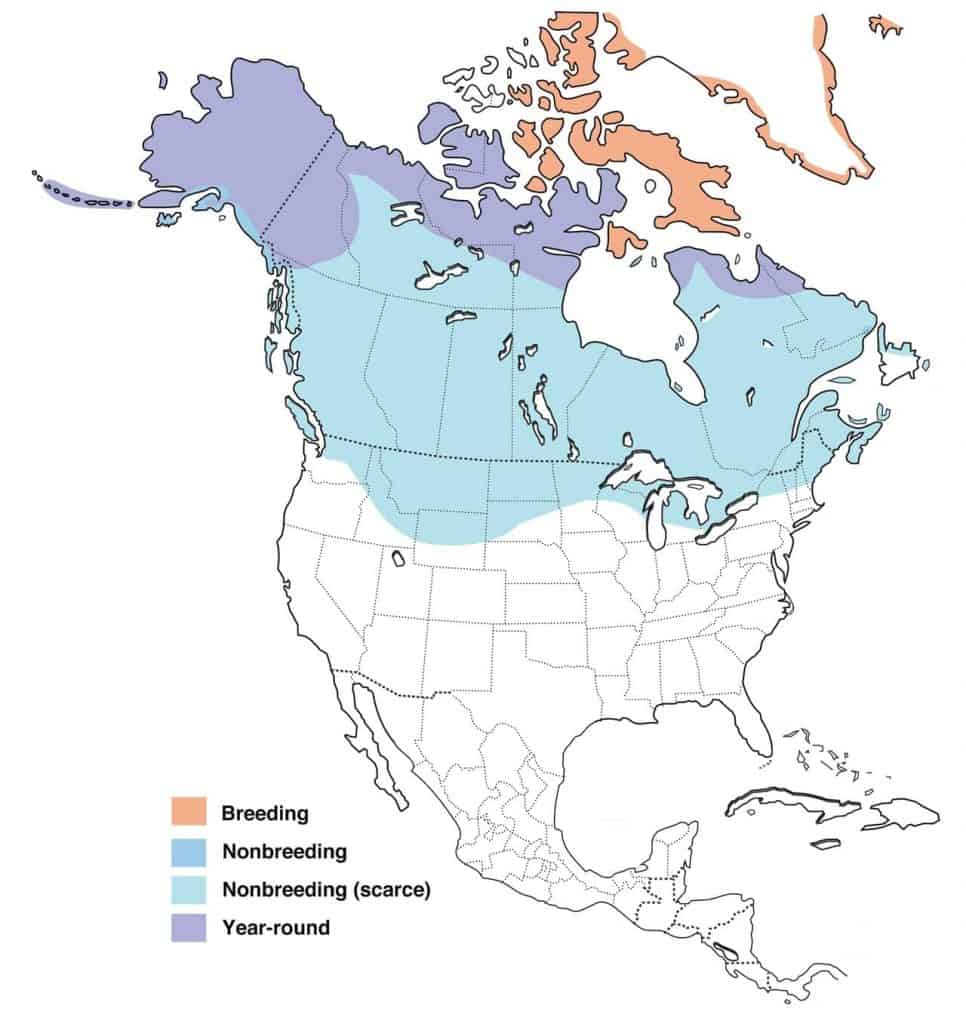
Hairy Woodpecker in Winter
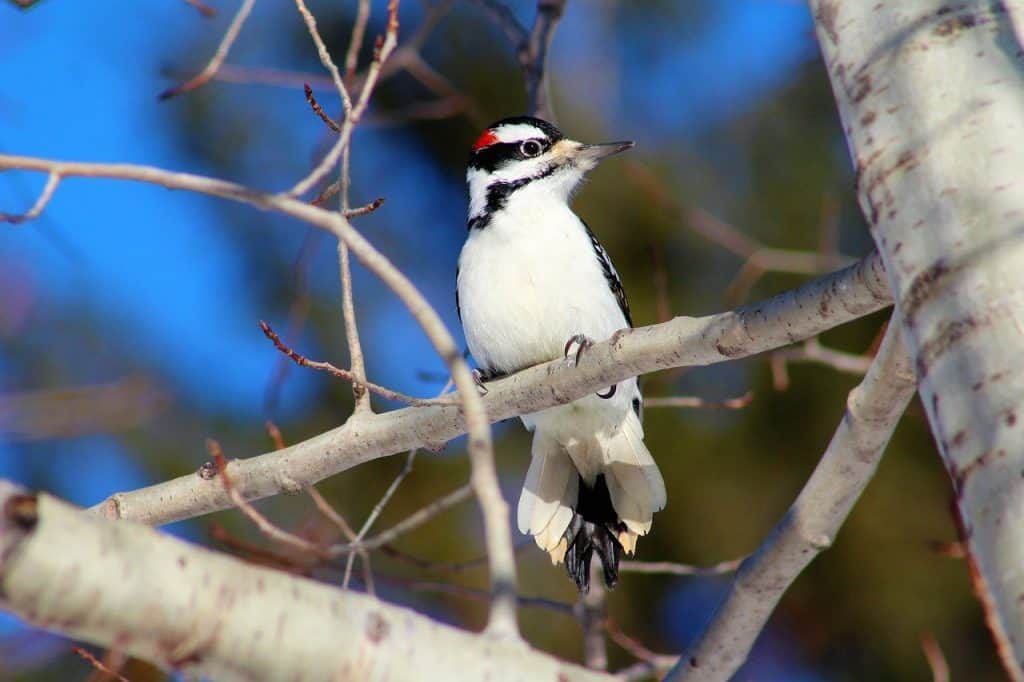
Appearance: The hairy woodpecker is a medium-sized black-and-white bird about 9″ long with a white belly and black wings with white spots. A white stripe runs down the back. They have a red mark on the back of the head and a long black bill. The female is the same except with no red mark.
Winter diet: Seeds, nuts, and any hibernating insects they can find beneath the tree bark.
Winter feeder food: Suet, hulled peanuts.
Winter habitat: Hairy woodpeckers are year-round birds throughout the US and Canada. They prefer mature forests, urban, and suburban areas where dense trees are found.
Range Map
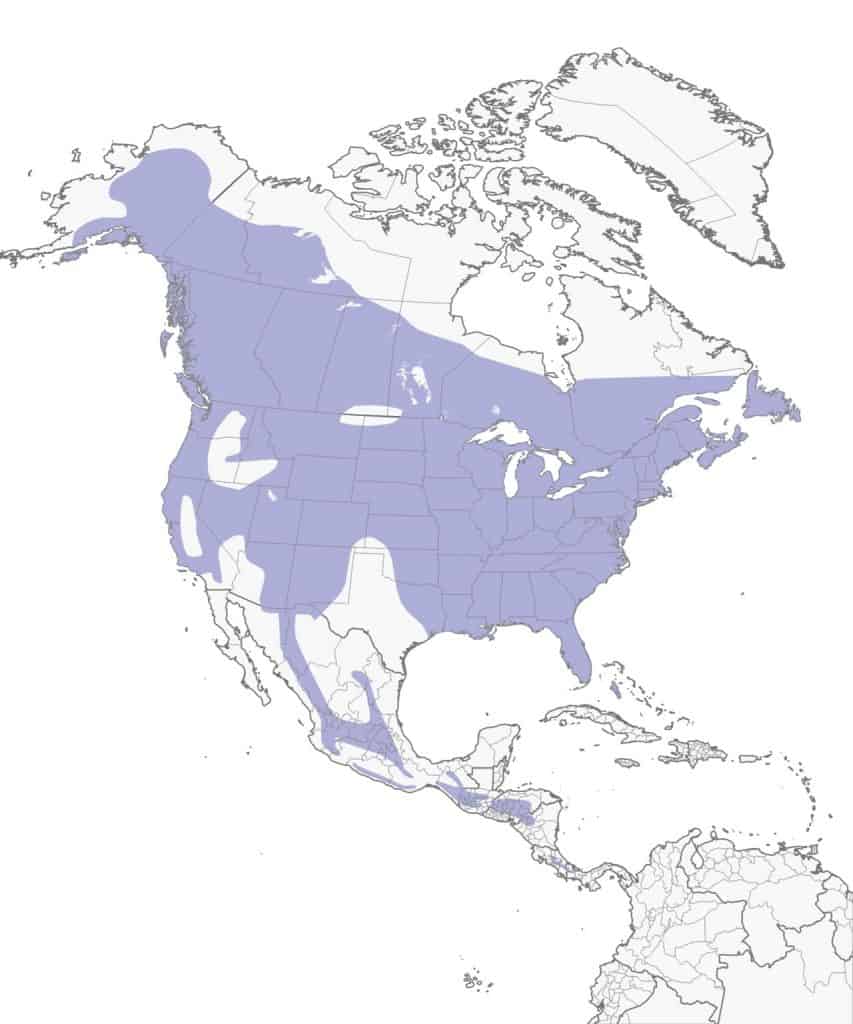
Hoary Redpoll in Winter
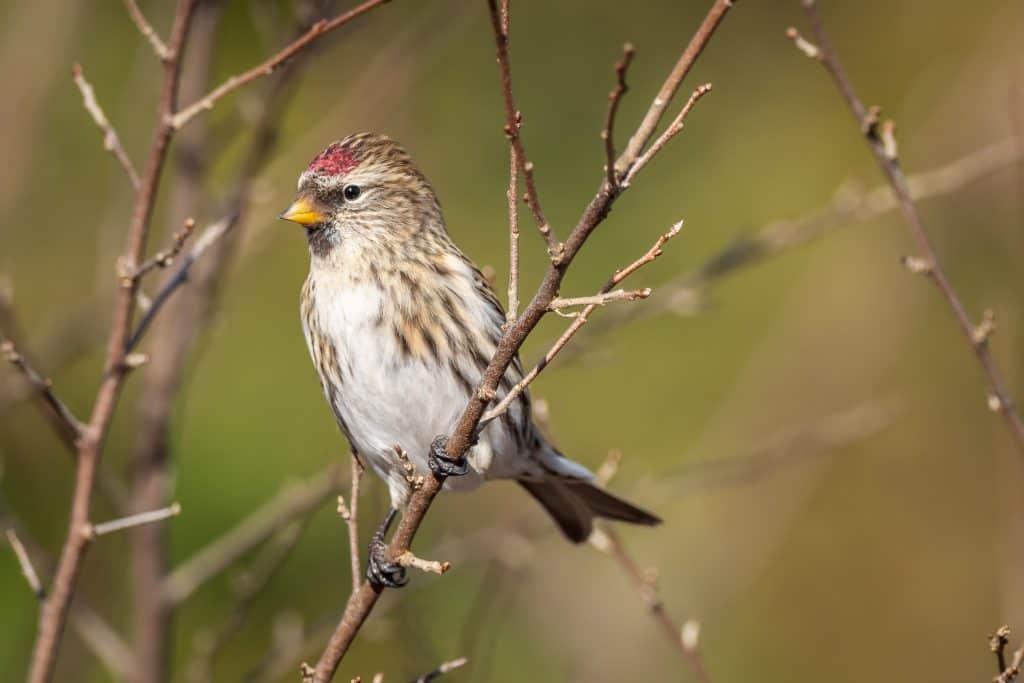
Appearance: Hoary redpolls are small birds about 5″ long with brown/gray streaks throughout, pink belly, charcoal tail & wings, and the infamous red patch on the forehead. Their bill is yellow, short, and stubby. Females are similar with less streaking and a white belly.
Winter Diet: Seeds (especially birch, alder, willow, and grasses).
Winter Feeder Food: Thistle (nyjer) seed.
Winter Habitat: Hoary redpolls are northern birds. In winter they settle in Alaska, the northern parts of North Dakota, Minnesota, and Michigan, and Canada’s Yukon Territory, Northwest Territories, northeast Alberta, Saskatchewan, Manitoba, Ontario, and Quebec.
Migration: Hoary redpolls are migrators. In winter they migrate south to Alaska, the northern parts of North Dakota, Minnesota, and Michigan, and Canada’s Yukon Territory, Northwest Territories, northeast Alberta, Saskatchewan, Manitoba, Ontario, and Quebec.
Range Map
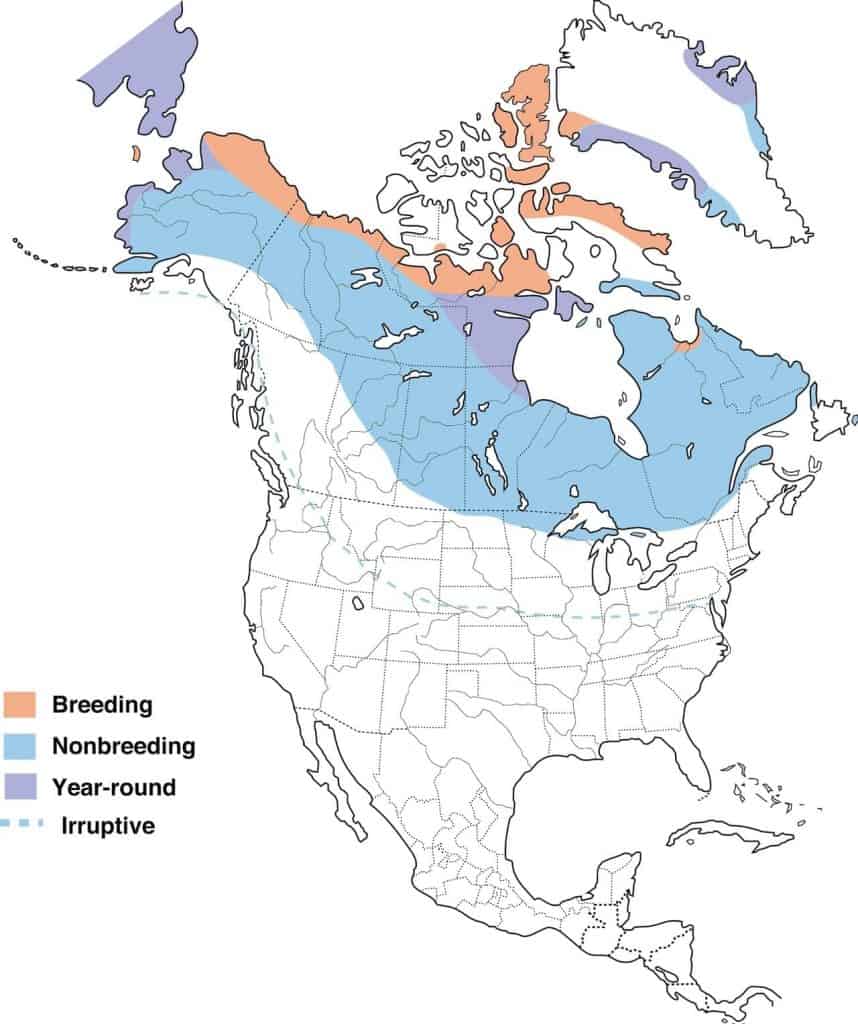
Horned Lark in Winter
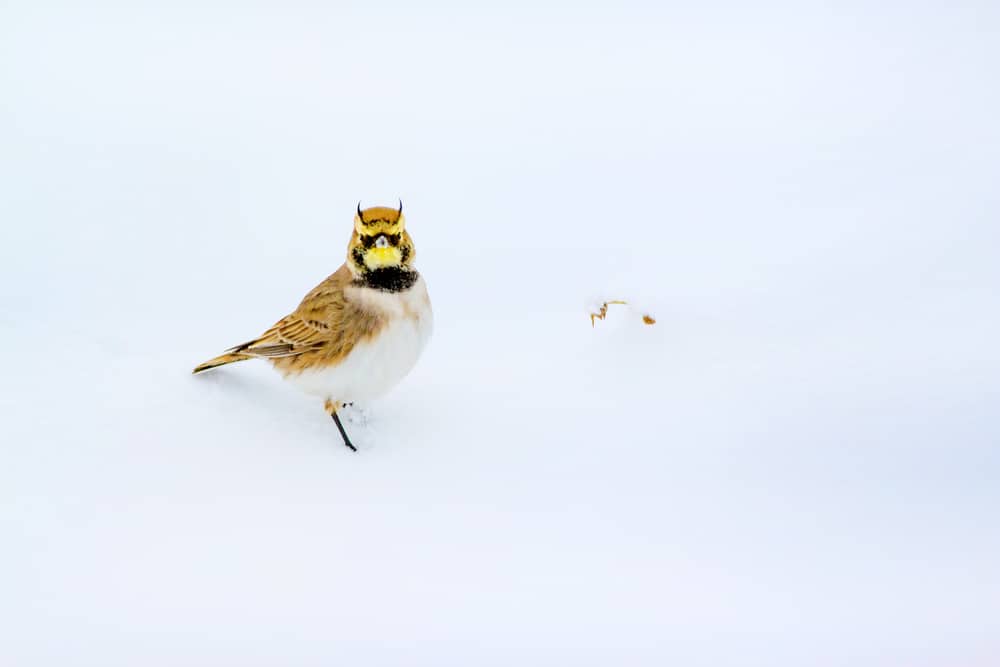
Horned lark.
Appearance: The horned lark is a medium-sized bird about 8″ long. Tan to brown with a black necklace and yellow chin. Bill is black. They have two tiny “horns” on the top of their head. The tail is black with white outer feathers.
Winter diet: Seeds.
Winter feeder food: They do not visit feeders.
Winter habitat: Horned larks spend winter throughout the US and southern British Columbia, Alberta, and Saskatchewan. They prefer short grassy areas such as prairies, deserts, beach dunes, and farmers’ fields.
Range Map
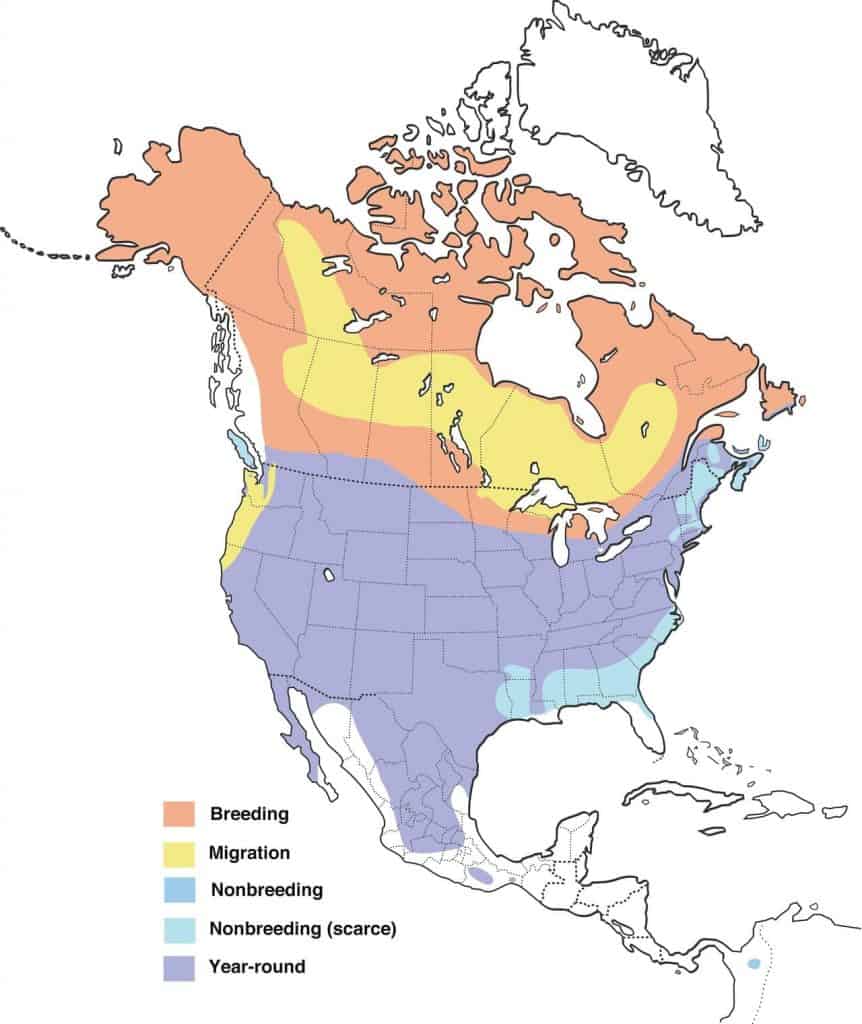
House Sparrow in Winter
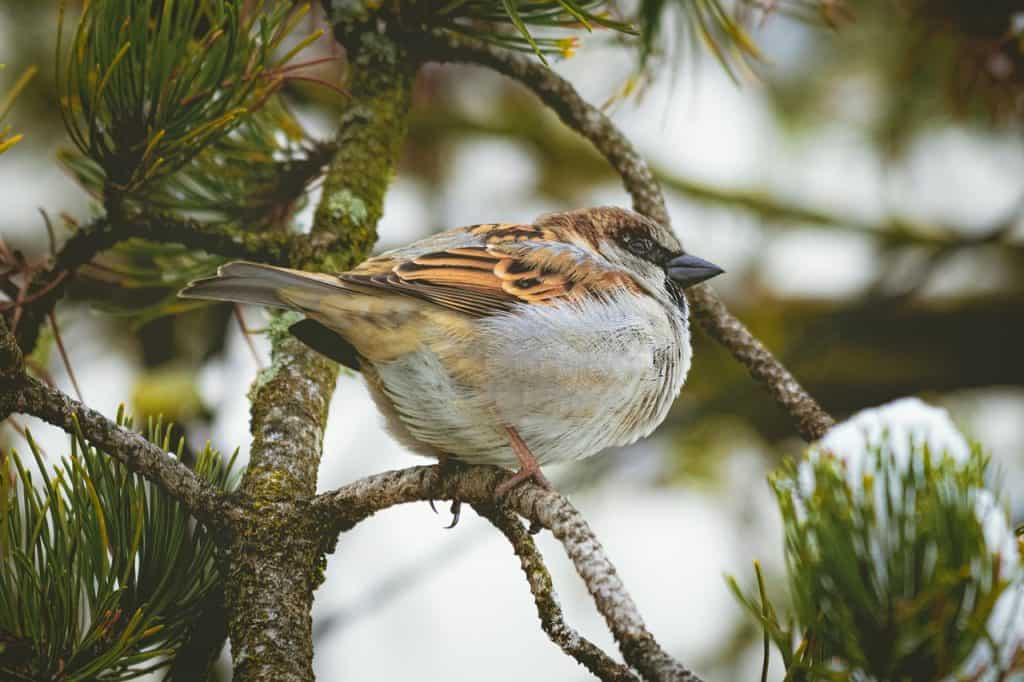
Appearance: House sparrows are small birds about 6″ long, brown with a large grayish-edged bib (in spring & summer the bib becomes a prominent black) and chin down to the chest. White wing bar and gray belly & crown. The Female is a bit smaller, all light brown and not black.
Diet: Seeds and fruit.
Feeder food: Black oil sunflower seed, cracked corn, peanut hearts, millet, and milo.
Habitat: House sparrows are prominent and common throughout the US and Canada. They’re found around people and buildings in the city, towns, villages, suburbs, and farms.
Range Map
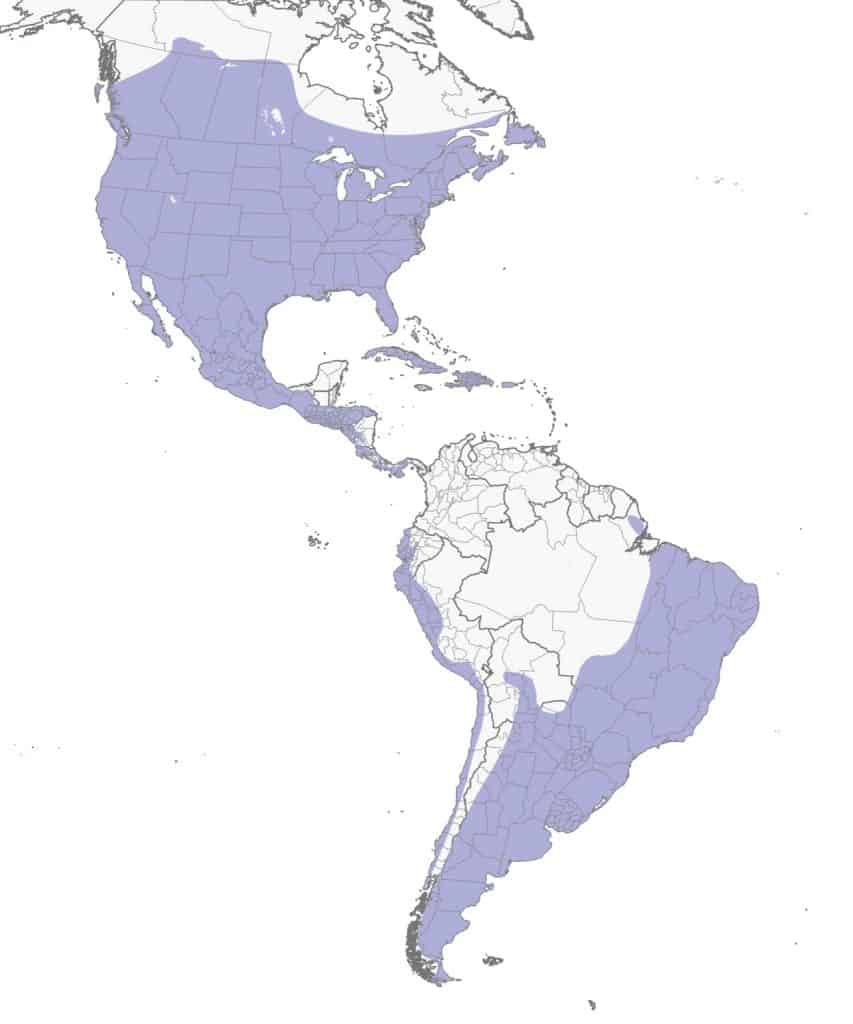
Mallard in Winter
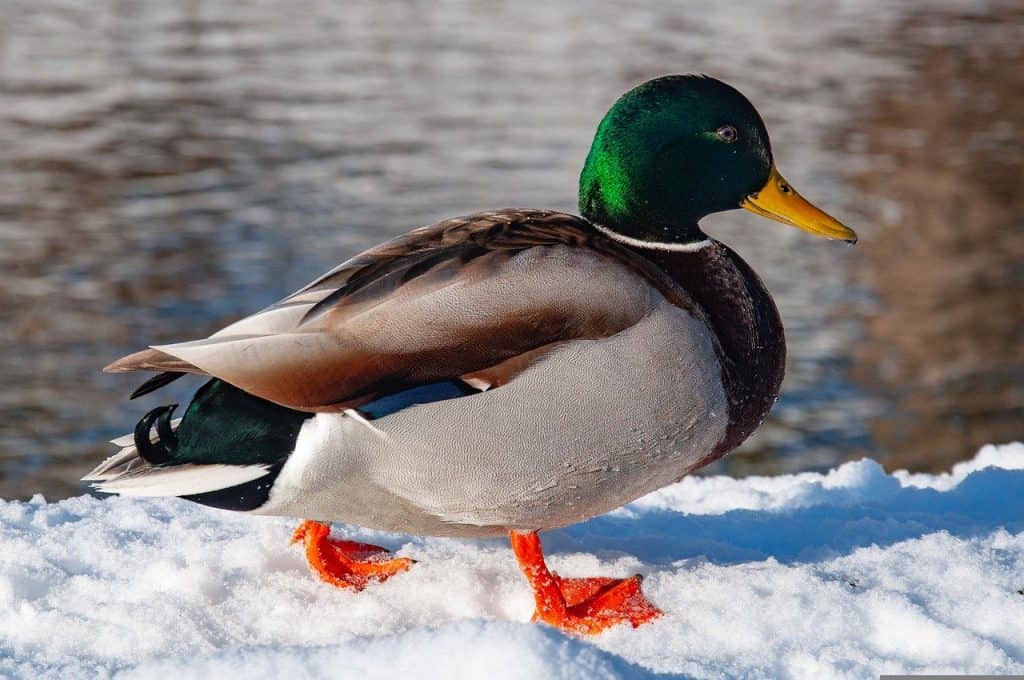
Appearance: Mallards are large ducks about 23″ long. The male has a metallic green head, chestnut breast, and yellow bill. The female is a mottled brown with an orange bill and heavily streaked dark brown.
Winter diet: Seeds, aquatic vegetation, acorns, corn, rice, and wheat.
Winter feeder food: They’re not feeder visitors.
Winter habitat: Mallards spend winter in every US state as well as British Columbia. They prefer to be around open, freshwater areas but can also be found around farmer’s fields.
Range Map
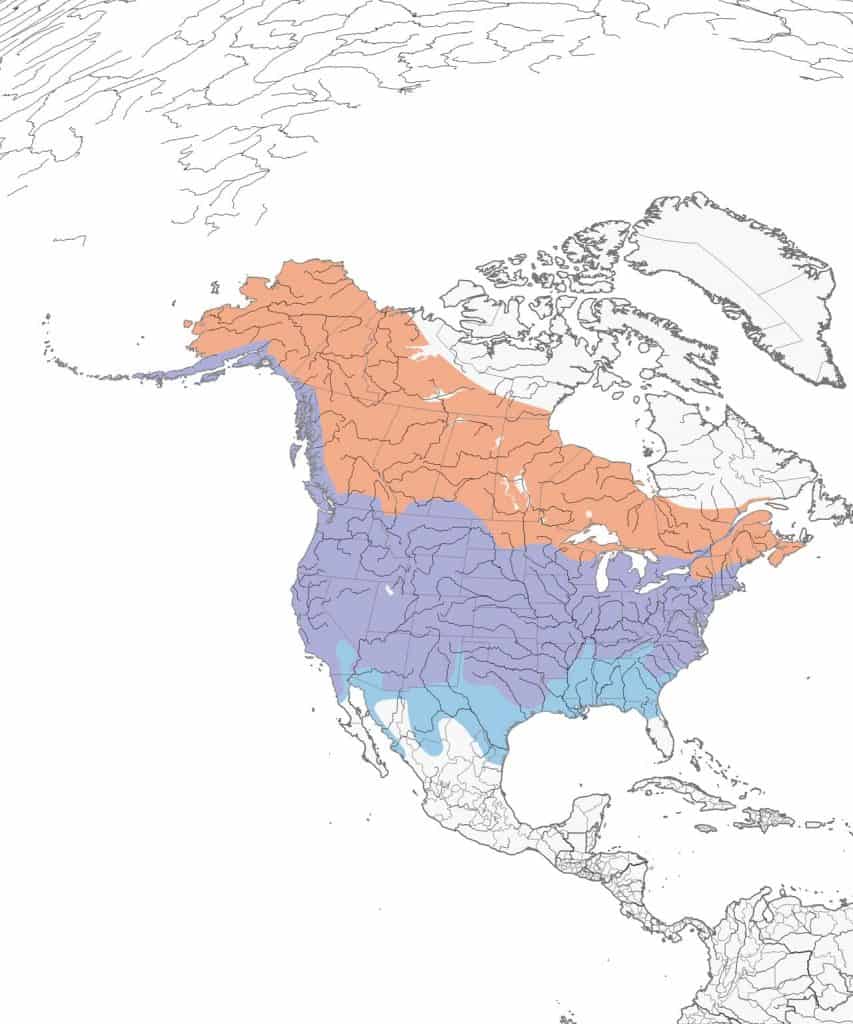
Northern Flicker in Winter
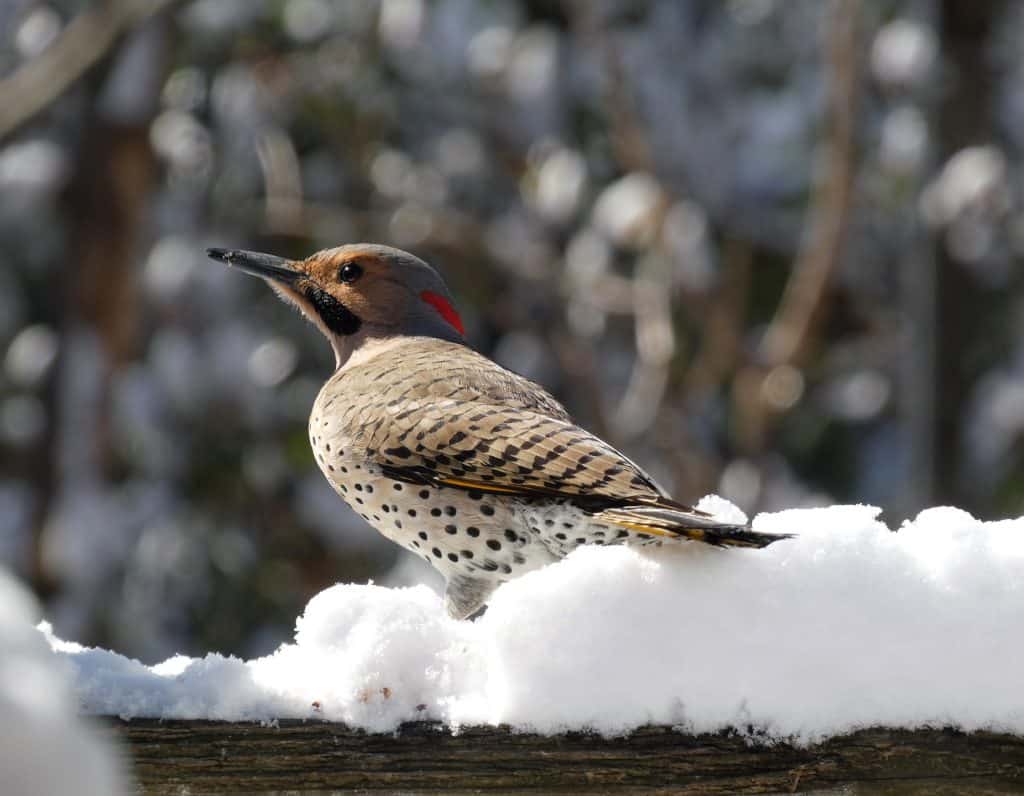
Appearance: The northern flicker is a large bird about 12.5″ long. They have brown backs with black bars, a black crescent on the upper chest, and white with black spots on the belly and underparts.
• In the eastern part of their range, they are referred to as “yellow-shafted northern flickers” and have bright yellow underwings and undertail. They have a gray crown, tan face, and a red patch on the nape. The male has a black swipe on his cheek, the female does not.
• In the western part of their range, they are referred to as “red-shafted northern flickers” and have pink underwings and undertail, brown crown, gray face, and crown & nape brown. The male has a red swipe on his cheek, the female does not.
Winter diet: Insects they’re able to find hibernating beneath tree bark.
Winter feeder food: Unlikely to visit a feeder.
Winter habitat: Northern flickers spend winter throughout every state of the US, British Columbia, and the southern parts of Alberta, Saskatchewan, and Manitoba as well as Mexico. They prefer open areas near trees.
Range Map
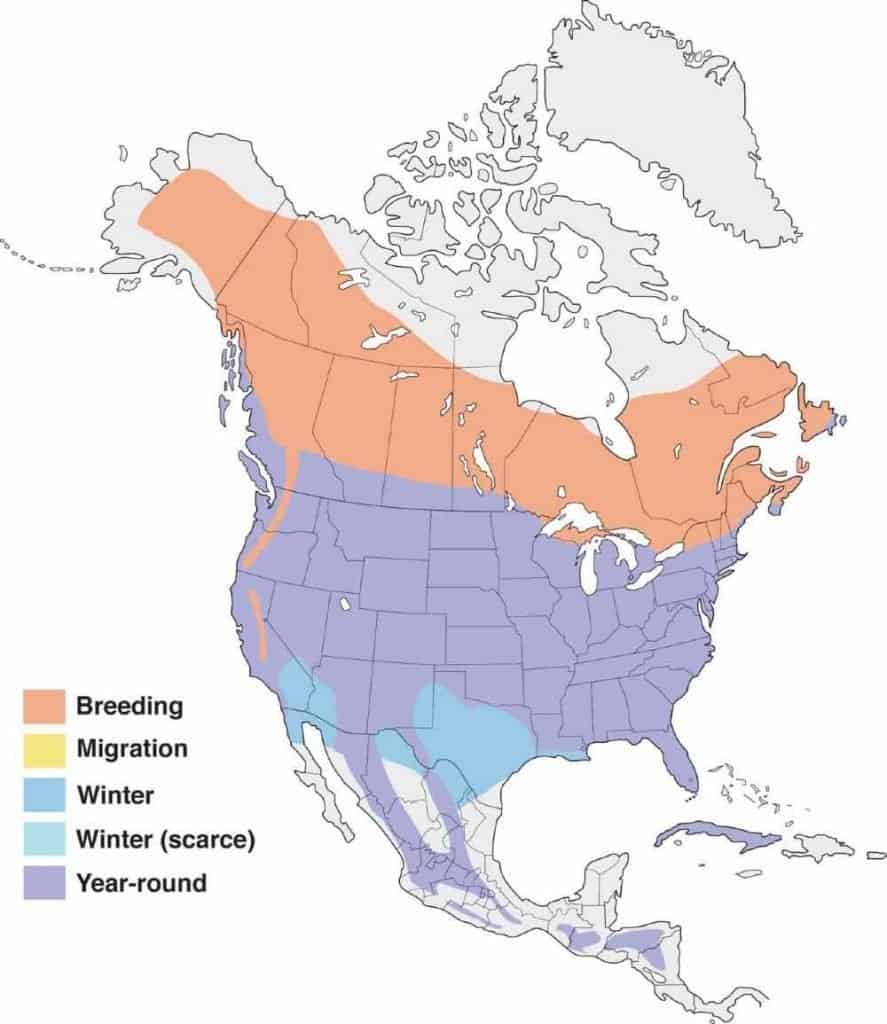
Northern Goshawk in Winter
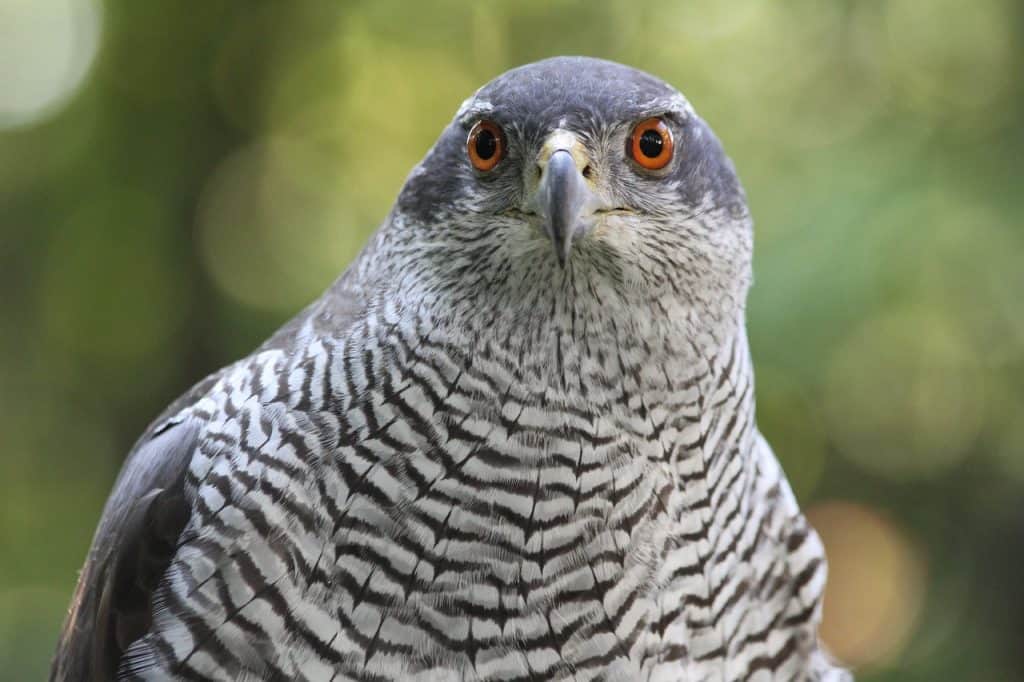
Appearance: Northern goshawks are large birds about 21-30″ long.
Winter diet: Mammals (e.g. rabbits, squirrels), large birds (e.g. grouse, woodpeckers, blue jays, crows), and even carrion.
Winter feeder food: They don’t eat feeder food.
Winter habitat: This bird prefers forest areas comprised of both coniferous and deciduous trees.
Migration: Northern goshawks are migrators. In the winter they are widespread throughout the US including Alaska, Washington, Oregon, California, Idaho, Montana, Wyoming, North & South Dakota, Nebraska, Illinois, and Ohio, Nevada, Utah, Colorado, Arizona, New Mexico, Minnesota, Wisconsin, Michigan, Pennsylvania, New York, and New England as well as Canada and Mexico.
Range Map
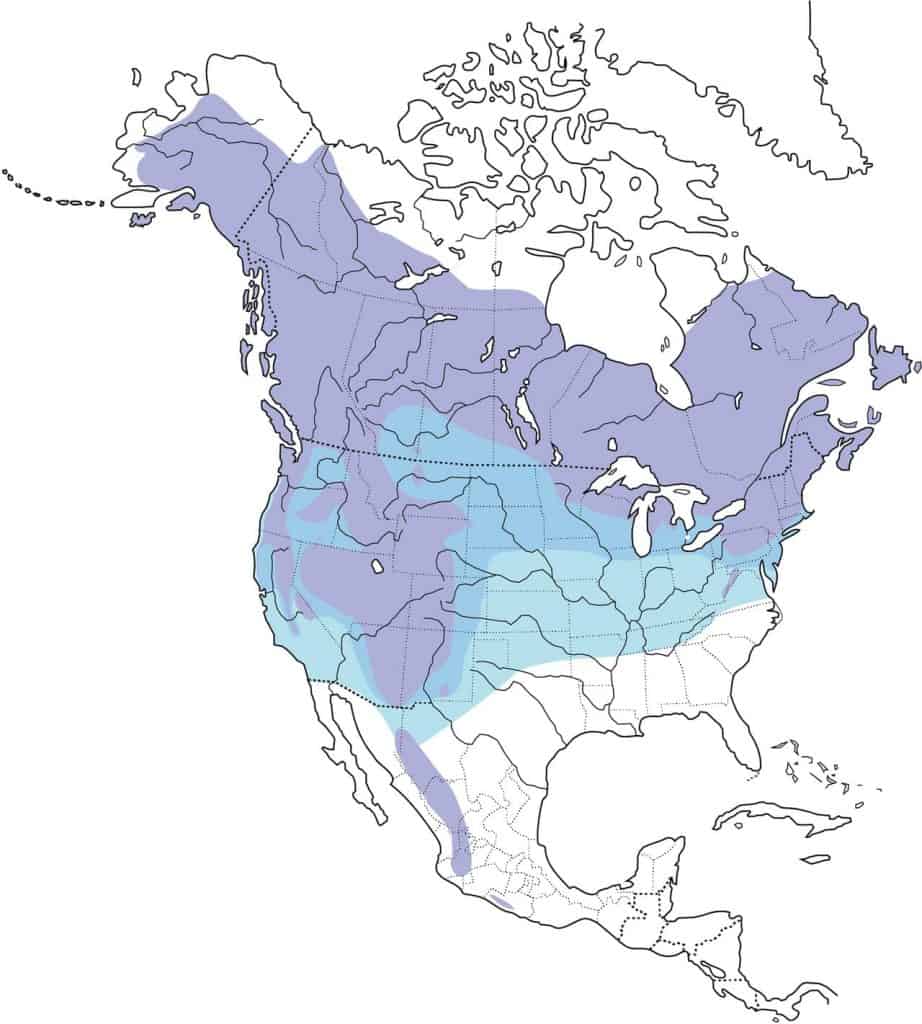
Northern Hawk Owl in Winter
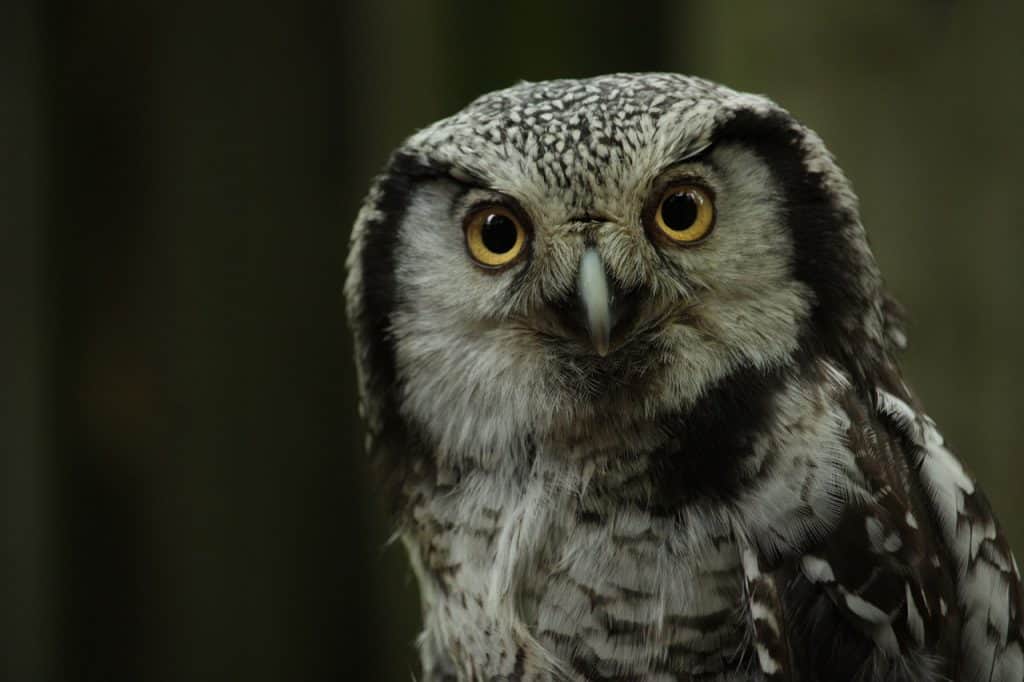
Appearance: The northern hawk owl is a medium-sized owl about 15-18″ long. They’re brown with white spots, their underparts are brown and white streaked, their face is white and edged with brown, their eyes are bright yellow, their tail is long, wings are short and pointy.
Winter diet: Small mammals, birds (especially ptarmigan and grouse).
Winter feeder food: They do not visit feeders.
Winter habitat: Open mixed forests, often near swampy areas.
Migration: Northern hawk owls are not migrators. They spend winter in their year-round range of Alaska and all Canadian provinces except Nunavut.
Range Map
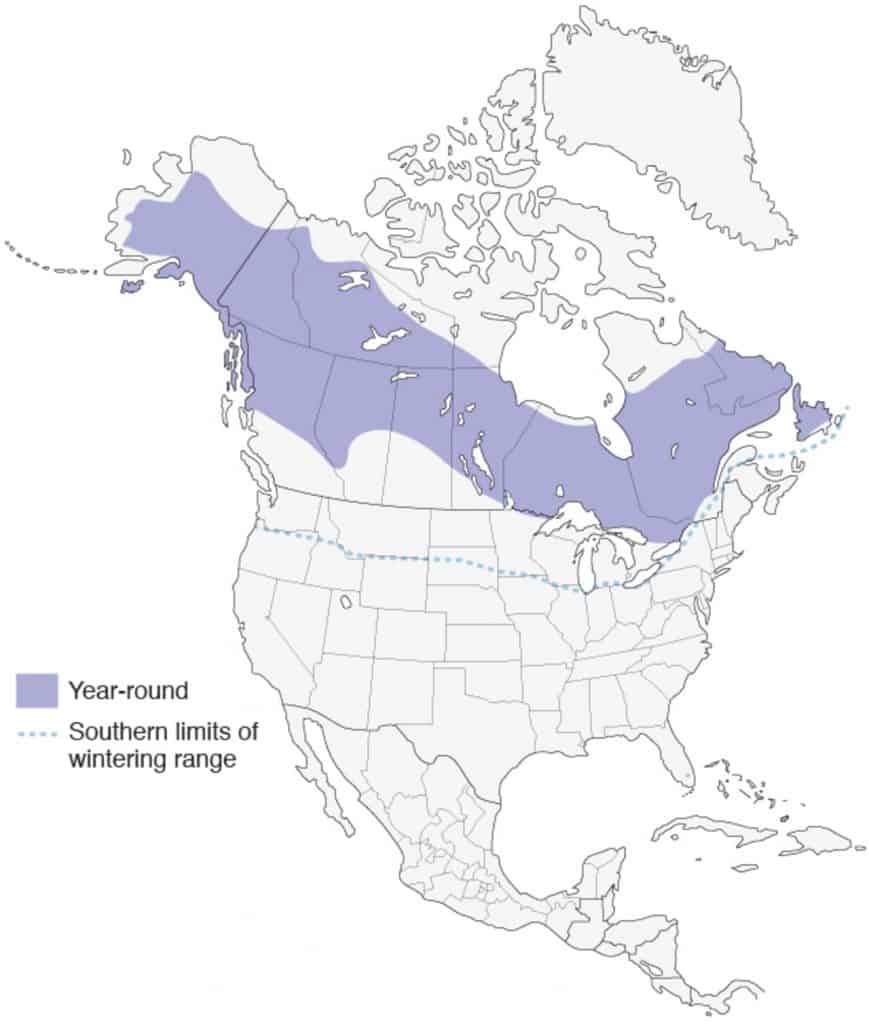
Northern Mockingbird in Winter
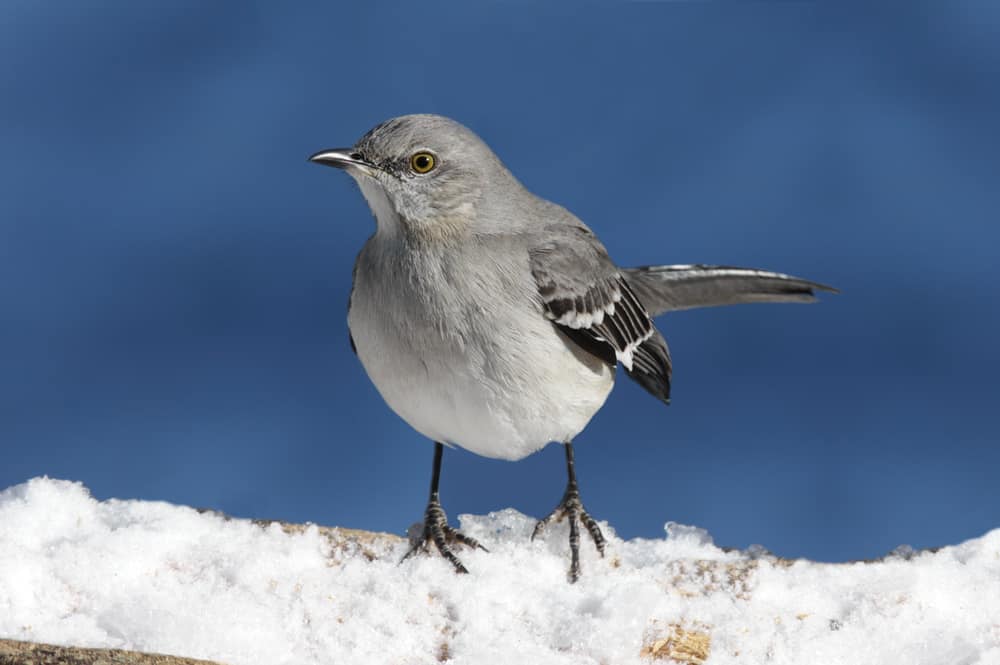
Appearance: Northern mockingbirds are about 10″ long. They have gray above and white below. Wings are dark gray with patches of white. They have long beaks and yellow eyes.
Winter diet: Berries and fruit left on the vines.
Winter feeder food: Suet
Winter habitat: Northern mockingbirds spend winter in their year-round range throughout the US and Mexico. They prefer thickets and brushy areas with open areas nearby.
Range Map
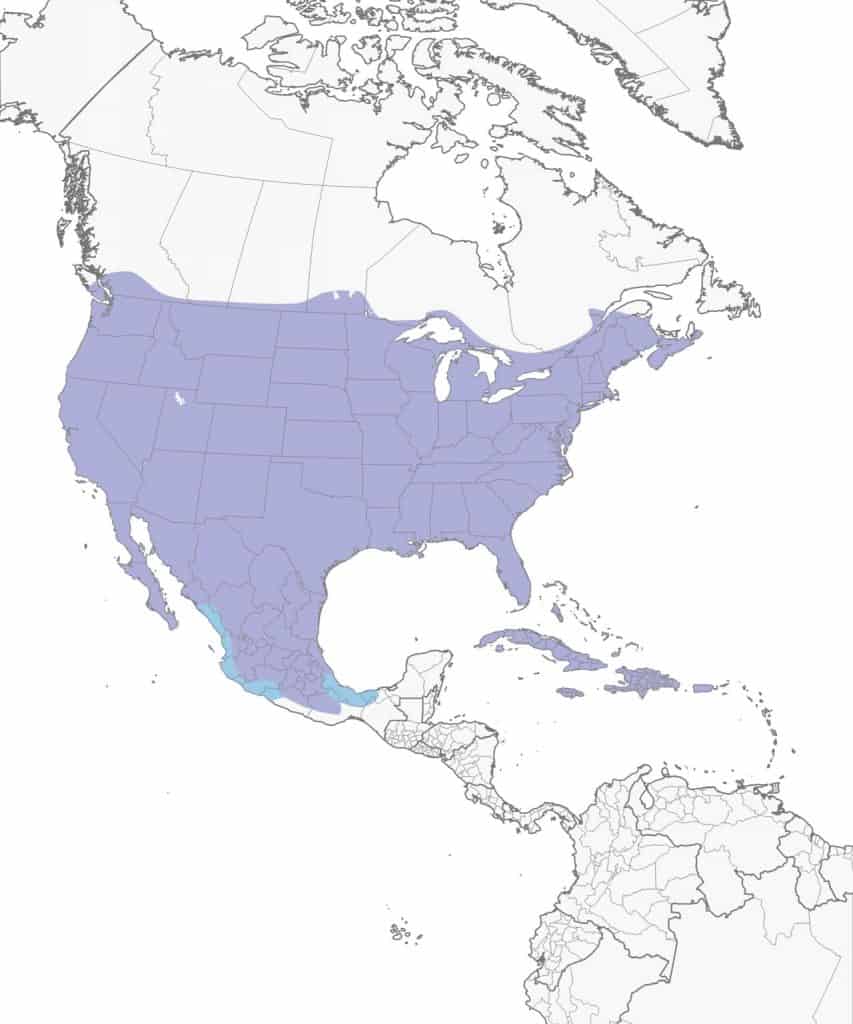
Northern Shrike in Winter
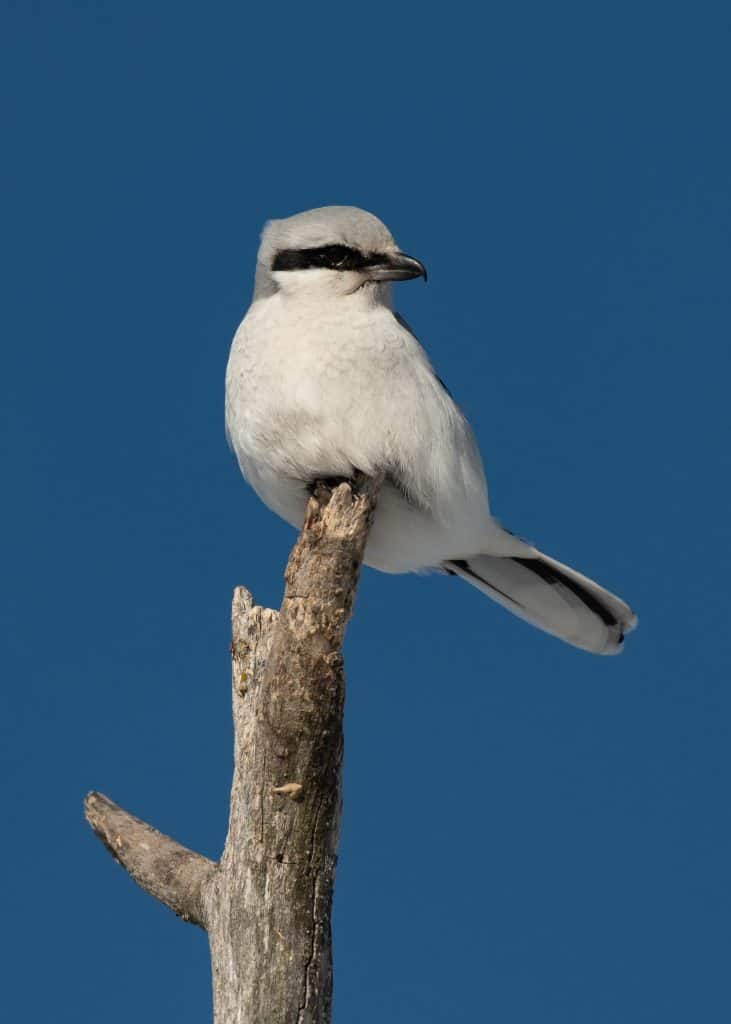
Appearance: Northern shrike is a medium-sized bird about 9.5″ long. They’re gray with white bellies, black wingtips & tails, and a black mask that extends from each eye back to the ear area. Their short bill is notched at the end. Females are the same. Immature northern shrikes are browner.
Winter Diet: Birds, and small mammals.
Winter feeder food: They may show up at the feeder to hunt feeder birds!
Winter habitat: Northern shrikes prefer the northern tundra regions, especially where the thick forest meets the tundra. They also are found in open areas.
Migration: Northern shrikes are migrators. In the winter they migrate south into the northern and western US states, southern Alaska, and Canada’s northern provinces.
Range Map
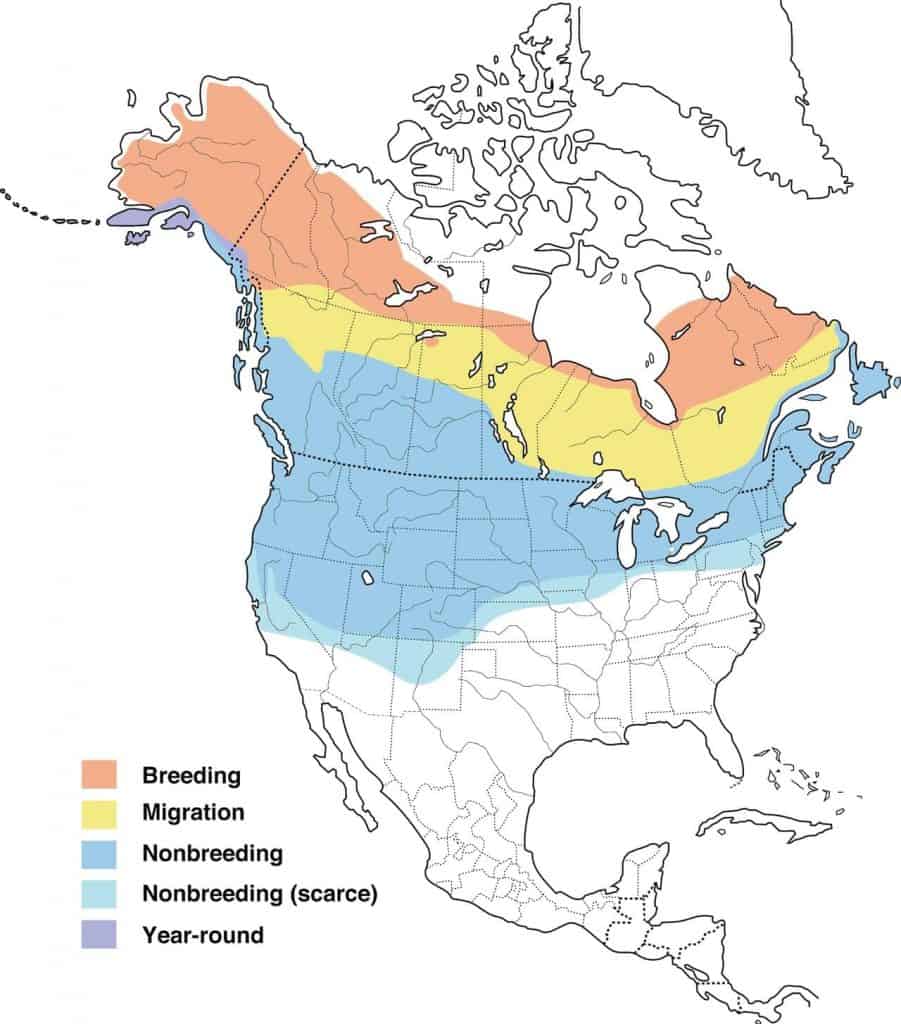
Pileated Woodpecker in Winter
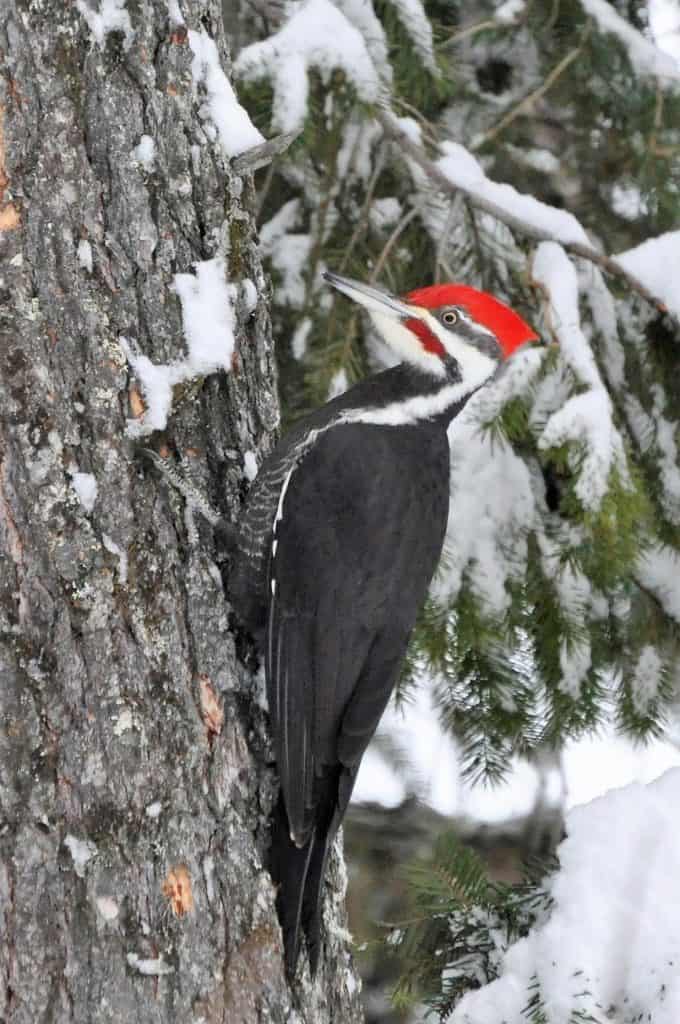
Appearance: A large bird about 19″ in length. They’re mostly black with white stripes on their face and neck with white underwings. The flaming red triangle-shaped crest is unmistakable and the male also has a red stripe on his cheek. The female is the same except her crest does not go all the way to her bill. And, she does not have a red stripe on her cheek.
Winter diet: Insects that they drive out of hibernation from beneath the tree bark – especially carpenter ants.
Winter feeder food: Suet, shelled peanuts, safflower seed, sunflower seed.
Winter habitat: Pileated woodpeckers spend winters in their year-round along the Pacific Northwest coast, the eastern half of the US, and Canada. You can find them in forested and wooded areas that offer tall deciduous (leafy trees like maple & beech), coniferous trees (like evergreen & pine), and lower fruit & nut-bearing trees & shrubs.
Range Map
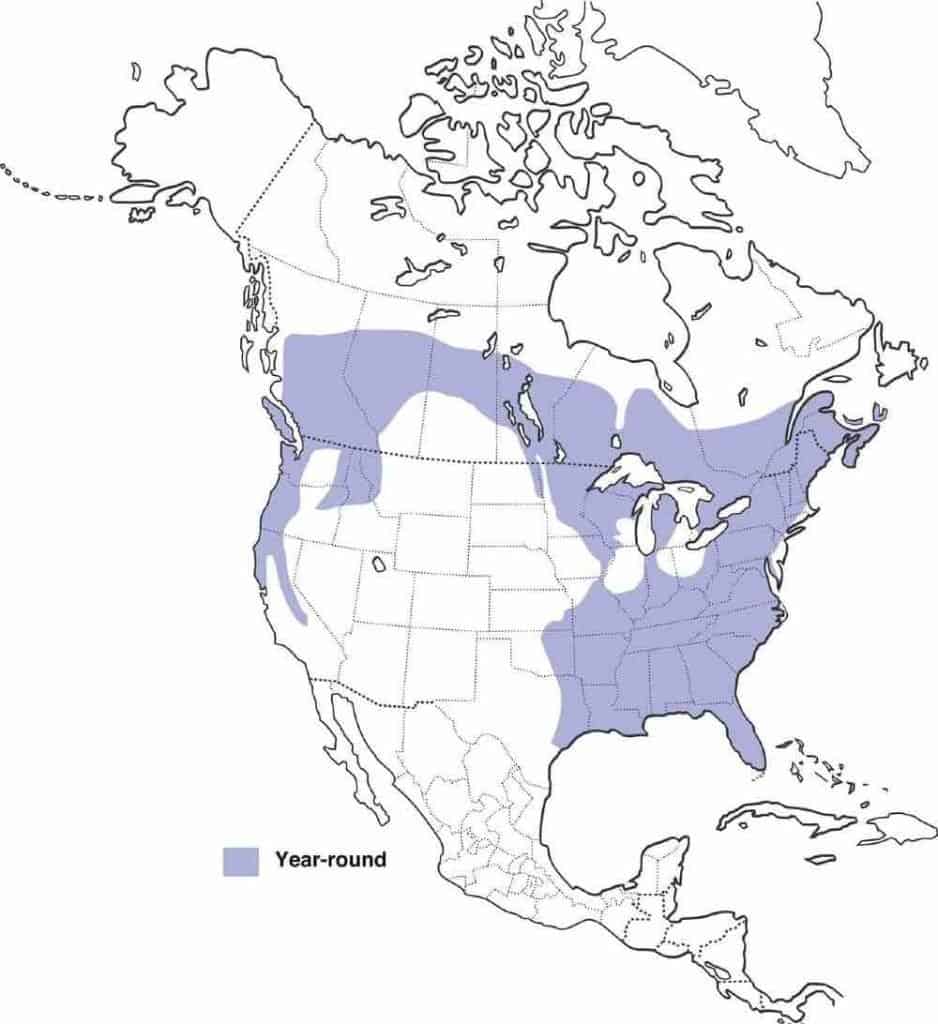
Pine Grosbeak in Winter
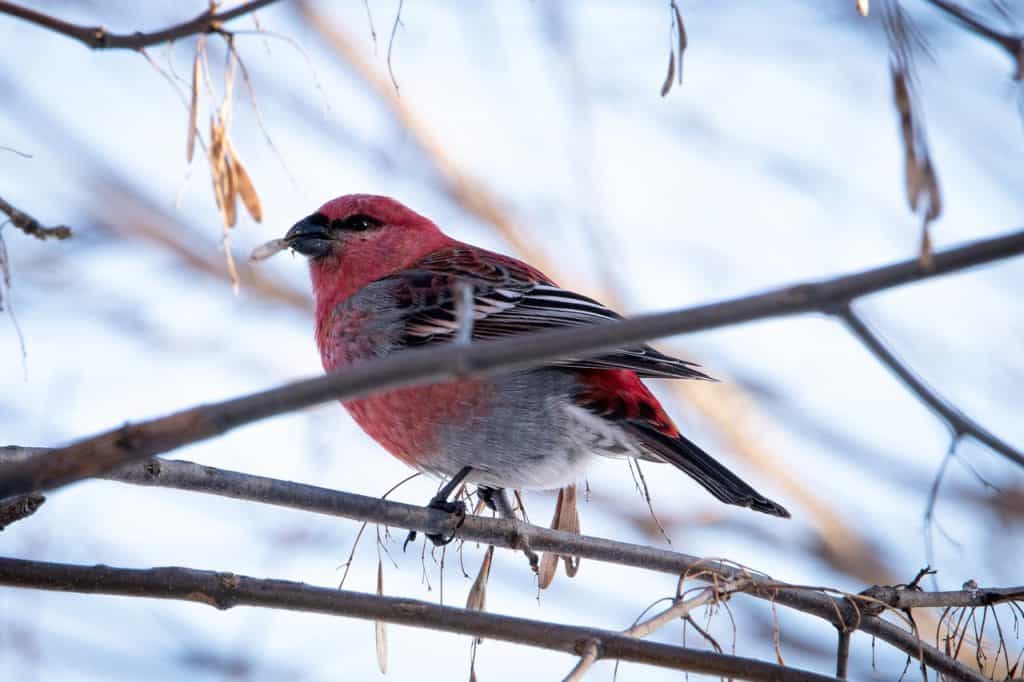
Appearance: The pine grosbeak is a sturdy bird approx 8-10″ long, soft pinkish-red with a gray & charcoal body, short charcoal beak, medium tail with black tip, and wings of black, white, and red. No crown. The Female is gray with a yellow head and tail.
Winter diet: Mostly seeds and fruits from their habitat (pine trees). Sometimes supplements with insects.
Winter feeder food: Black-oil sunflower seeds and suet.
Winter habitat: North American pine grosbeaks spend winter in Canada as well as several northern US states including Montana, North Dakota, Minnesota, Wisconsin, Michigan, Pennsylvania, New York, and New England states. They prefer open areas with coniferous trees and deciduous trees in winter.
Range Map
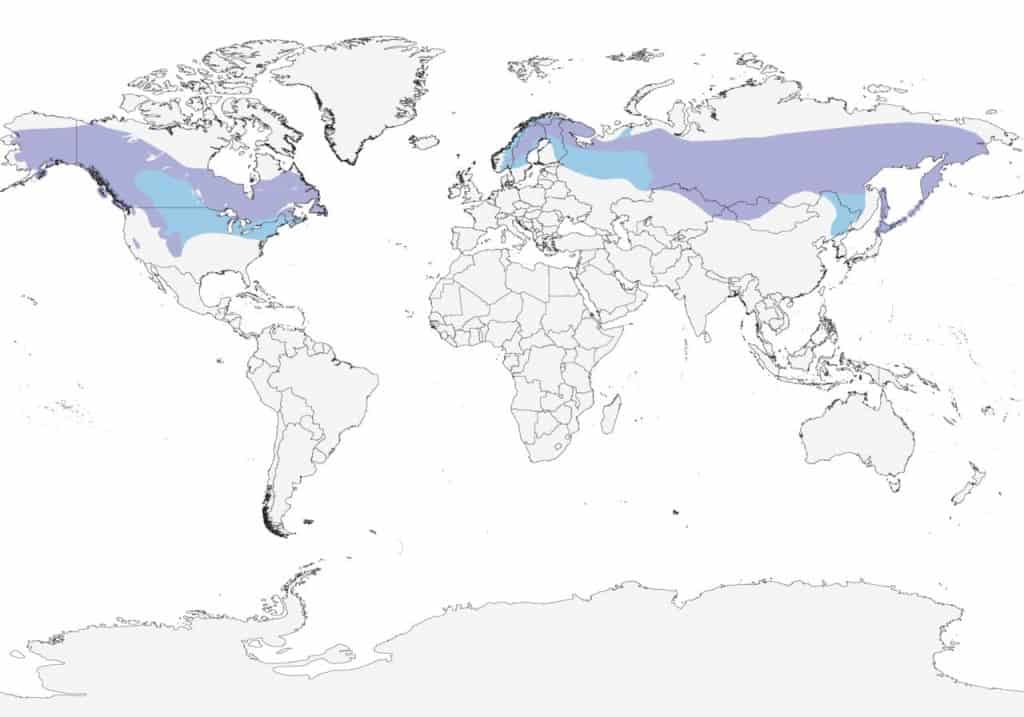
Pine Siskin in Winter
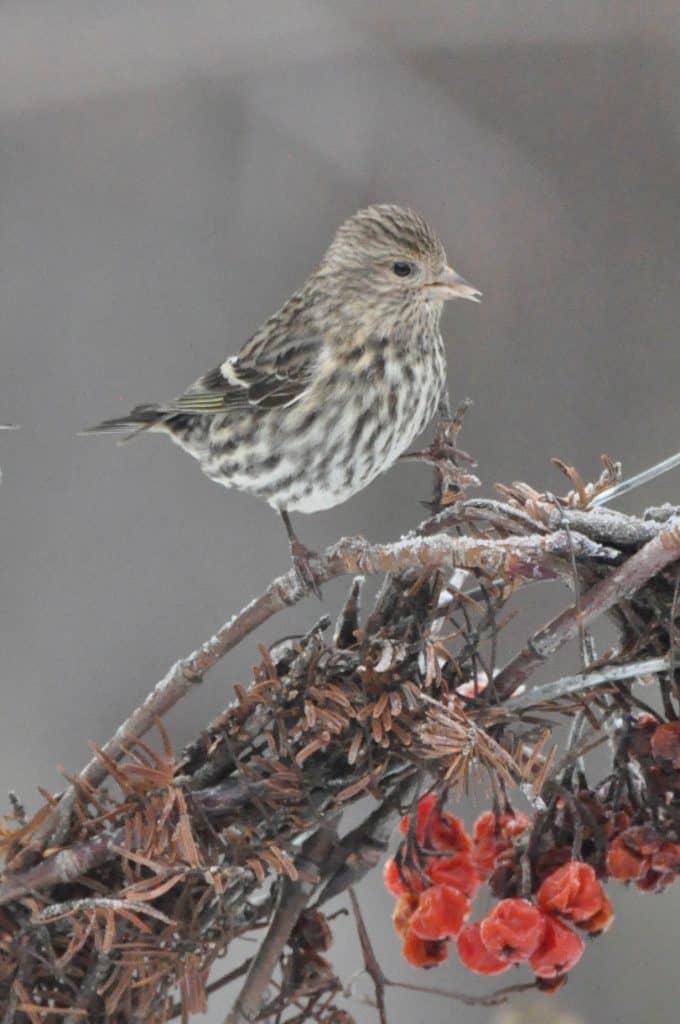
Appearance: The pine siskin is a small brown bird about 5″ long with streaks on the back, breast, and belly. There’s a faint yellow in the wing bars at the end of the tail. The female is similar but has less yellow on the wings and tail.
Winter diet: Seeds.
Winter feeder food: Nyjer, black-oil sunflower seeds, hulled sunflower seeds, and suet.
Winter habitat: Pine siskins expand their range considerably during winter and inhabit all US states, the southern parts of Canada, and even Mexico. They prefer open areas and wooded edges.
Range Map
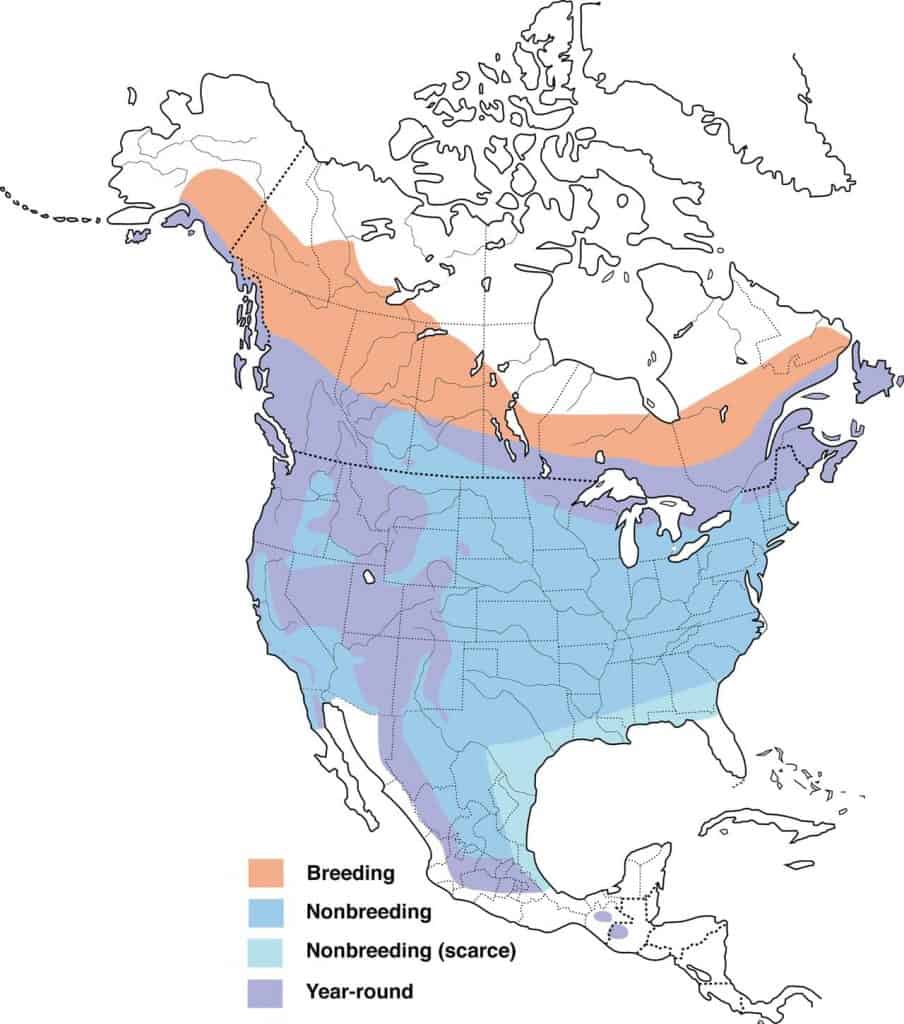
Red Crossbill in Winter
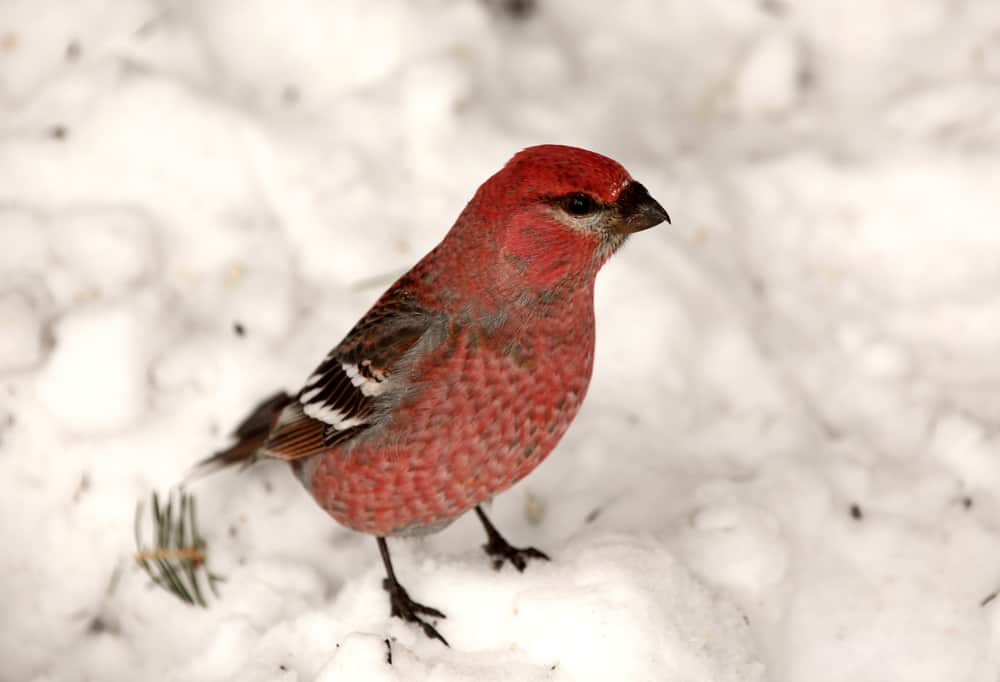
Appearance: The red crossbill is a small bird about 6.2″ long, dark red-orange with brown singes and tail. Their bill is long, pointed, and “crossed”. A brighter color of red on the head and rump. No crown. The female and young are pale yellow and gray.
Winter diet: Seeds – especially those inside pinecones. The bird’s “crossbill” is designed to pry open pinecones to get at the seed inside.
Winter feeder food: Black oil sunflower seed and sometimes thistle.
Winter habitat: Red crossbills either remain in their year-round territory for winter or expand south to create a wide winter range that includes Canada, the Pacific Northwest, states west of the Great Plains, Minnesota, Wisconsin, Michigan, New York, Vermont, Connecticut, and Massachusettes. They prefer mature coniferous forests.
Range Map
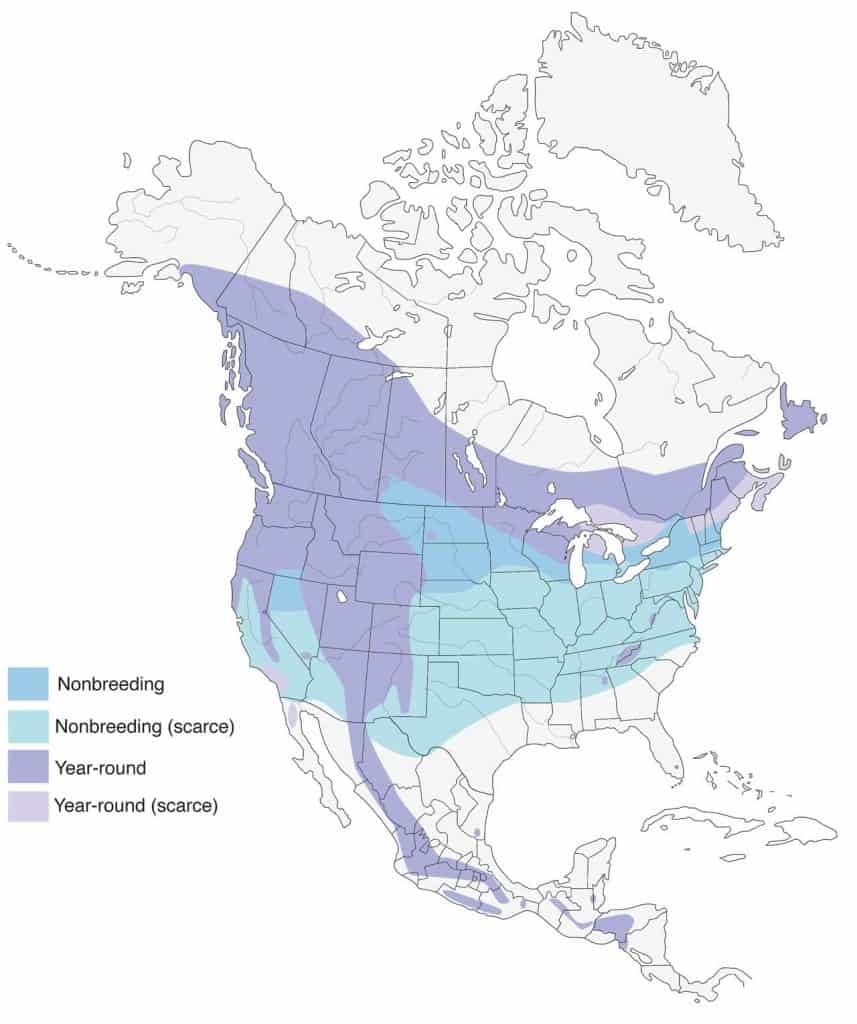
Red-Breasted Nuthatch in Winter
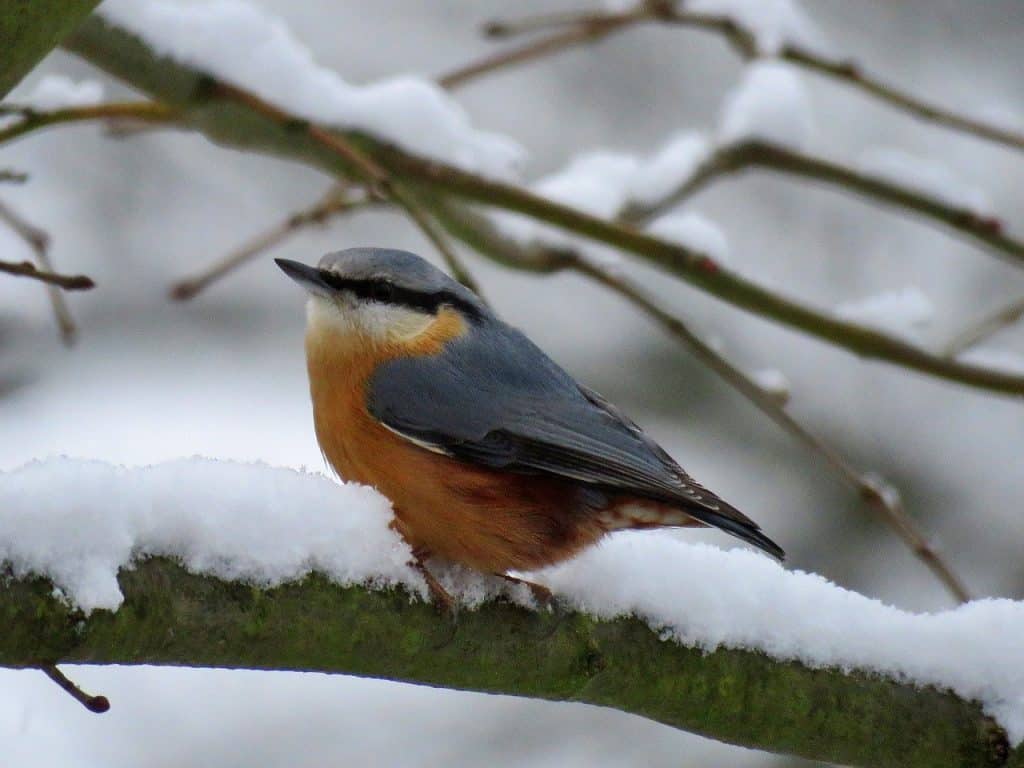
Appearance: Red-breasted nuthatches are about 4.5″ long, have gray/blue backs, white heads with black stripes running over either eye, orange-cinnamon-colored breasts, and a pointy pick-like beak. Females look the same except their underside is a more faded color.
Winter diet: Insects that are hibernating beneath the tree bark.
Winter feeder food: Suet, sunflower seeds, shelled peanuts, fruit.
Winter habitat: Red-breasted nuthatches are found year-round in northern Canada. While some stay there year-round, many migrate south for the winter and can be found in every US state during that time. They’re usually spotted climbing upside-down on a deciduous tree foraging for insects beneath the bark.
Range Map
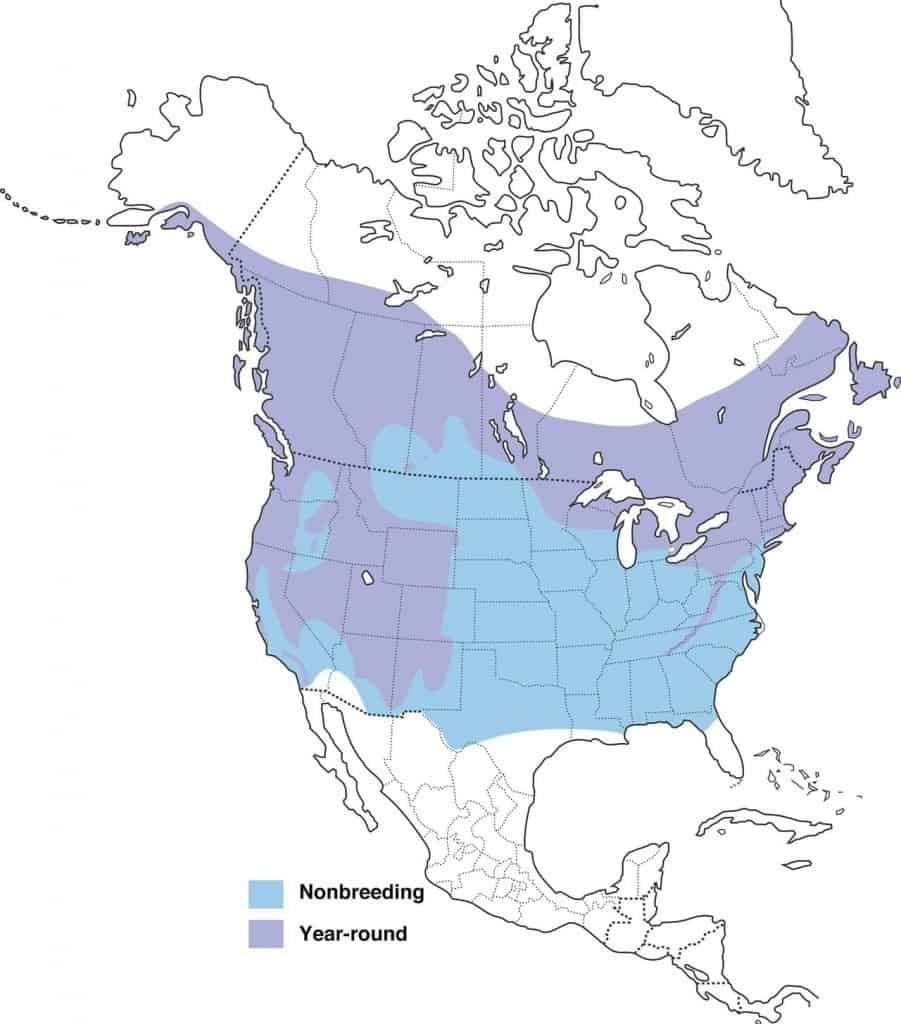
Rock Pigeon in Winter
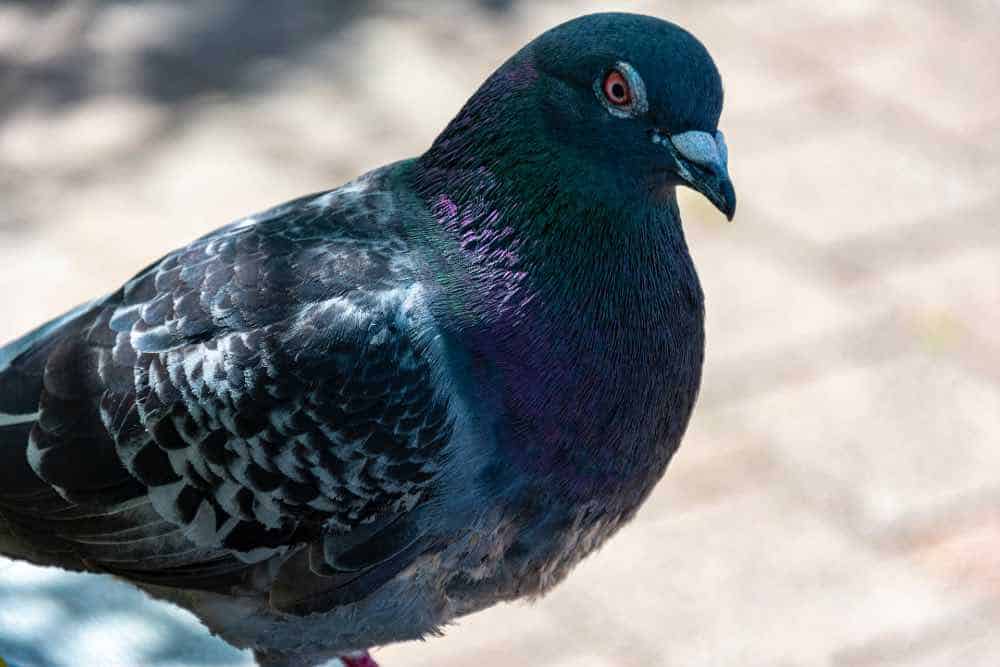
Appearance: The rock pigeon is a large bird about 12-14″ long, chubby with blue/gray wings, black pointy tips, short red legs, and a black & round wide tail. The neck is iridescent.
Winter diet: Grains and seeds. Commonly seen scavenging trash cans for food.
Winter feeder food: Millet, cracked corn, black-oil sunflower seed, safflower, peanut hearts.
Winter habitat: During winter, rock pigeons remain in their year-round range which includes all of the US, the southern part of Canada, and Mexico. They’re commonly found in cities and towns as well as farmlands
Range Map
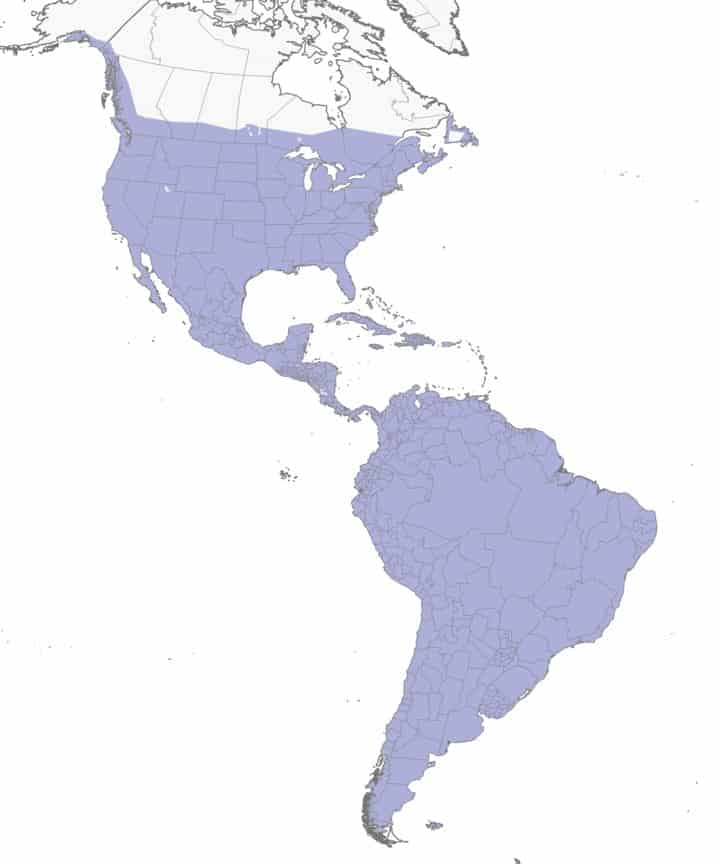
Rough-Legged Hawk in Winter
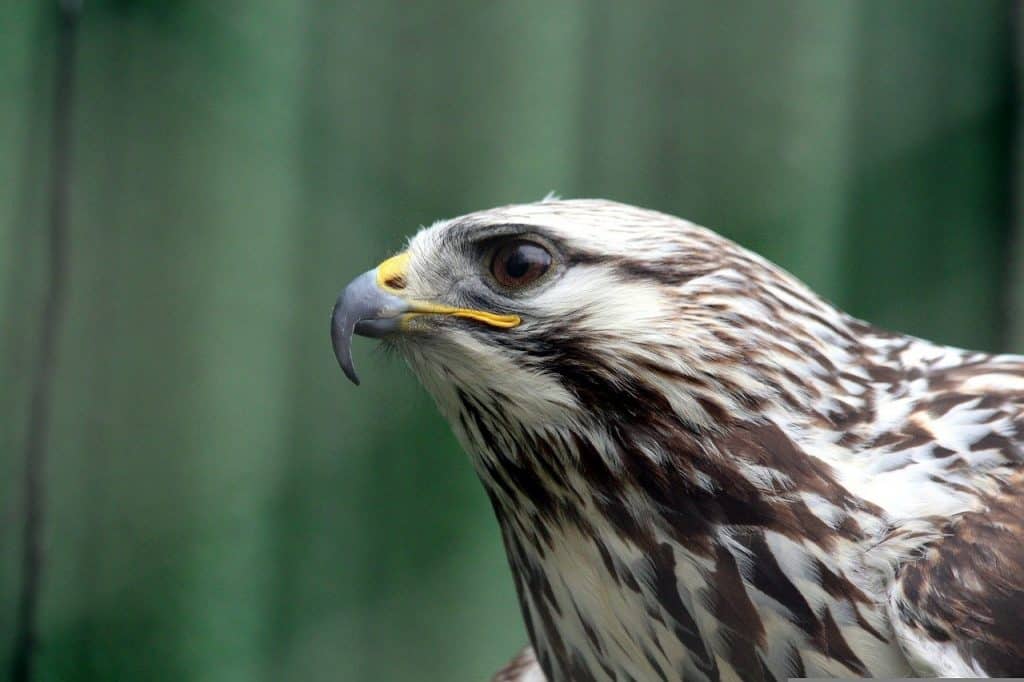
Appearance: The rough-legged hawk is about 19-21″ long and dark brown with white streaks throughout, a dark brown spotted belly, and tails & wings have dark edges. The females are similar but have lighter heads and the belly patch is solid dark brown. There are 2 variations of this bird – a light and a dark.
Winter diet: Small & medium mammals (e.g. voles, rabbits, gophers) and birds.
Winter feeder food: They are not feeder birds.
Winter habitat: Open fields, deserts, and commercial areas with wide open spaces.
Migration: Rough-legged hawks are migrators. In the winter they migrate south into every US state except Tennessee, South Carolina, Georgia, Mississippi, Alabama, Florida, and the southernmost edge of Canada.
Range Map
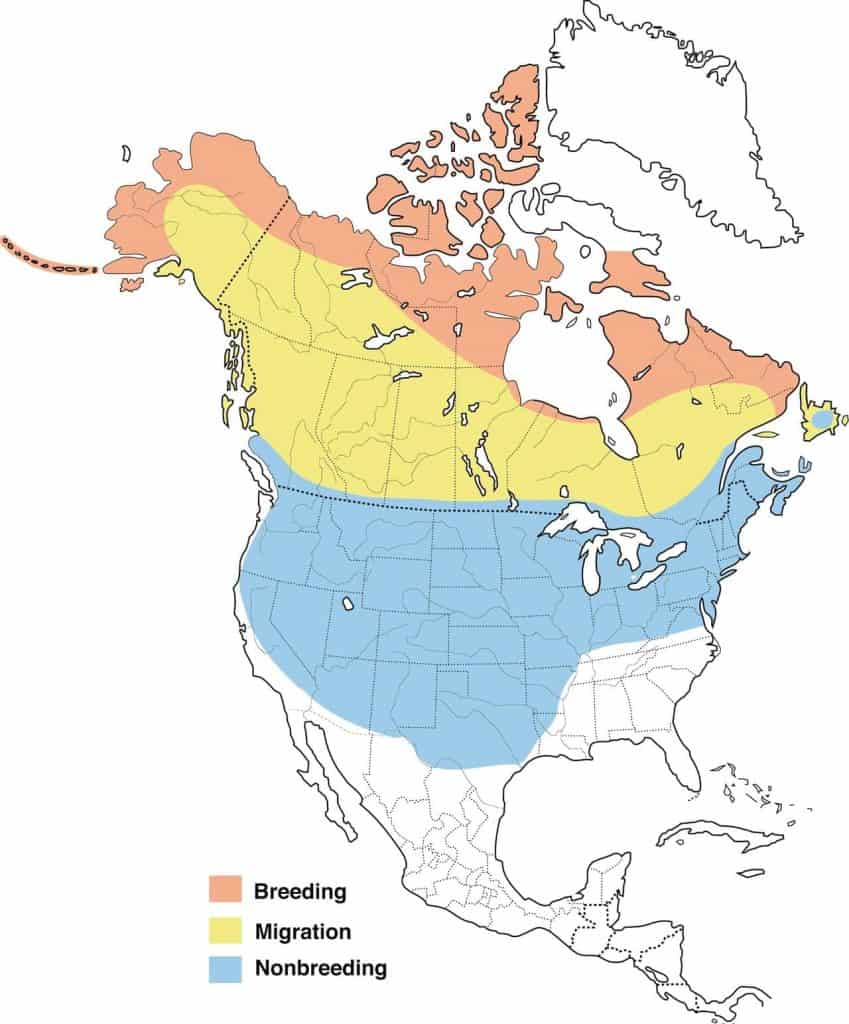
Snow Bunting in Winter
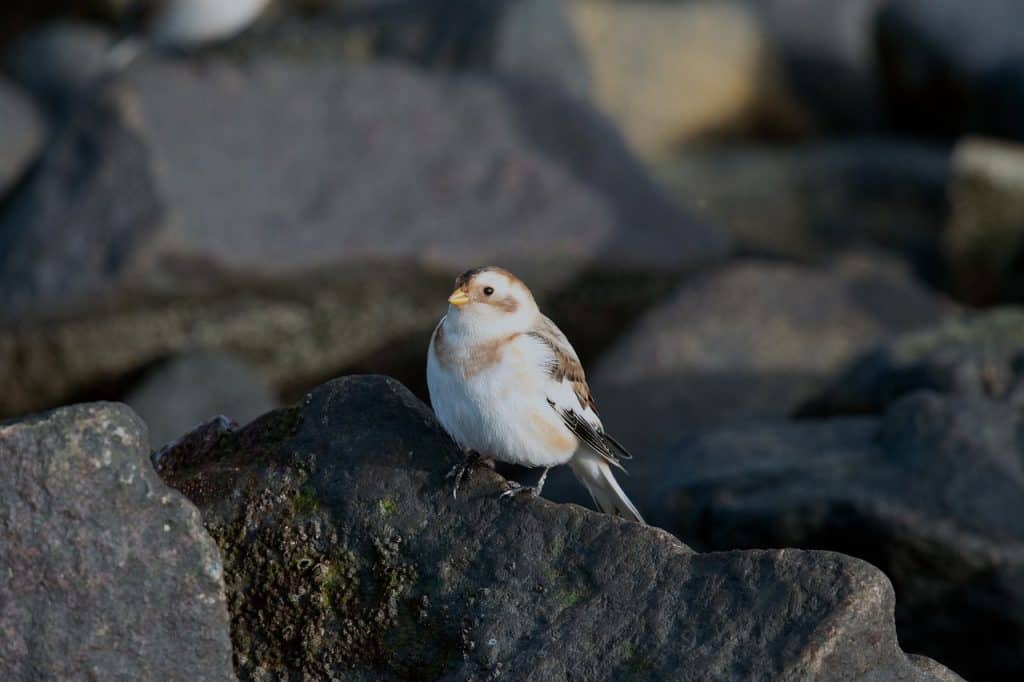
Appearance: Snow buntings are medium-sized birds about 6″ long. They’re all white with black wingtips and a black & white tail, and a short stubby bill. During the non-breeding season, they have rusty patches on the upper areas (crown, ear, and shoulder) as well as dark streaks along the back. Females are similar except their backs are brown and their heads are spotted brown. During the non-breeding season, the females have additional rusty spots on the ears and chest.
Winter diet: Grass, flower seeds.
Winter feeder food: They don’t visit feeders.
Winter habitat: Snow buntings prefer treeless regions in the cold, upper north region of North America. They prefer rocky areas, thick vegetation, and open fields.
Migration: Snow buntings are migrators with a very minute year-round range in western Alaska.
Year-round range: Western coast of Alaska.
Breeding range: Alaska, Northern Canada provinces of the Yukon Territory, Northwest Territories, and Nunavut.
Winter range: US states in the northern half as well as Canada’s British Columbia, Alberta, Saskatchewan, Manitoba, southern Ontario, and southern Quebec.
Range Map
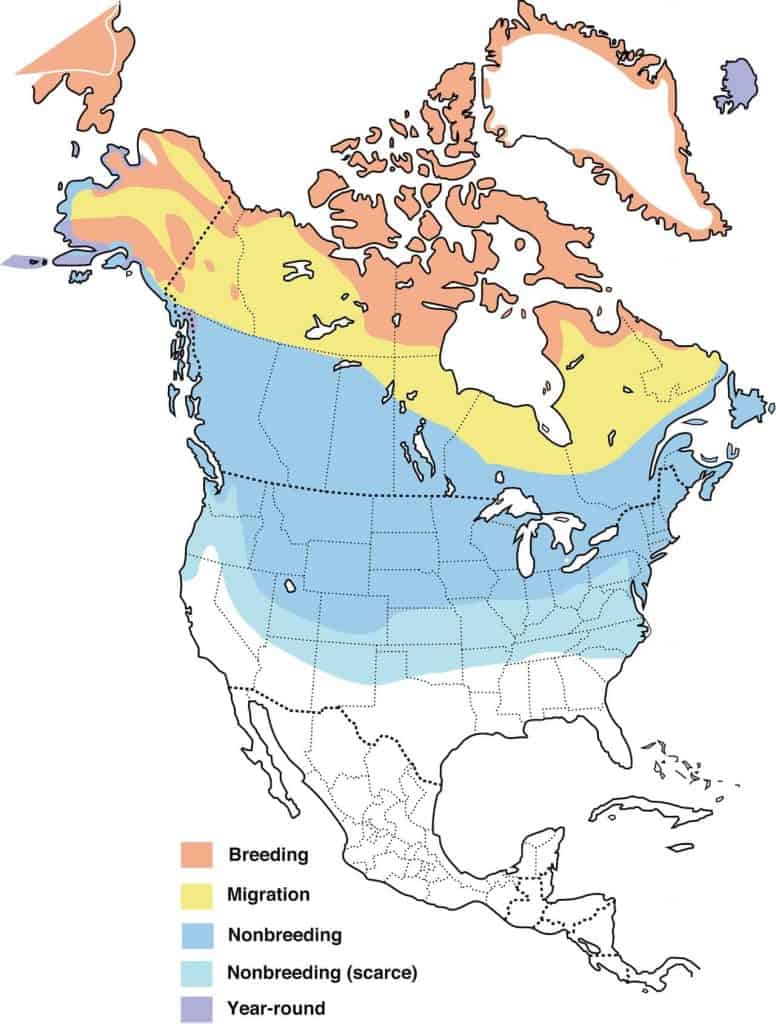
Snowy Owl in Winter
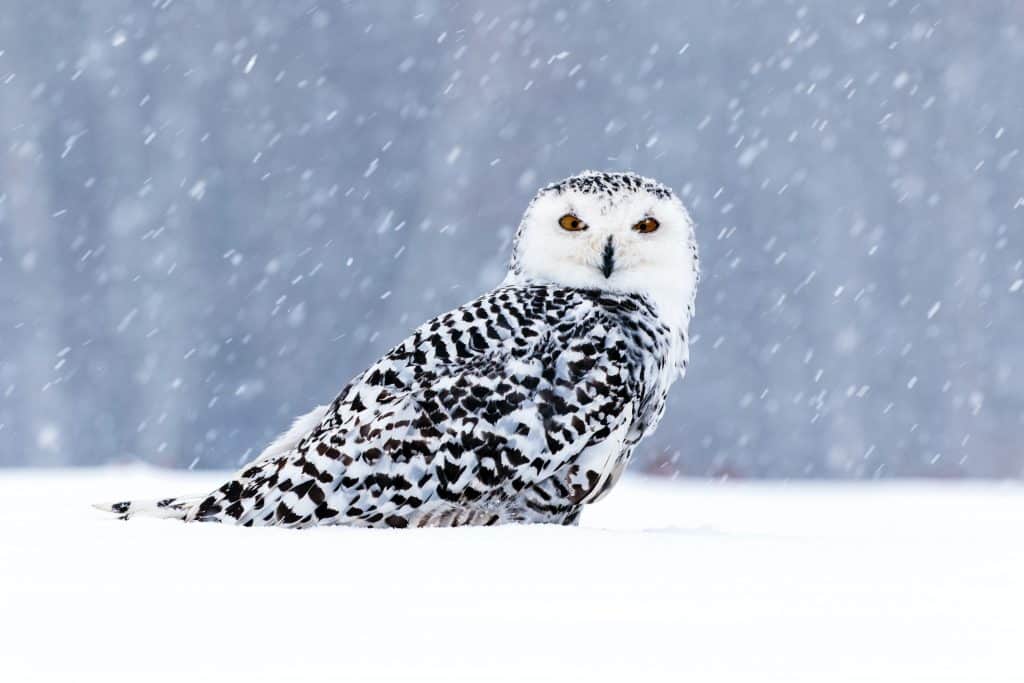
Appearance: Snowy owls are large owls about 20-30″ long with round heads and thick feathering throughout their body. Although much of their body is white they also sport black and brown markings throughout. The males are much whiter than the females.
Winter Diet: Snowy owls will eat a variety of food including lemmings, Arctic hares, mice, ducks, and seabirds. They’ll swallow the smaller prey whole.
Winter feeder food: They do not visit feeders.
Winter habitat: Snowy owls spend winter throughout Canada and a few northern US states including Washington, Idaho, Montana, North Dakota, Minnesota, Wisconsin, Michigan, Ohio, Pennsylvania, New York, and New England. During winter they prefer to be near lake and ocean shorelines but are also seen in farmers’ fields and open areas.
Range Map
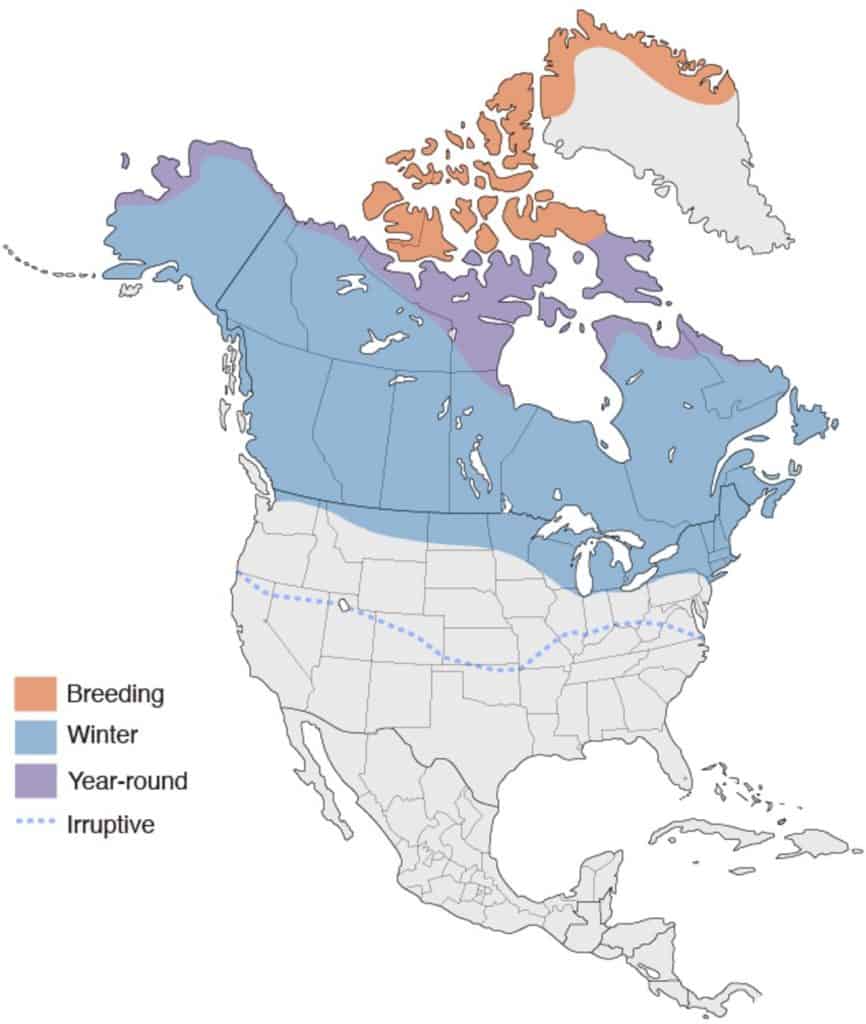
Song Sparrow in Winter
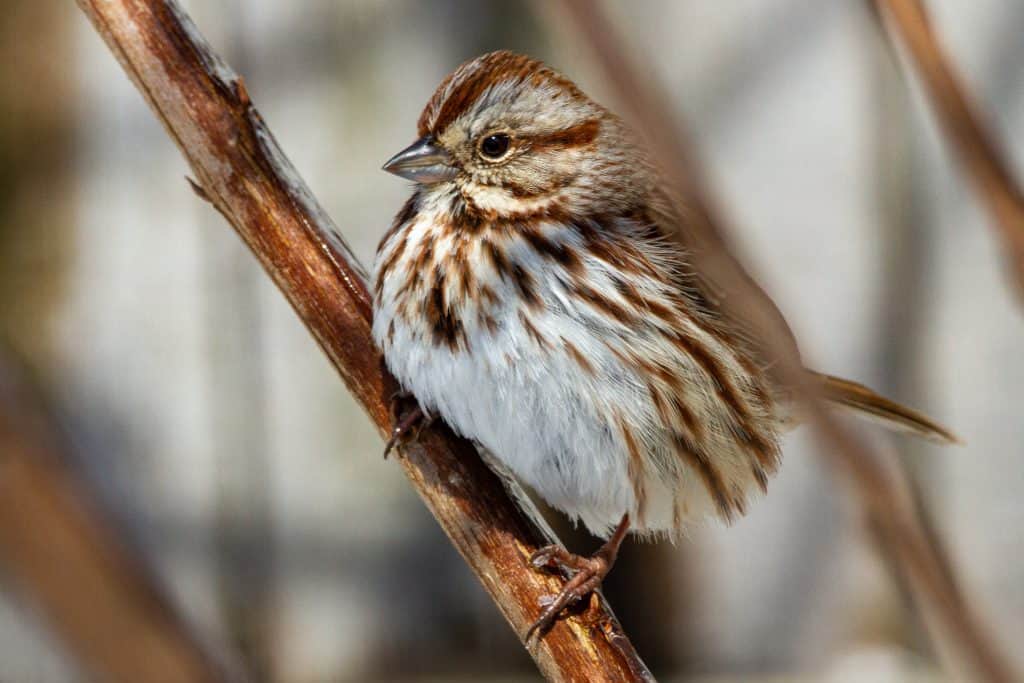
Appearance: Song sparrows are small birds between 5-6″ in length with round heads and varying shades of brown streaks on the chest that converge into a central dark spot. They have dark brown eyes, short stubby beaks, and long, round tails. The females appear the same.
Winter diet: Seeds.
Winter feeder food: Unlikely to visit a feeder.
Winter habitat: Song sparrows are found throughout the US during winter as well as in British Columbia, Canada. They prefer open areas and edges of woodlands.
Range Map
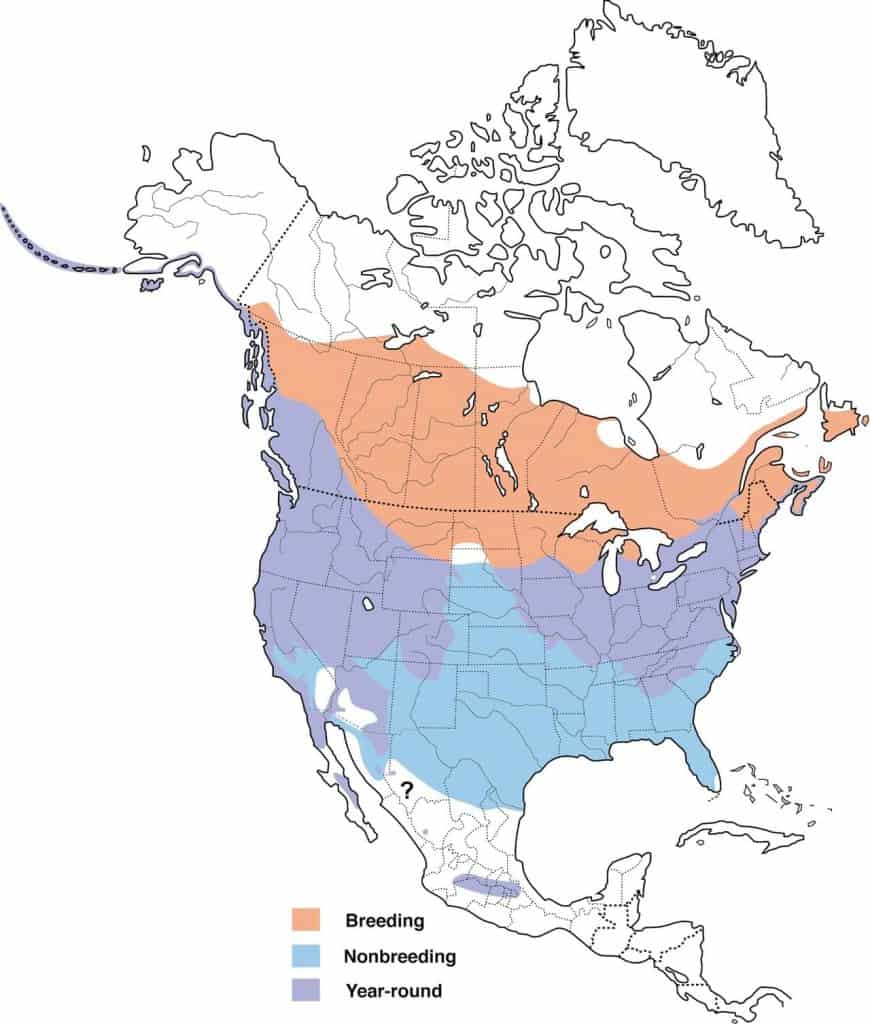
White-Breasted Nuthatch in Winter
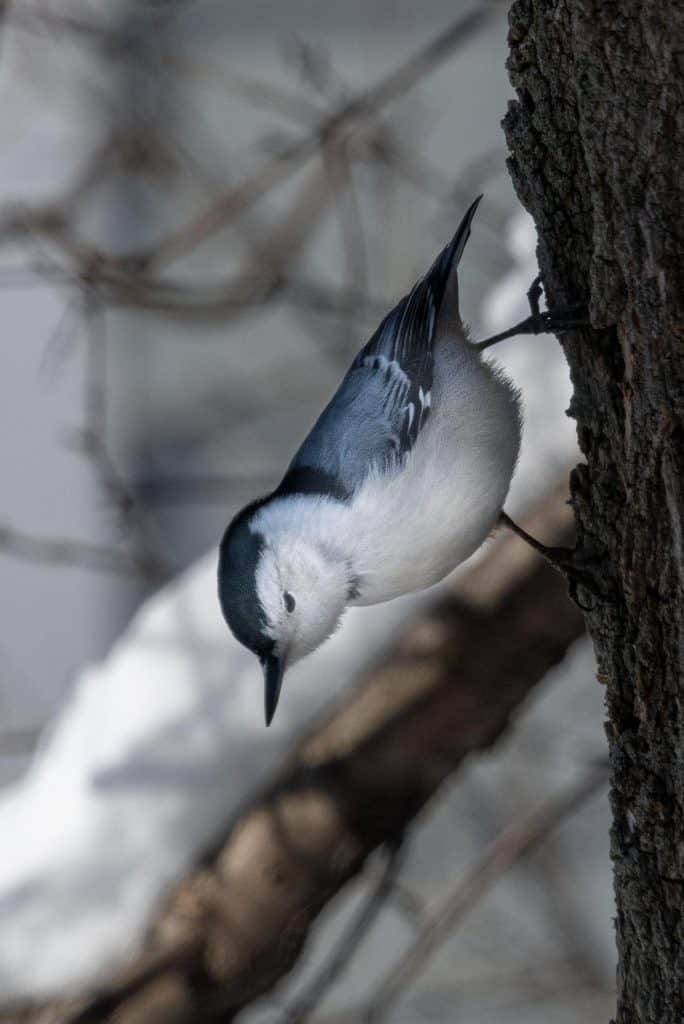
Appearance: The white-breasted nuthatch is a small bird about 5-6″ long with a gray/blue back, white head with a black cap, chestnut under the tail, and a long thin pick-like beak. Females look similar except their cap and neck are gray.
Winter diet: Insects hibernating beneath the bark & seeds.
Winter feeder food: Suet, sunflower seed, shelled peanuts.
Winter habitat: White-breasted nuthatches are year-round birds that do not migrate for winter. They’re found throughout the US and parts of Canada. They prefer mature deciduous and mixed forests; wooded suburban areas such as orchards, parks, and backyards and are usually spotted moving head-first down a tree trunk foraging for insects beneath the bark.
Range Map
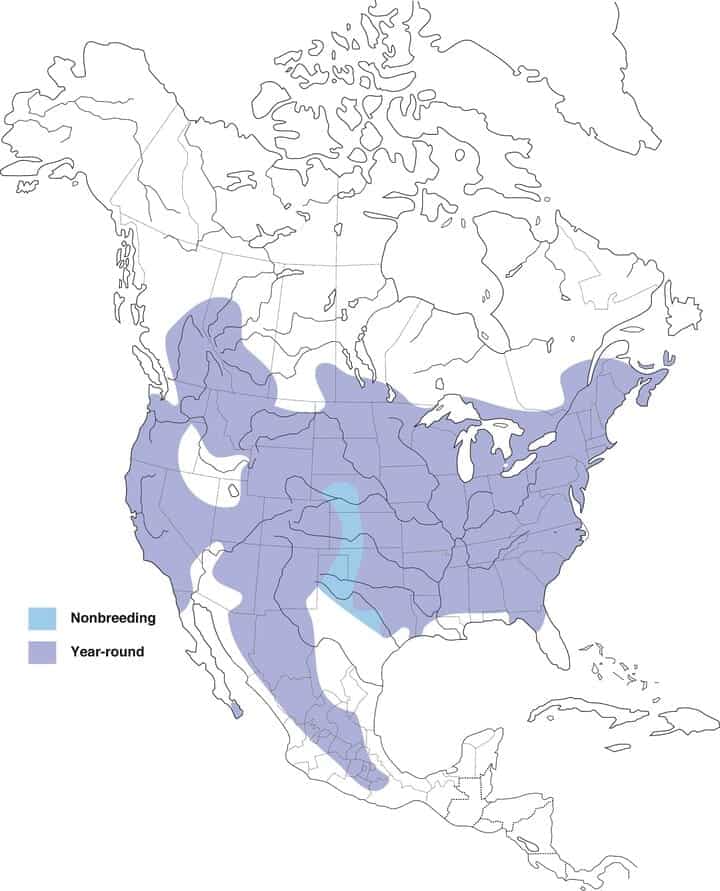
White-Winged Crossbill in Winter
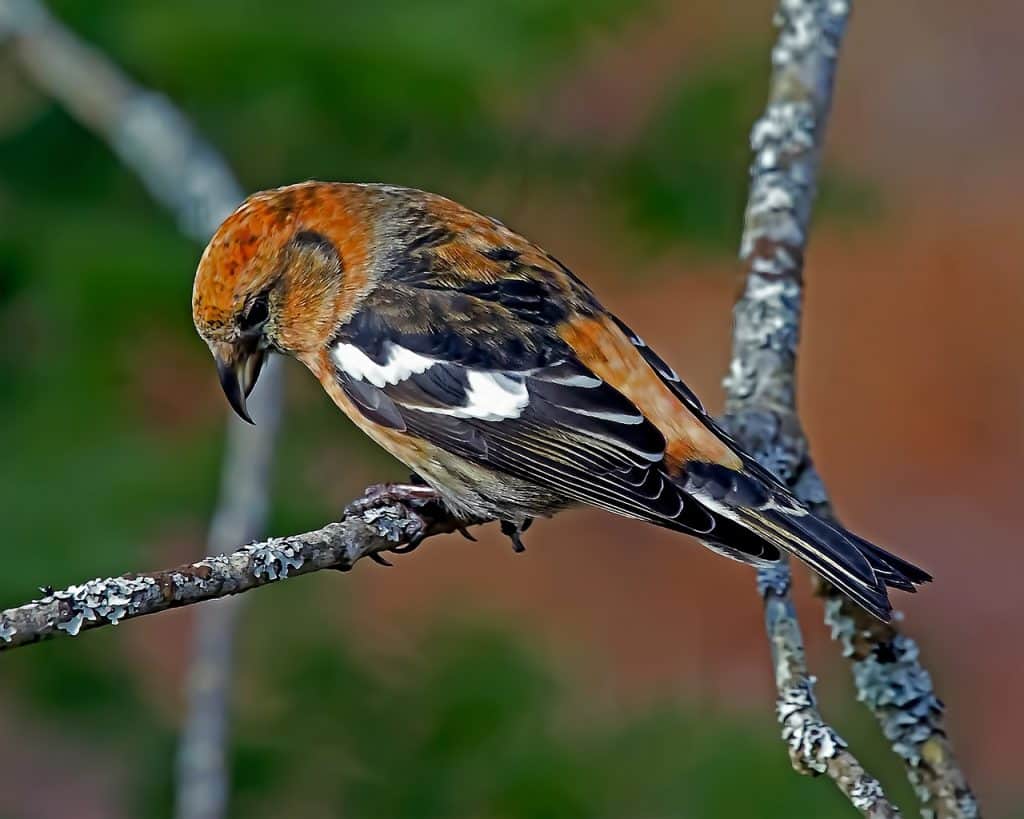
Appearance: The white-winged crossbill is a medium-sized bird about 6″ long with a rosy pink color, black wings & tail, and two white wingbars. The females are similar but they are more yellow rather than rosy-pink. Immature white-winged crossbills are browner and streaked underneath.
Winter diet: Seeds, especially from cones of spruce and tamarack trees (their crossbill is uniquely designed to pry open the cones) but they’ll also eat seeds from other trees including pines, hemlocks, cedar, birch, etc.
Winter feeder food: Unlikely to visit a feeder.
Winter habitat: White-winged crossbills prefer northern regions thickly forested with spruce, hemlocks, and tamarack trees.
Migration: White-winged crossbills do not migrate. However, when their primary food source “cones” become scarce in their year-round range they commonly head further south in search of more.
Year-round range: Alaska, northern Washington, Idaho, Montana, Minnesota, Wisconsin, Michigan & New England, and all Canadian provinces.
Winter range: The year-round range as well as northern Montana, North Dakota, south into Minnesota, Wisconsin, Michigan, and New England.
Range Map
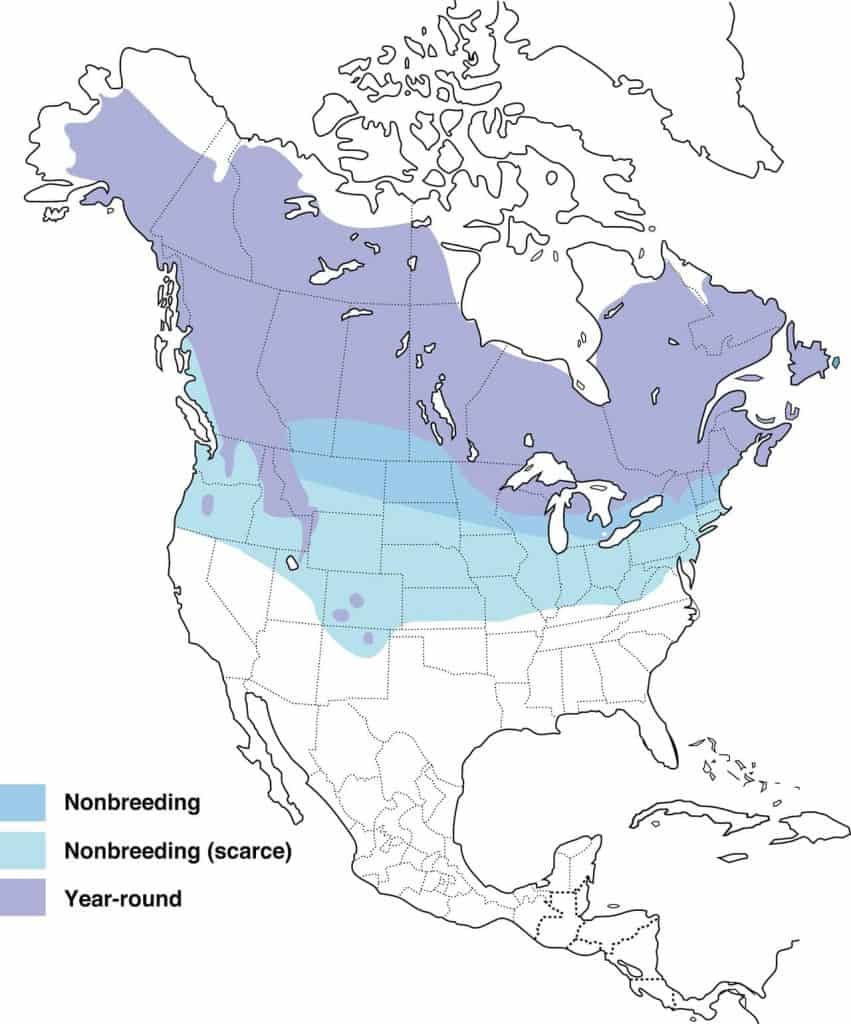
Wild Turkey in Winter
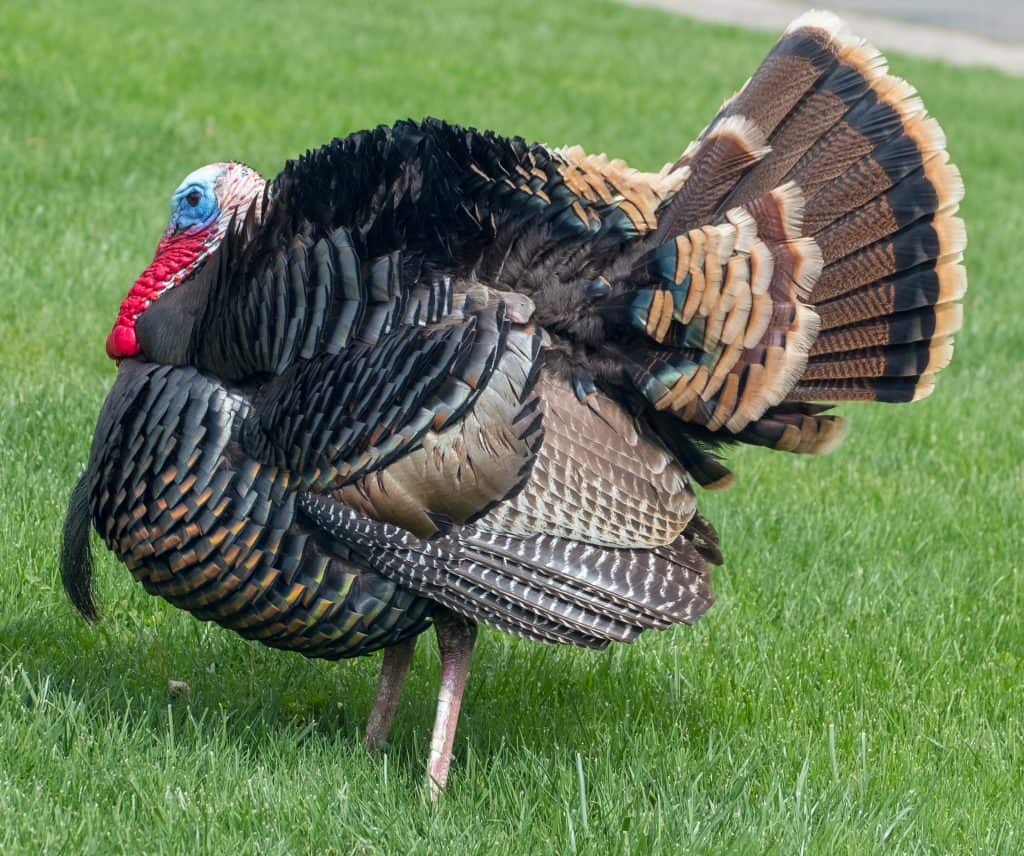
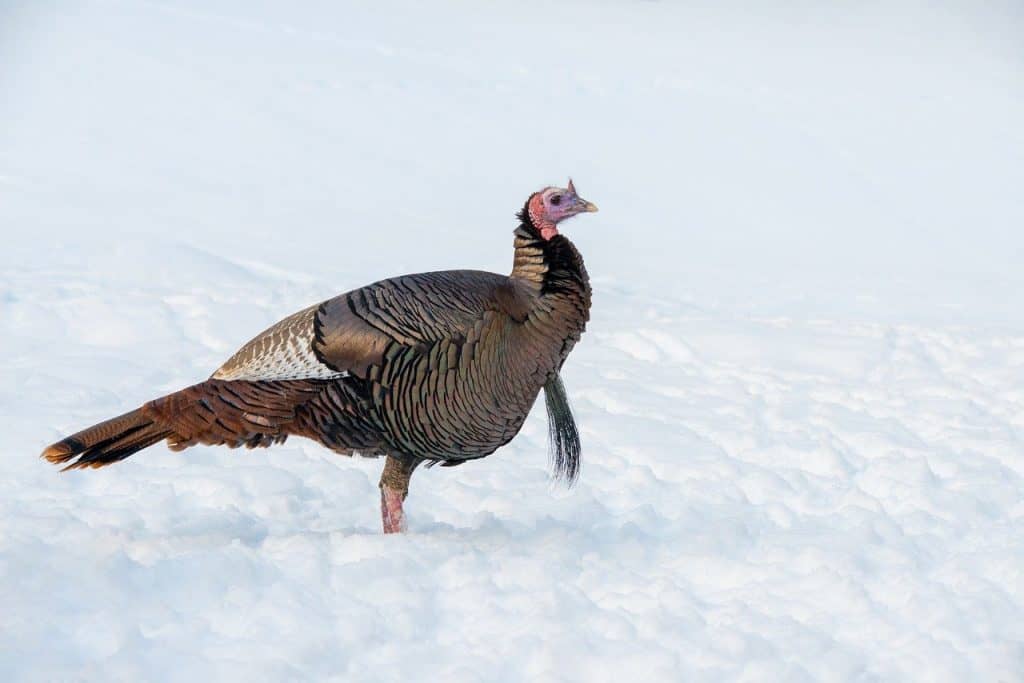
Appearance: Wild turkeys are enormous birds about 45″ long with long necks, large prominent red wattles, and snoods (hanging skin from the neck), and a bronze-greenish iridescence to most of their feathers. The feathers also give the appearance of a variety of textures. Their wings are dark, with white bars and a fanned-out tail with rusty or white tips. Their head and neck show their skin with colors of red, blue, and gray. The red neck is unmistakable. The females are similar but lighter in color, they don’t fan their tail feathers, have subtle-looking wattle and snood, and don’t strut like the males.
Winter diet: Seeds, nuts (acorns, beech nuts, pecans, hickory nuts), and berries.
Winter feeder food: Wild turkeys do not come to feeders.
Winter habitat: During winter, wild turkeys remain in their year-round territory which includes all US states, the southernmost parts of Canada, and even Mexico. They prefer open forested areas, especially those with nut-producing trees. In the southwest, they can be found in open grassy savannahs.
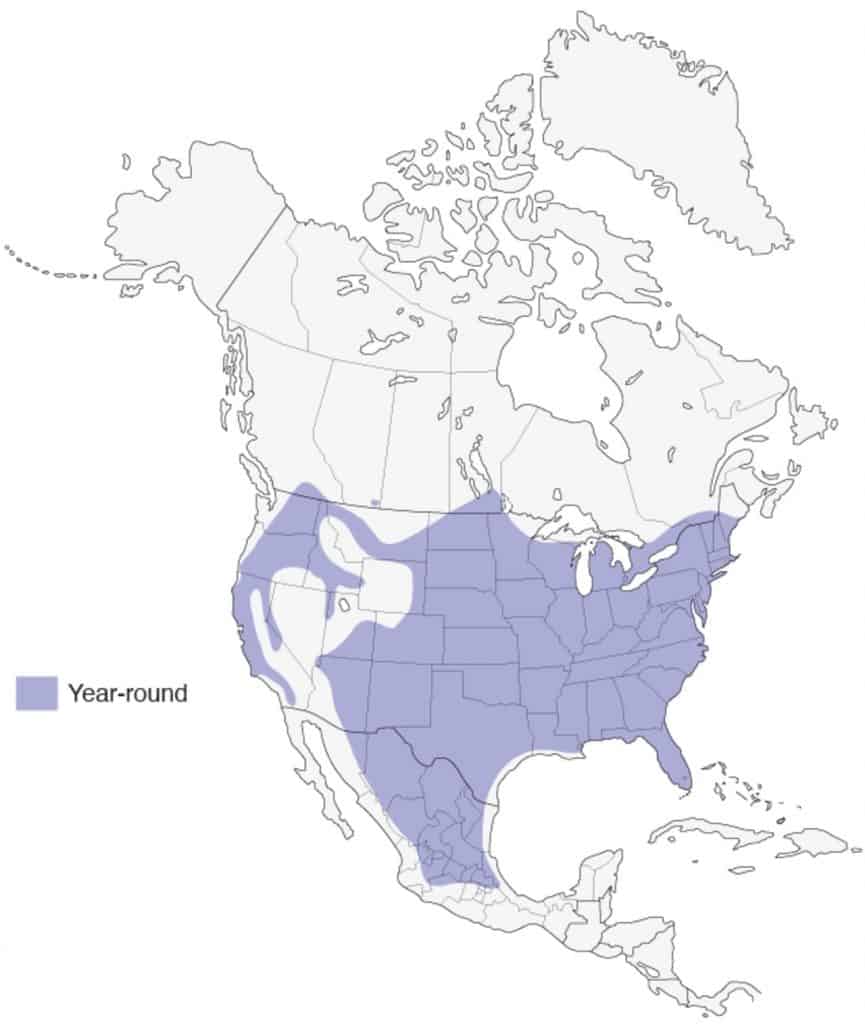
Wood Duck in Winter
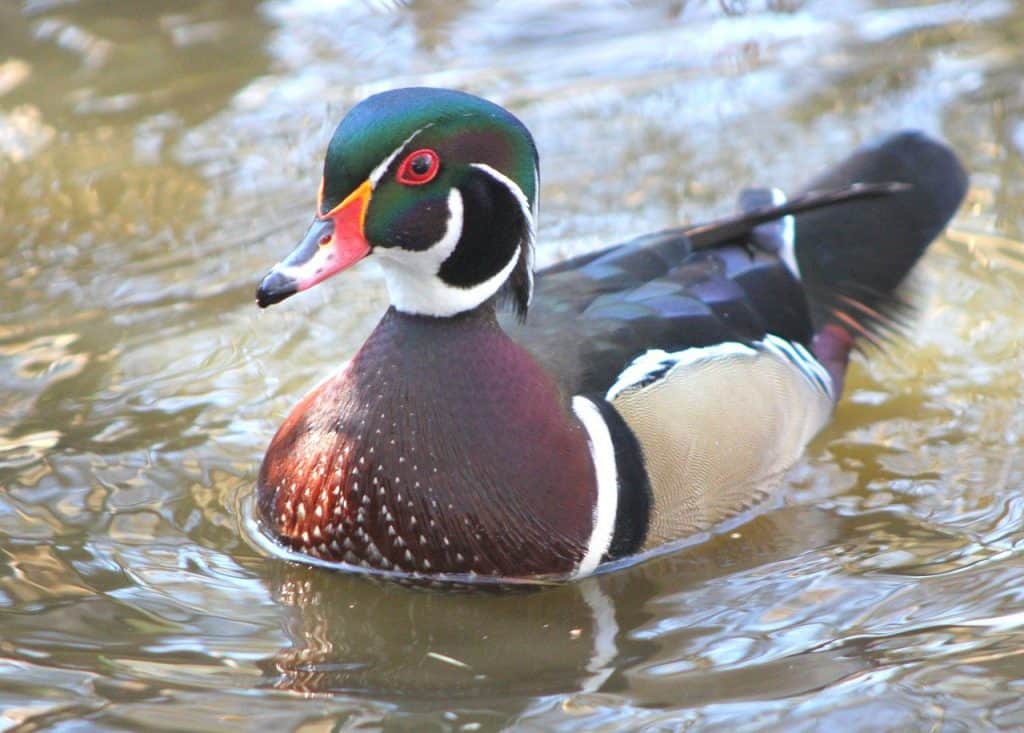
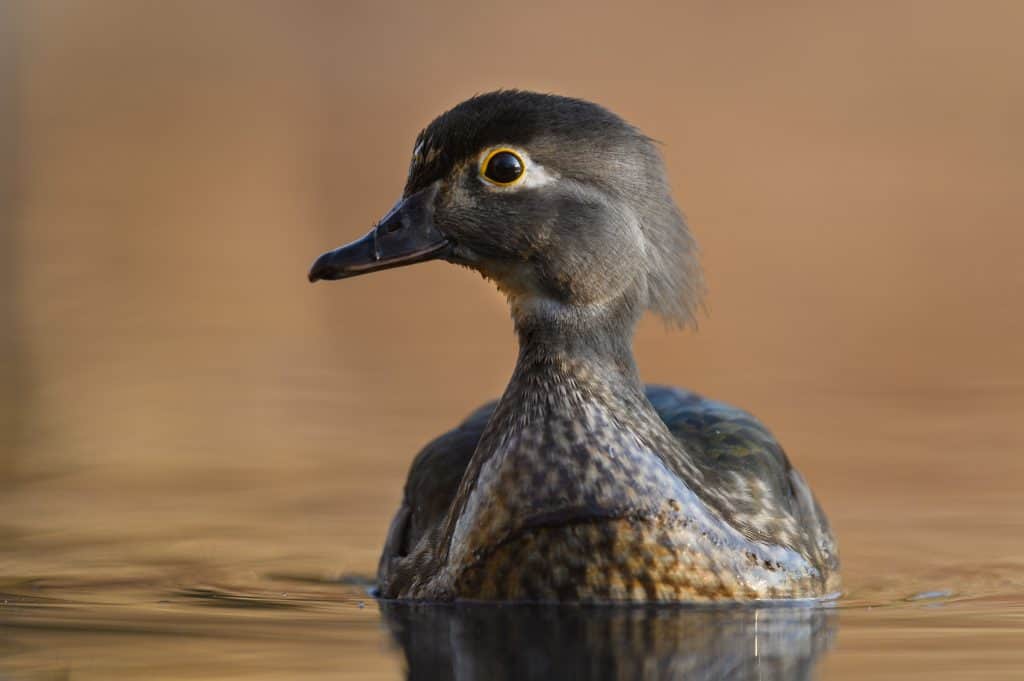
Appearance: The wood duck is a large bird about 19-22″ long and the male sports an array of colors. The male’s head and crest are metallic purplish-green, the sides of the face are black, a white stripe runs along the neck and a smaller one goes up each cheek. Their chest and the rump are dark red, and the sides are olive-yellow with black & white stripes on the edges, the belly is white, tail and back are black. The eyes are red, bill white with red on each side. The top of the bird’s head and crest are metallic purplish-green. The sides of the face are black, and a white stripe runs along the neck. A small white stripe also extends up each cheek. The chest and the rump are dark red, and the sides are a drab yellow with black and white stripes at the edges. The wood duck’s belly is white, its tail and back are black, and its wings are black and blue. The female looks vastly different. She is gray-brown with a white-speckled breast
Winter Diet: During winter, when water plants and insects become scarce, wood ducks will eat seeds, nuts, and grains.
Feeder food: They don’t visit feeders.
Winter habitat: During winter, many wood ducks remain in their year-round range along the pacific coast as well as the easter half of the US. Other wood ducks will migrate further south and inland including the states of Utah, Arizona, New Mexico, Nebraska, Oklahoma, Texas, and Mexico. Wet areas including swamps, marshes, streams & creeks as well as small lakes.
Range Map
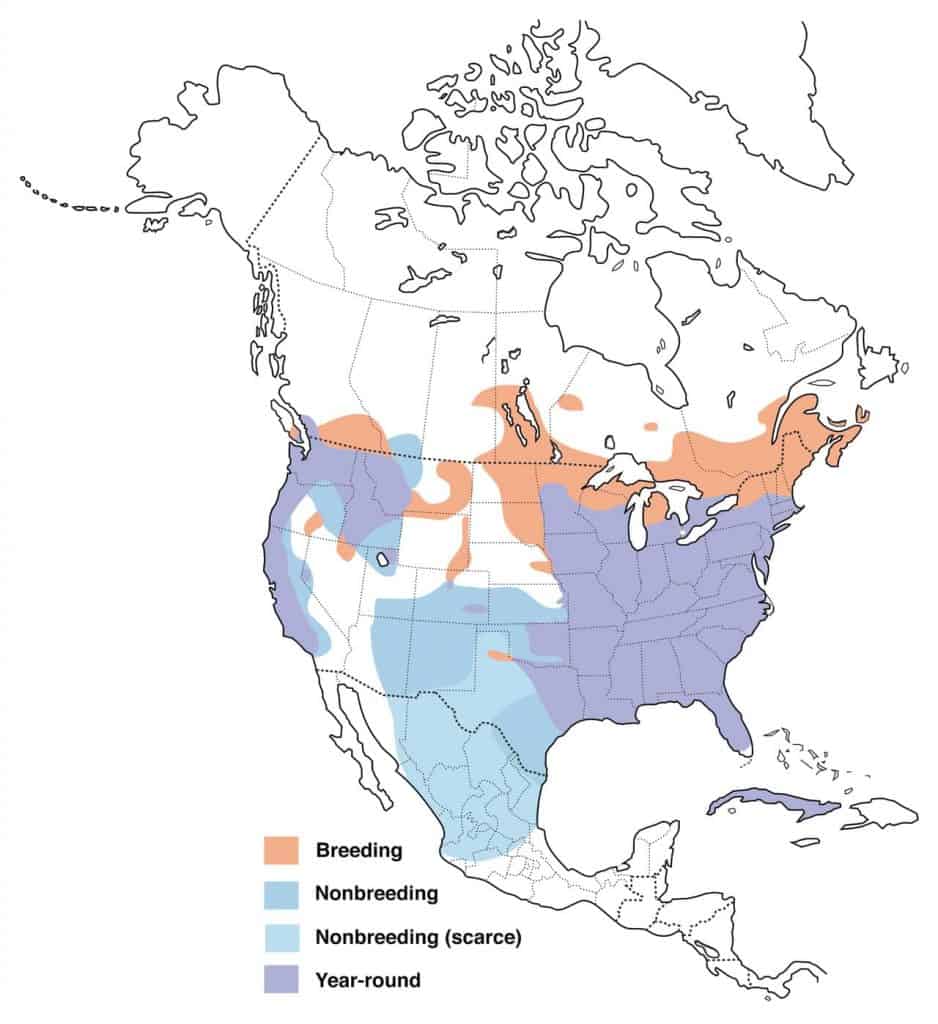
Wrapping Up
While winter in Alberta may seem to last for an eternity, observing the winter birds makes it a bit more bearable. When spring arrives it’s time to say goodbye to the ones that came to visit just for the season and hello again to the migrators returning home to Alberta.
I hope you were able to identify the winter Alberta winter bird you’re interested in or at least learned more about them.
Happy Birding!

